Juliet says:
Wednesday 4th March 2015: . Juliet says:‘Memo to self: must do better with my blog. With my new, all-singing, all-dancing edition of ‘Agincourt’ hitting the bookshelves this autumn, it’s been another of those long periods of nothing but work, work, work. It’s not just a new, updated and revised paperback but also a gloriously illustrated Folio Society edition, both with a splendid new introduction by Bernard Cornwell. And then there’s the paperback of ‘England, Arise’ coming out at the same time too. So all that wiped out the first half of my year, followed by a summer of hospital visiting which is no joke when you live in the Yorkshire Dales and your nearest hospital is nearly 30 miles away – and the nearest major one almost 50 miles away. Driving to and from them down country lanes, takes up half your day – and most of the staff in Middlesborough have absolutely no idea where you live or how long it takes. Which is one of the reasons why were all so keen on supporting the Yorkshire Air Ambulance round here.
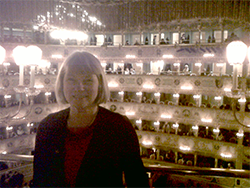 With nothing interesting to report – and being so tired or harassed that I forgot my camera for all the events I did earlier in the year – my blog has been abandoned for the last few months. So I’m going back to one of the few bright spots, five days in Venice at the end of March, my first proper holiday in two and a half years. A blissful few days when the weather wasn’t too hot to prevent us walking miles every day and there were fewer people than in the height of the tourist season. One of the things I love most about Venice is that we always find something we haven’t seen before, despite having been regular visitors for over thirty-five years. Finally, we got to go to the Fenice Opera House – fabulous venue, exquisite singing and brutalist staging which would have shamed an amateur production. Watching Violetta lie dying and writhing on the floor (not even a bed, for goodness sake) was not a highpoint: I had to shut my eyes and just listen.
With nothing interesting to report – and being so tired or harassed that I forgot my camera for all the events I did earlier in the year – my blog has been abandoned for the last few months. So I’m going back to one of the few bright spots, five days in Venice at the end of March, my first proper holiday in two and a half years. A blissful few days when the weather wasn’t too hot to prevent us walking miles every day and there were fewer people than in the height of the tourist season. One of the things I love most about Venice is that we always find something we haven’t seen before, despite having been regular visitors for over thirty-five years. Finally, we got to go to the Fenice Opera House – fabulous venue, exquisite singing and brutalist staging which would have shamed an amateur production. Watching Violetta lie dying and writhing on the floor (not even a bed, for goodness sake) was not a highpoint: I had to shut my eyes and just listen.
But one of the most fascinating discoveries was the seventh pillar of the Doge’s Palace on the Piazzetta side, counting from the Basilica. For the first time I noticed the tragic story unfolding in the series of medieval carvings on the capital (see below). The first four tell a romantic tale of courtship: a young man seeing his beloved for the first time in her window through to their betrothal and first kiss. So far so conventional for a medieval romance – but then reality hits in. The next image portrays the young couple in bed, followed by them delighting over their swaddled baby and then over the fine boy he grows into. But it’s the final carving which really strikes home. It shows the distraught couple grieving by the side of their son’s corpse. The death of a child – an only child – was common enough in those times, but here it is such an unexpected and heart-breaking end to what had appeared to be a typical tale from a medieval romance. Was this simply a morality tale to instruct the people passing below – or was it the stone-mason’s personal tragedy recorded for posterity? Either way, it’s extraordinary to think how many times I must have walked past without noticing it, looking but not seeing, which in itself is a morality tale for our own times.’

.............................................................................................................................................................................................
Wednesday 4th March 2015: . Juliet says:New Years Day,2015 “Last night I dreamt I went to Huddersfield again. It doesn’t quite have the same ring to it as the opening lines of Daphne du Maurier’s Rebecca but nevertheless it happens to be true. Why Huddersfield, I thought, as I struggled to get up this morning? I suspect it’s because it’s been nose to the grindstone again on a daily basis for the last couple of months and my only forays into the not-so-glamorous world of travelling to promote my new book have all been in the West Riding. I say ‘all’ but that’s a slight exaggeration because there’s only been two – one in Huddersfield and one in Keighley – plus today’s lecture in Wakefield Cathedral. And since I was still trying to finish writing that at midnight last night it’s perhaps not surprising that I’ve got confused, at least in my dreams.
 The Huddersfield library event was a surprise on several fronts. First of all, I got myself completely lost trying to follow a map and directions I’d printed out off Google: when I did eventually get there, thanks to asking several people for directions, I realised I should have known exactly how to do so because it was opposite the Town Hall where I’ve been many times, not least to hear the Huddersfield Choral Society perform Handel’s Messiah. Walking back to the station took a quarter of the time it had taken me to get to the library.
The Huddersfield library event was a surprise on several fronts. First of all, I got myself completely lost trying to follow a map and directions I’d printed out off Google: when I did eventually get there, thanks to asking several people for directions, I realised I should have known exactly how to do so because it was opposite the Town Hall where I’ve been many times, not least to hear the Huddersfield Choral Society perform Handel’s Messiah. Walking back to the station took a quarter of the time it had taken me to get to the library.
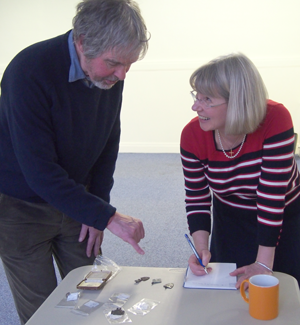 The event too was a surprise: it was a lovely day and yet the good people of Huddersfield had crowded in to hear a talk about the Great Revolt – so much so that the room was filled to capacity. Yet another unexpected bonus was to be shown an extraordinary selection of medieval harness pendants, collected by David Harpin (pictured left). I have to confess I’d never seen a harness pendant before, though I was aware that medieval knights often fixed bells and little medallions of their coats of arms to their horses’ harnesses. Made of copper alloy and painted, gilded or enamelled according to the wealth or fancy of their owner, what’s particularly intriguing about them is their personal nature: where coats of arms were used we can identify to whom they originally belonged. In the photograph you can see three thirteenth century examples: left to right, those of the Courtenay earls of Devon, the Berkeley family and Aymer de Valence.
The event too was a surprise: it was a lovely day and yet the good people of Huddersfield had crowded in to hear a talk about the Great Revolt – so much so that the room was filled to capacity. Yet another unexpected bonus was to be shown an extraordinary selection of medieval harness pendants, collected by David Harpin (pictured left). I have to confess I’d never seen a harness pendant before, though I was aware that medieval knights often fixed bells and little medallions of their coats of arms to their horses’ harnesses. Made of copper alloy and painted, gilded or enamelled according to the wealth or fancy of their owner, what’s particularly intriguing about them is their personal nature: where coats of arms were used we can identify to whom they originally belonged. In the photograph you can see three thirteenth century examples: left to right, those of the Courtenay earls of Devon, the Berkeley family and Aymer de Valence.
Sadly no one turned up with any objects half as exciting at the Keighley library event but it was a great pleasure to meet Sue and Paul Skinner again after a gap of more than twenty-five years.  Sue was the researcher for the ‘Take a Place Like ...’ series of programmes which I co-presented for BBC Radio 4 with Stanley Ellis, the languages expert, and John Grundy, the architectural historian (I was just the boring ordinary historian, nothing ‘architectural’ about me!) The programmes were an absolute joy to make: discovering new places, meeting extraordinary people, doing things that were completely outside my experience and most of all, just enjoying the company of Stanley, John and our producer Geoff Sargieson and our sound recordist Graham Aldous. Sue and Paul were among sixty-five people who gave up their Saturday afternoon to come to hear my talk on the Great Revolt – striking evidence, just as in Huddersfield, of the real hunger there is for such events and the vital role that our public libraries play in making them available to the general public.”
Sue was the researcher for the ‘Take a Place Like ...’ series of programmes which I co-presented for BBC Radio 4 with Stanley Ellis, the languages expert, and John Grundy, the architectural historian (I was just the boring ordinary historian, nothing ‘architectural’ about me!) The programmes were an absolute joy to make: discovering new places, meeting extraordinary people, doing things that were completely outside my experience and most of all, just enjoying the company of Stanley, John and our producer Geoff Sargieson and our sound recordist Graham Aldous. Sue and Paul were among sixty-five people who gave up their Saturday afternoon to come to hear my talk on the Great Revolt – striking evidence, just as in Huddersfield, of the real hunger there is for such events and the vital role that our public libraries play in making them available to the general public.”
.............................................................................................................................................................................................
Monday 5th January 2015: . Juliet says:New Years Day,2015 “Well, that ‘Work in Progress’ sign has been hanging on my study door for much longer than I expected! It seems unbelievable to me that it’s now a shameful twenty-two months since I last wrote a blog. For most of that time I was chained to my desk writing England, Arise, my new book on the Peasants’ Revolt of 1381, and watching the seasons pass by through the window of my study with a growing and seething sense of resentment. All that glorious summer of 2013, when I could and should have been out walking and enjoying our beautiful Dales scenery, I spent all day every day at work, writing and rewriting, from four in the morning till I collapsed in a heap at night. My only abiding memory of that summer is the swallows. It was so hot I had to keep the doors and window open and the baby swallows, just learning to fly, would sometimes pay me a visit, weaving in and out of the roof trusses and, I like to think, paying tribute to my dedication by dipping their wings in an RAF-style salute. At one point (I was bored at the time!) I counted eighteen of them sitting on the telephone wire outside my window, all chattering and clicking away in their very own morse code.
All through the autumn and winter I toiled on, getting up in the dark and going to bed in the dark. The book was finally delivered to my publisher at the end of February (I think), only to require a thorough reorganisation and the addition of three completely new chapters. By the time I’d done all that we were really up against the deadline for the printers and my next summer was fleeting by – though fortunately for me the weather wasn’t as good as the previous one so the temptation to run off into the hills was not as strong. Before I had time to catch my breath it was checking proofs, then selecting pictures, preparing maps and writing captions. (Indexing is a specialist skill beyond my capabilities so that’s one job I’m always glad to farm out to the experts.) And, as if that wasn’t enough, there was an article to write for the BBC History Magazine on Richard II’s role in the great revolt and another on its contemporary resonances for the Independent, not to mention in the midst of all this medieval mania, a return to nineteenth century biography with a keynote lecture to prepare on Charlotte Brontë’s juvenilia for the Brontë Society conference at the end of August.
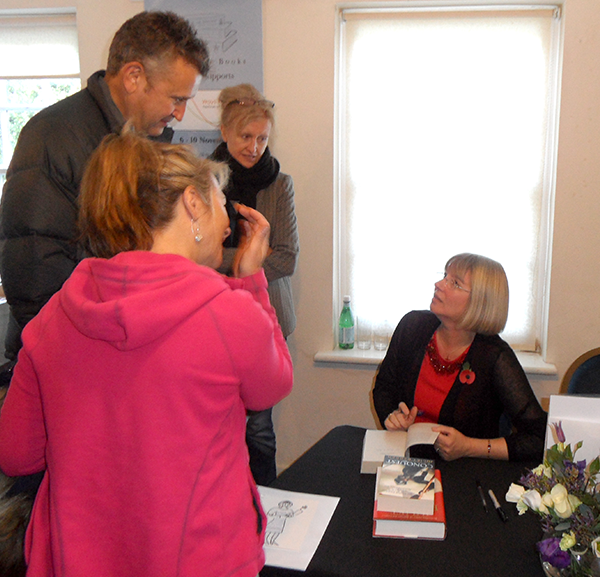 By the time England, Arise was finally published in October I was so exhausted that I was just grateful for the opportunity to sleep or rest as I travelled up and down the country to give talks on the new book: the Ilkley Literature Festival, Cheltenham Literature Festival (there and back in one frenetic day), the brilliant new BBC History Weekend at Malmesbury, Ways With Words at Southwold (pictured left), Warwick Books in the fabulous Lord Leycester’s Hospital in Warwick, the Yorkshire Post Literary Luncheon in Harrogate all passed in a blur.
By the time England, Arise was finally published in October I was so exhausted that I was just grateful for the opportunity to sleep or rest as I travelled up and down the country to give talks on the new book: the Ilkley Literature Festival, Cheltenham Literature Festival (there and back in one frenetic day), the brilliant new BBC History Weekend at Malmesbury, Ways With Words at Southwold (pictured left), Warwick Books in the fabulous Lord Leycester’s Hospital in Warwick, the Yorkshire Post Literary Luncheon in Harrogate all passed in a blur. 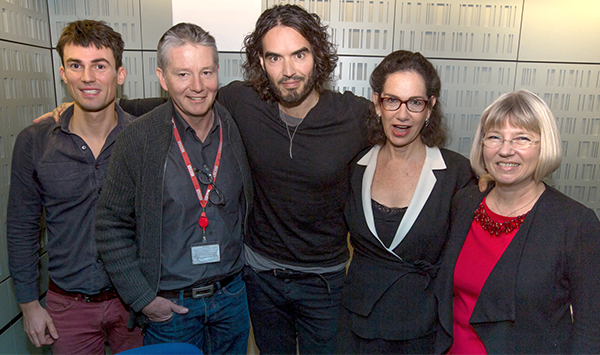 An encounter with Russell Brand (pictured right) on BBC Radio 4’s Start the Week was something entirely different and, thanks to masterly chairing by Tom Sutcliffe, not as confrontational as it might have been – though I was fortunate (and grateful) to be allowed to go first so that at least I was able to talk about my book before being talked over!
An encounter with Russell Brand (pictured right) on BBC Radio 4’s Start the Week was something entirely different and, thanks to masterly chairing by Tom Sutcliffe, not as confrontational as it might have been – though I was fortunate (and grateful) to be allowed to go first so that at least I was able to talk about my book before being talked over!
And now it’s a new year – and what a year of major anniversaries! Not just Agincourt in 1415 but Magna Carta in 1215, the 1715 Jacobite Rising, Waterloo in 1815 and much, much more. So, with a new edition of my Agincourt in the offing, I can guarantee it’s going to be another busy year – and that those boxes which were still unpacked when I last wrote a blog in 2013 will remain unopened and unsorted for quite some time to come!’
.............................................................................................................................................................................................
Monday 11th March 2013: . Juliet says: “Four and a half months on from my last blog and it’s not just a new year – for me it’s a new home too. I always thought I’d have to be taken feet-first from my old home, a wonderful old vicarage perched on a steep hillside high up on the moors above Hebden Bridge. 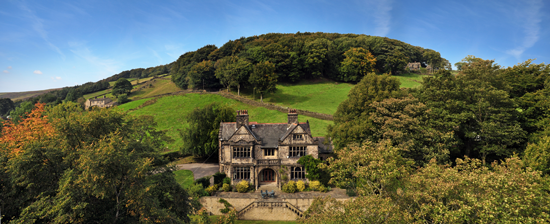 I loved everything about it: the way the views would change with the seasons – when the trees were in leaf they wrapped the house in a green mantle and hid it away from prying eyes –
I loved everything about it: the way the views would change with the seasons – when the trees were in leaf they wrapped the house in a green mantle and hid it away from prying eyes – 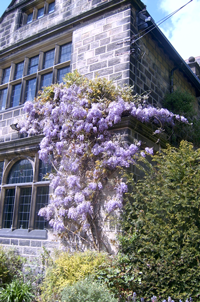 when autumn stripped them bare it opened up a vista of moorland on every side; the deep silence of the nights when the comfortable sounds of the brook running along the valley bottom and the village church clock chiming the hour were disturbed only by the shriek of the owls or the barking of fox and deer; the intoxicating scent of the flowers and the wisteria pervading the sunlit rooms along the front of the house and the terrace. We moved there in 1988 and for the best part of twenty-five years it was a much-loved family home – and the place where I have written most of my books. To move was a wrench but, once the children had grown up and left, the house was far too large and difficult to manage for just two people. And for me the relentless multiplication of wind turbines on every horizon of the moors which, like the Brontës, I had loved since childhood, eroded and eventually destroyed almost all the pleasure I took in the landscape.
when autumn stripped them bare it opened up a vista of moorland on every side; the deep silence of the nights when the comfortable sounds of the brook running along the valley bottom and the village church clock chiming the hour were disturbed only by the shriek of the owls or the barking of fox and deer; the intoxicating scent of the flowers and the wisteria pervading the sunlit rooms along the front of the house and the terrace. We moved there in 1988 and for the best part of twenty-five years it was a much-loved family home – and the place where I have written most of my books. To move was a wrench but, once the children had grown up and left, the house was far too large and difficult to manage for just two people. And for me the relentless multiplication of wind turbines on every horizon of the moors which, like the Brontës, I had loved since childhood, eroded and eventually destroyed almost all the pleasure I took in the landscape.
 So we took the plunge and uprooted ourselves to pastures new. Apart from a few brief years at university in Oxford, we’ve never lived anywhere except the West Riding of Yorkshire. Could we uproot ourselves after all this time? We could – but only into the North Riding. So here we are, in our new home in the Yorkshire Dales and it’s like living in a picture postcard. Every morning I open the shutters of our little Georgian house (it’s literally half the size of our old vicarage), the light floods in and I marvel at the view of empty snow-capped hills across the valley. Apart from the occasional passing traffic, or when the farmers are muck-spreading or hay-making in the fields, there’s no noise except the peaceful pastoral sounds that would be familiar to past generations. After heavy rain or when the snow melts we can hear the waterfalls which burst from the rock to meet the becks which flow into the river at the valley bottom. And at the moment, though the peewits and curlew haven’t arrived yet, our dale is filled with the sound of bird-song. The pace of life is slow and the people are incredibly welcoming and friendly – so much so that a two minute trip to the village shop often takes half an hour. We’ve learned the Dales way of driving – headlights on full even in the middle of the day, floor the accelerator and drive in the middle of the road – the headlights presumably having the magic power to ward off traffic coming in the opposite direction, though it doesn’t seem to work for the wildlife judging by the amount of road-kill. We might lack some of the conveniences of modern living (the nearest railway station is 45 minutes away, the nearest M&S over an hour away) but we have a better broadband signal than we had in Calderdale. And I still haven’t got over the thrill of having ancient castles and Cistercian abbeys on my doorstep.
So we took the plunge and uprooted ourselves to pastures new. Apart from a few brief years at university in Oxford, we’ve never lived anywhere except the West Riding of Yorkshire. Could we uproot ourselves after all this time? We could – but only into the North Riding. So here we are, in our new home in the Yorkshire Dales and it’s like living in a picture postcard. Every morning I open the shutters of our little Georgian house (it’s literally half the size of our old vicarage), the light floods in and I marvel at the view of empty snow-capped hills across the valley. Apart from the occasional passing traffic, or when the farmers are muck-spreading or hay-making in the fields, there’s no noise except the peaceful pastoral sounds that would be familiar to past generations. After heavy rain or when the snow melts we can hear the waterfalls which burst from the rock to meet the becks which flow into the river at the valley bottom. And at the moment, though the peewits and curlew haven’t arrived yet, our dale is filled with the sound of bird-song. The pace of life is slow and the people are incredibly welcoming and friendly – so much so that a two minute trip to the village shop often takes half an hour. We’ve learned the Dales way of driving – headlights on full even in the middle of the day, floor the accelerator and drive in the middle of the road – the headlights presumably having the magic power to ward off traffic coming in the opposite direction, though it doesn’t seem to work for the wildlife judging by the amount of road-kill. We might lack some of the conveniences of modern living (the nearest railway station is 45 minutes away, the nearest M&S over an hour away) but we have a better broadband signal than we had in Calderdale. And I still haven’t got over the thrill of having ancient castles and Cistercian abbeys on my doorstep.
The disruption caused by moving house has inevitably impacted on my ability to work but the remaining unpacked boxes will now have to wait till October as the Peasants’ Revolt becomes my most pressing priority. (There aren’t many people who can say that!) All the research is done and for the last few weeks I have been metaphorically putting pen to paper (fingers to keyboard actually). So all I need now is a sign on my study door saying ‘Work in Progress’. And to finish the book.”
.............................................................................................................................................................................................
Thursday 25th October 2012: . Juliet says: Thursday 25th October 2012. “It’s now more than five years – not since I wrote the last blog, though it sometimes feels like that – but since I wrote a book called The Deafening Sound of Silent Tears. 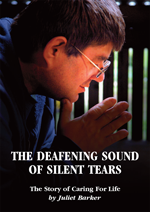 The book was a complete departure for me in many ways. It was the first I’d ever written about contemporary people and events: I usually write about the past and people who are long dead which avoids the unpleasantness of personal confrontation and causing unhappiness to the living. It was also the first book (and probably the last) I’ve ever written without any prospect of financial gain or even reimbursement for myself – quite something for a Yorkshirewoman with my credentials! The biggest departure for me, though, was the fact that this was a subject I cared about so passionately that I found it well nigh impossible to write with my usual detachment: by detachment I don’t mean lack of engagement with the subject, I mean the ability to see both sides, weigh things up and give a balanced view. What got in the way of this for me was a potent combination of love, respect and admiration verging on veneration for the people I was writing about, mixed with what I can only hope was righteous indignation (though I fear it often turned into anger pure and simple) on their behalf.
The book was a complete departure for me in many ways. It was the first I’d ever written about contemporary people and events: I usually write about the past and people who are long dead which avoids the unpleasantness of personal confrontation and causing unhappiness to the living. It was also the first book (and probably the last) I’ve ever written without any prospect of financial gain or even reimbursement for myself – quite something for a Yorkshirewoman with my credentials! The biggest departure for me, though, was the fact that this was a subject I cared about so passionately that I found it well nigh impossible to write with my usual detachment: by detachment I don’t mean lack of engagement with the subject, I mean the ability to see both sides, weigh things up and give a balanced view. What got in the way of this for me was a potent combination of love, respect and admiration verging on veneration for the people I was writing about, mixed with what I can only hope was righteous indignation (though I fear it often turned into anger pure and simple) on their behalf.
I don’t often push my own books but here’s another departure. If you haven’t read The Deafening Sound of Silent Tears then you ought to buy it and do so: not just because I hope it will arouse the same emotions in you but because all the profits go to the wonderful organisation which it celebrates. Caring For Life is a Christian charity, based in Cookridge on the outskirts of Leeds. This year it marks its silver jubilee – twenty-five years of looking after badly damaged people, most of whom have nowhere else to turn because they have been rejected, or simply failed, by their families, by society and by both local and national governments of every political persuasion. Many have physical disabilities or mental health problems which have been exacerbated by years of unimaginable abuse and deprivation. It’s bad enough that people should have suffered so much at the hands of their fellow human beings but what incenses me that organisations like Caring For Life seem to have every possible hurdle put in their way. We hear so much about terrible neglect and abuse taking place in both publicly and privately run care homes and yet here is a charity, with the sort of record in turning round lives and preventing reoffending or a return to homelessness which governments can only dream of – well over 90%, year on year, for twenty-five years – and also manages to do it far more cheaply than any other so-called ‘service-provider’, public or private, because it draws on the support of so many committed volunteers and private charitable trusts. So what happens? Instead of backing Caring For Life’s work to the hilt, Government funding is withdrawn. Nor can you look to the ‘big name’, high profile charitable projects, such as the BBC’s Children in Need Appeal, to name and shame just one. Why? Principally because Caring For Life is a Christian organisation, though it looks after people of all faiths and none. The staff and many, though not all, of the volunteers are Christians, working there because they believe that, in doing so, they are following in the footsteps of Christ and fulfilling His commandments. But Christian organisations, however successful in reducing the burden to the state, are shunned in our current political climate. Hence the withdrawal of Supporting People funding which helped to accommodate vulnerable people in two homes and to finance vital outreach work enabling literally hundreds of others to live in the community. The shortfall in funding is particularly critical at a time when, due to the recession, the call on the services Caring For Life provides have never been greater. Unlike some other Christian organisations, which have either abandoned their founding principles in an effort to retain public funding, or closed down their facilities altogether, Caring For Life took the decision to battle on, looking instead to replace their funding with whatever they could earn themselves.
So it was a particular pleasure to go to Caring For Life today for the official opening of the magnificent new and much enlarged Granary cafe and shop created (thanks to the exceptional generosity of some remarkable individuals and grant-making trusts) out of what one can only politely call a dilapidated seventeenth century barn. Now transformed, with its huge oak beams restored and soaring to a great high ceiling, full of light and air, it looks and feels almost like a cathedral – though one that serves the highest quality food, much of it, including the meat, eggs, salads, chutneys, scones and cakes produced on the farm itself with the assistance of the people whom the charity cares for, giving them a sense of pride in making their own contribution and new-found capabilities. There’s a fabulous new deli counter, offering home-produced meats and sausages plus a wide variety of superb English cheeses (ever heard of Northumbrian Nettle? – I hadn’t but it’s delicious!), and a shop which is definitely my first-choice option for all my Christmas shopping. It is my hope and prayer that the cafe and shop will be a runaway success, not just replacing the public funds which have been lost but creating additional income so that, freed from having to jump through the hoops created by short-sighted and petty-minded government bureaucrats, Caring For Life will be able to grow, expand and flourish. Because there’s one thing that is certain: the poor are always with us and the need will never go away.”

.............................................................................................................................................................................................
Sunday 1st July 2012: . “All work and no play has made me a very dull person indeed, hence the resounding silence on the blog front for the last couple of months. What did you do today? Read some books. And yesterday? The same. And tomorrow? The same. Though this means that I’ve made considerable progress in researching my next project (the Peasants’ Revolt of 1381) it doesn’t exactly make for an interesting blog, does it? Last week, however, I took a whole day off. And what a day it turned out to be! It began with an unusual morning concert of Hollywood classics played by the Pavão String Quartet as part of the Northern Aldborough Festival. (That’s Aldborough near Boroughbridge in Yorkshire, not Aldborough on the Suffolk coast.) The music itself was thoroughly enjoyable but the setting, Swinton Park near Masham, was spectacular: a late seventeenth century house (built by Sir Abstrupus Danby who owed his delightful name to the parson being drunk at his christening) transformed in the nineteenth century into an imposing baronial style castle complete with battlements, turrets and exquisitely landscaped parkland. Despite the increasingly heavy rain which had already flooded some of the roads, we made it to West Tanfield for lunch with the friends who had invited us to the concert. Even though the river was rising visibly before our eyes this didn’t put us off our final port of call because that very afternoon was one of the rare occasions when a house I’ve longed to see for many years was actually open to the public.
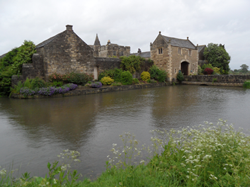 Markenfield Hall has to be the most beautiful, as well as the most unspoilt, medieval house in England: it’s certainly unique in Yorkshire. Imagine a perfect medieval castle, with a bridge over the moat leading through a gatehouse into the courtyard: imagine vaulted undercrofts and a crenellated Great Hall with an adjoining chapel. And then reduce it in scale in your mind’s eye till it’s just a fraction of the size – and there you have Markenfield Hall. A miniature castle, or rather a small fortified manor house, it was built in 1310 on even older foundations. It’s tucked away in undulating farmland near Fountains Abbey and at first sight emerges at the end of a long farm track and a crop of more modern farm buildings as if raised from sleep by enchantment.
Markenfield Hall has to be the most beautiful, as well as the most unspoilt, medieval house in England: it’s certainly unique in Yorkshire. Imagine a perfect medieval castle, with a bridge over the moat leading through a gatehouse into the courtyard: imagine vaulted undercrofts and a crenellated Great Hall with an adjoining chapel. And then reduce it in scale in your mind’s eye till it’s just a fraction of the size – and there you have Markenfield Hall. A miniature castle, or rather a small fortified manor house, it was built in 1310 on even older foundations. It’s tucked away in undulating farmland near Fountains Abbey and at first sight emerges at the end of a long farm track and a crop of more modern farm buildings as if raised from sleep by enchantment. 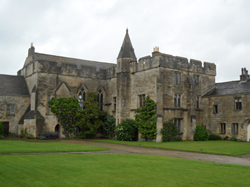 The Markenfields fought at Agincourt, Flodden Field and Bosworth; as prominent Catholics, they also had leading roles in both the Pilgrimage of Grace (1536) and the Rising of the North (1569) which brought about their downfall. So evocative is the place that it takes very little imagination to picture Sir Thomas Markenfield and his uncle Sir Richard Norton hearing mass in the tiny chapel before joining the rebels gathered in the courtyard below and leading them out under their banner of the Five Wounds of Christ to defeat and disgrace. What makes Markenfield Hall even more special is that it remains in the hands of Markenfield descendants and is still an obviously much-loved family home. We got drenched to the skin during our visit (I couldn’t leave without doing the external circuit round the moat) but it was worth it!
The Markenfields fought at Agincourt, Flodden Field and Bosworth; as prominent Catholics, they also had leading roles in both the Pilgrimage of Grace (1536) and the Rising of the North (1569) which brought about their downfall. So evocative is the place that it takes very little imagination to picture Sir Thomas Markenfield and his uncle Sir Richard Norton hearing mass in the tiny chapel before joining the rebels gathered in the courtyard below and leading them out under their banner of the Five Wounds of Christ to defeat and disgrace. What makes Markenfield Hall even more special is that it remains in the hands of Markenfield descendants and is still an obviously much-loved family home. We got drenched to the skin during our visit (I couldn’t leave without doing the external circuit round the moat) but it was worth it!
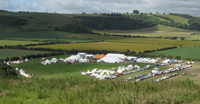 Today, however, saw me in equally exciting though completely different circumstances – delivering a talk on Agincourt to a surprisingly packed tent (surprising since I was scheduled in exactly the same slot as Michael Morpurgo) in the middle of a field near Salisbury. Actually, that’s hardly fair because the field in question lies in an astonishing natural chalk amphitheatre in the midst of beautiful Wiltshire countryside and it’s the site of the second Chalke Valley History Festival.
Today, however, saw me in equally exciting though completely different circumstances – delivering a talk on Agincourt to a surprisingly packed tent (surprising since I was scheduled in exactly the same slot as Michael Morpurgo) in the middle of a field near Salisbury. Actually, that’s hardly fair because the field in question lies in an astonishing natural chalk amphitheatre in the midst of beautiful Wiltshire countryside and it’s the site of the second Chalke Valley History Festival. 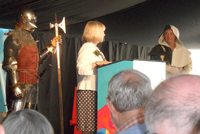 What a phenomenal new arrival on the literary scene this is! An amazing cast of speakers (during the few hours I was there I saw not just Michael Morpurgo but Anthony Beevor, Sebastian Faulks, Tom Holland, Ian Mortimer, Saul David and Helen Castor to name but a few) and 15,000 visitors, up from just 3000 last year. As an author it’s wonderful (and unfortunately unusual) to receive such a warm and friendly reception from the festival staffers and to be looked after so well throughout our stay.
What a phenomenal new arrival on the literary scene this is! An amazing cast of speakers (during the few hours I was there I saw not just Michael Morpurgo but Anthony Beevor, Sebastian Faulks, Tom Holland, Ian Mortimer, Saul David and Helen Castor to name but a few) and 15,000 visitors, up from just 3000 last year. As an author it’s wonderful (and unfortunately unusual) to receive such a warm and friendly reception from the festival staffers and to be looked after so well throughout our stay. 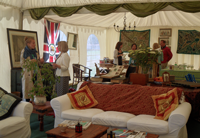 The author’s green room was typical of the thought that had gone into everything – a marvellous recreation (pictured) of a nineteenth or early twentieth century officers’ mess tent, complete with tiger’s head, standards, weaponry and even period photograph albums! We were also lucky enough to be the overnight guests of Sue and Rodney Heath in their beautiful manor house at Alverdiston:
The author’s green room was typical of the thought that had gone into everything – a marvellous recreation (pictured) of a nineteenth or early twentieth century officers’ mess tent, complete with tiger’s head, standards, weaponry and even period photograph albums! We were also lucky enough to be the overnight guests of Sue and Rodney Heath in their beautiful manor house at Alverdiston: it was worth the six hundred mile round trip just to see their glorious rose gardens! Full marks to the organisers and a big thank you to all concerned – including the Agincourt re-enactors who frog-marched me on stage and, most especially, the audience who listened attentively, laughed at all the right points, asked loads of intelligent questions and afterwards bought even more copies of Agincourt and Conquest. And how amazing to have in that audience a descendant of Robert de Chalus, one of the French leaders who was killed in the first cavalry charge at Agincourt!
it was worth the six hundred mile round trip just to see their glorious rose gardens! Full marks to the organisers and a big thank you to all concerned – including the Agincourt re-enactors who frog-marched me on stage and, most especially, the audience who listened attentively, laughed at all the right points, asked loads of intelligent questions and afterwards bought even more copies of Agincourt and Conquest. And how amazing to have in that audience a descendant of Robert de Chalus, one of the French leaders who was killed in the first cavalry charge at Agincourt!
After all this excitement, it’s now back to the grindstone. Revolting peasants here I come!”
.............................................................................................................................................................................................
 Sunday 29th April 2012: “Summoned by bells, their chimes drifting down the valley, I decided to walk to church this morning. Not a particularly wise decision as it turned out – a biting east wind was soon hammering icy drops of rain into my face – but the woods and hedgerows were full of primroses and bluebells and, at one point, a startled stoat scurried across the road just in front of me. The rivers were in full spate and the waterfalls foamed just like Shire beer. Walking back was less of a pleasure. By the time I had to make my way home again, the weather had taken a turn for the worse and I had to battle my way though horizontal sheets of rain and gusts of wind which left me soaked to the skin and chilled to the bone. ‘Oh to be in England, now that April’s there’? I think not!
Sunday 29th April 2012: “Summoned by bells, their chimes drifting down the valley, I decided to walk to church this morning. Not a particularly wise decision as it turned out – a biting east wind was soon hammering icy drops of rain into my face – but the woods and hedgerows were full of primroses and bluebells and, at one point, a startled stoat scurried across the road just in front of me. The rivers were in full spate and the waterfalls foamed just like Shire beer. Walking back was less of a pleasure. By the time I had to make my way home again, the weather had taken a turn for the worse and I had to battle my way though horizontal sheets of rain and gusts of wind which left me soaked to the skin and chilled to the bone. ‘Oh to be in England, now that April’s there’? I think not!
Still, it was better than being in London at any time of the year. We’ve spent the last week there, enduring much the same sort of weather, whilst we ‘did’ the sights with a young American guest. There were times when I thought I’d never get warm or dry again: and there’s something soul-destroying about tramping on endless concrete pavements, being forced to shove your way through crowds and breathe in the equally obnoxious fumes of traffic and fast food, not to mention having your last purse bled dry by exorbitant entrance charges. I absolutely refused to spend £18.90 for thirty minutes on the London Eye, allowing myself to believe that the money we’d saved on my ticket paid for afternoon tea at the Ritz, an altogether more enjoyable experience.  But I grudgingly coughed up my pennies for better causes such as Westminster Abbey (worth it for the museum alone which I’ve unaccountably missed on every previous visit) and The Globe – where we had the unexpected pleasure of seeing a theatre company from Auckland, New Zealand, rehearsing Shakespeare’s Troilus and Cressida in Maori. The newly refurbished Tower of London galleries were a treat as was a sparkling production of Michael Frayn’s Noises Off which left us crying with laughter. For our visitor, who loved every minute of his trip to the Great Wen, there was a memorable final flourish: seeing the Queen and the Duke of Edinburgh at the re-opening of the Cutty Sark. What better way to mark Jubilee year? The photo is courtesy of Hunter Phillips, who’s already made his appearance on camera on the big screen in The Hunger Games, but is also clearly a talent to watch behind the camera as well. It’s a much better photo than the ones that appeared in the press!
But I grudgingly coughed up my pennies for better causes such as Westminster Abbey (worth it for the museum alone which I’ve unaccountably missed on every previous visit) and The Globe – where we had the unexpected pleasure of seeing a theatre company from Auckland, New Zealand, rehearsing Shakespeare’s Troilus and Cressida in Maori. The newly refurbished Tower of London galleries were a treat as was a sparkling production of Michael Frayn’s Noises Off which left us crying with laughter. For our visitor, who loved every minute of his trip to the Great Wen, there was a memorable final flourish: seeing the Queen and the Duke of Edinburgh at the re-opening of the Cutty Sark. What better way to mark Jubilee year? The photo is courtesy of Hunter Phillips, who’s already made his appearance on camera on the big screen in The Hunger Games, but is also clearly a talent to watch behind the camera as well. It’s a much better photo than the ones that appeared in the press!
That wasn’t our only brush with royalty as, just a few weeks ago, we were privileged to be present at a visit to Caring For Life by its patron Sophie, Countess of Wessex. Unbelievably, the charity is celebrating its twenty-fifth birthday. The work remains the same (and the workload increases daily in these straitened times) but what began as a simple voluntary response to the desperate plight of a few individuals is now a highly professional organisation caring for hundreds of deeply damaged and vulnerable people and enabling them to lead the ‘ordinary’ lives which would otherwise be beyond their reach. 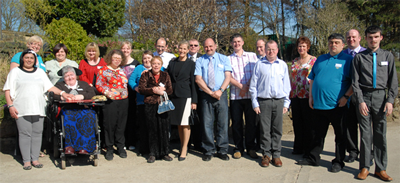 What remains at the heart of CFL, though, is not just the physical well-being of those for whom it cares but literally their hearts – and souls – reflecting a deep personal commitment to each and every one of them, no matter how difficult or unresponsive, and loving them as Christ himself loved us. It would be hard to imagine a more appropriate patron than the Countess of Wessex who, without fanfare or any of the egotistical brouhaha of the celebrity circus, has quietly and consistently given generously of her time, her money and her equally valuable expertise. She cares, and, no matter how damaged or vulnerable they are, the beneficiaries of Caring For Life know that she does, which is why they all think the world of her.”
What remains at the heart of CFL, though, is not just the physical well-being of those for whom it cares but literally their hearts – and souls – reflecting a deep personal commitment to each and every one of them, no matter how difficult or unresponsive, and loving them as Christ himself loved us. It would be hard to imagine a more appropriate patron than the Countess of Wessex who, without fanfare or any of the egotistical brouhaha of the celebrity circus, has quietly and consistently given generously of her time, her money and her equally valuable expertise. She cares, and, no matter how damaged or vulnerable they are, the beneficiaries of Caring For Life know that she does, which is why they all think the world of her.”
.............................................................................................................................................................................................
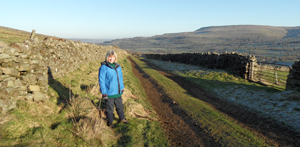
Tuesday 28th February 2012:“These past few weeks I’ve been ‘tormented by erratic and vagrant instincts’, to misquote Charlotte Brontë very slightly. She was referring to her first visit to the Lake District where politeness obliged her to accompany her uncongenial host in his carriage rather than indulge her own longing ‘to slip out unseen, and to run away by myself in amongst the hills and days’. I’ve been tied to my desk, half-submerged beneath dusty books, papers and a collection of index cards that’s growing at an alarming rate. 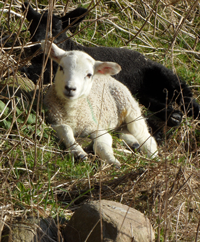 I’m now at that point in the book-writing cycle when almost every waking hour has to be dedicated to researching the next project. And fascinating though it is, the temptation to escape into the hills is hard to resist. The weather has been perfect for walking. First we had a series of bitterly cold days with clear blue skies overhead and rock-hard earth beneath – the sort of days where the sharpness of the air seems to throw everything into relief and magnify the smallest detail. Now we have melted into balmy spring sunshine: the lambs are frolicking in the field opposite my window, the snowdrops are carpeting the churchyard and village gardens and yesterday I saw the first primroses peering out uncertainly from the hedgerow. (I’ve always thought one of Wordsworth’s finest lines was his exquisite description of how ‘the patient primrose sits like a beggar in the cold’.)
I’m now at that point in the book-writing cycle when almost every waking hour has to be dedicated to researching the next project. And fascinating though it is, the temptation to escape into the hills is hard to resist. The weather has been perfect for walking. First we had a series of bitterly cold days with clear blue skies overhead and rock-hard earth beneath – the sort of days where the sharpness of the air seems to throw everything into relief and magnify the smallest detail. Now we have melted into balmy spring sunshine: the lambs are frolicking in the field opposite my window, the snowdrops are carpeting the churchyard and village gardens and yesterday I saw the first primroses peering out uncertainly from the hedgerow. (I’ve always thought one of Wordsworth’s finest lines was his exquisite description of how ‘the patient primrose sits like a beggar in the cold’.)
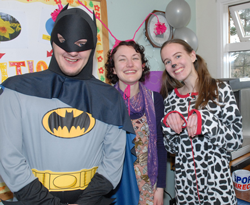 Today, however, I had the perfect excuse to abandon my books: an invitation to attend a very special birthday party. Because it was exactly twenty-five years ago, on this very day, that two modern day saints, Peter Parkinson and Esther Smith (pictured bottom right), supported by members of their local congregation, founded Caring For Life, a charity offering homes, meaningful employment and, most important of all, lifelong membership of a loving family circle to vulnerable and destitute people who had rarely, if ever, known such things. (The traumatic stories of some of them almost defy belief.
Today, however, I had the perfect excuse to abandon my books: an invitation to attend a very special birthday party. Because it was exactly twenty-five years ago, on this very day, that two modern day saints, Peter Parkinson and Esther Smith (pictured bottom right), supported by members of their local congregation, founded Caring For Life, a charity offering homes, meaningful employment and, most important of all, lifelong membership of a loving family circle to vulnerable and destitute people who had rarely, if ever, known such things. (The traumatic stories of some of them almost defy belief. 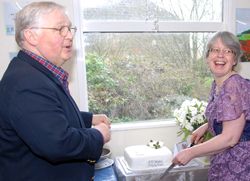 One of the first young men to be cared for had returned home from school one day, aged fourteen, to find his mother had died of cancer and his father had committed suicide; sent to live with his sister, he had never been back to school but had been forced to live in an outhouse where his only supply of water was the toilet. When Peter took him to his new home he was so severely traumatised that he was virtually unable to speak – and still wearing the same threadbare clothes he had worn on the day he had found his parents’ bodies years earlier.)
One of the first young men to be cared for had returned home from school one day, aged fourteen, to find his mother had died of cancer and his father had committed suicide; sent to live with his sister, he had never been back to school but had been forced to live in an outhouse where his only supply of water was the toilet. When Peter took him to his new home he was so severely traumatised that he was virtually unable to speak – and still wearing the same threadbare clothes he had worn on the day he had found his parents’ bodies years earlier.)
For me Caring For Life is the perfect embodiment of what Christianity is – or should be – all about: not the supposed burning issues of the day such as women priests, homosexuality or pulling out the pews in ancient churches which so preoccupy the media (and far too many members of the church) but following Christ’s own example and offering unconditional love to people who have never been loved before and who are often difficult to love. Some of them are truly scary people, violent, angry, abusers of themselves and others; some are simply crushed and hopeless, worthless in society’s eyes and their own. Yet their lives can be transformed by being treated with dignity, patience and love. It can take years, even decades, to mend someone who has been so broken by their early experiences of life, but Caring For Life has proved time and again that it can be done. Today, hearing the laughter, watching the fun and games and seeing the genuine affection and support that these desperately damaged people have learned not only to accept, but also to give to each other, I only wished that every member of the government and social care administration could have been there to witness, as I did, the transformative power of the Gospel message.”
Link: Caring For Life's story so far - 'The Deafening Sound of Silent Tears'
.............................................................................................................................................................................................
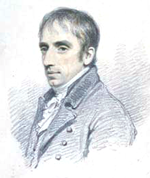 Monday 23rd January 2012:“These days I find myself more and more in sympathy with Wordsworth – not the youthful romantic lauded for his poetic sensibilities but the curmudgeonly old Poet Laureate vilified then (as now) for his opposition to the building of a railway through the heart of the Lake District. His protests were greeted with charges of snobbery, elitism and what we today would call nimbyism – a term which is meant to be offensive though I’ve never understood why, as it’s surely a virtue to care about the place where you live – if you don’t, then why should anyone else? But the unpalatable fact is that Wordsworth was right – and his unpopular stance saved the Lake District from an industrial development that would have permanently scarred the landscape and turned it into the main thoroughfare for transporting coal from Workington to the mill towns of Lancashire and Yorkshire.
Monday 23rd January 2012:“These days I find myself more and more in sympathy with Wordsworth – not the youthful romantic lauded for his poetic sensibilities but the curmudgeonly old Poet Laureate vilified then (as now) for his opposition to the building of a railway through the heart of the Lake District. His protests were greeted with charges of snobbery, elitism and what we today would call nimbyism – a term which is meant to be offensive though I’ve never understood why, as it’s surely a virtue to care about the place where you live – if you don’t, then why should anyone else? But the unpalatable fact is that Wordsworth was right – and his unpopular stance saved the Lake District from an industrial development that would have permanently scarred the landscape and turned it into the main thoroughfare for transporting coal from Workington to the mill towns of Lancashire and Yorkshire.
What brought this to mind was a double page spread in Saturday’s Daily Telegraph (click here to read article) highlighting yet another piece of mindless vandalism being inflicted on the unfortunate village of Haworth. Planners in Bradford Metropolitan District Council want to build 600 new houses in this iconic place, some on brown field sites but some on the green fields which still (despite the best efforts of previous planning authorities), surround the village and help it to retain some vestige of its appearance in the Brontës’ day. Haworth has already suffered from a rash of inappropriate development, mostly inflicted since it lost its status as part of the borough of neighbouring Keighley and became part of Bradford, with which it has nothing in common. To be fair to the planners, they are only trying to share the pain inflicted on them by unrealistic central government housing targets which are completely inappropriate for a city where so much property is already standing empty. To swamp any outlying village of 2500 houses with an additional 600 new ‘executive homes’ is insensitive and inappropriate: to do so in Haworth, the second most-visited literary tourist attraction after Stratford, displays breath-taking cultural ignorance and is little short of criminal. Bradford planners have form in this department – they’ve already tried a couple of times to have the setts up Main Street covered in tarmac on health and safety grounds and I am offended by the mis-spelling of ‘Heathcliffe Mews’ every time I visit the place.
But what the article does not say is that there is a far greater threat to Haworth even than this mad scheme. For more than fifteen years now, those of us who love the Brontës and those who live in this beautiful area, have campaigned against wind turbines. Before most people, including myself, knew what a wind turbine was, one of the first in the country was erected in Haworth on the hillside facing the Parsonage and Yorkshire Water built a further twenty-three at the Ovenden Moor on the fringes of the moors which form the backdrop to Haworth. An international campaign in the 1990s thwarted the erection of a further six or eight at the same site in Haworth , together with National Wind Power’s plans to build twenty-five between Ovenden Moor and Haworth (the latter’s environmental impact statement said that the site had no historical or cultural significance!) But since the last government changed the planning laws, every application which had been defeated at local level has been approved on appeal and the turbines are now encroaching on every horizon. Each new development adds a twist to the tourniquet which is strangling the moors which were the passion and inspiration of the Brontë family – literally killing them, since it is impossible to restore or recreate the blanket bog in which they have been erected.
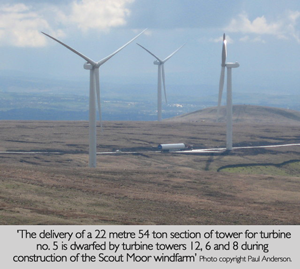
The latest twist comes courtesy of Peel Energy, a company whose website proudly boasts ‘England’s largest onshore scheme, Scout Moor in Lancashire, fifteen miles north of Manchester. This project took seven years from identifying the site, through consenting, to opening in September 2008.’ (click here to see images on the construction of this windfarm). Curiously, what they don’t tell you is that the twenty-six 100 metre high turbines sit on the horizon south-west of Haworth and can be seen from almost every part of the moorlands above the Brontës’s home. Not content with this act of cultural vandalism, Peel Energy now wants to double the size of the windfarm, expanding north and east on virgin moorland – and encroaching ever closer in to the heartland of the Brontë moors. Peel Energy claims to be holding a consultation but, since the company previously ignored the years of protest from local inhabitants and their elected representatives, not to mention from Brontë lovers, I hold out no hope that they will respect opposing opinion and withdraw their latest scheme. And I have no doubt at all that they will receive a pat on the back from the Department of the Environment – together with a vast subsidy – for putting several more nails in the coffin of our irreplaceable literary heritage. Where’s a Wordsworth when you need him?”
.............................................................................................................................................................................................
Monday 28th November 2011:“What glamorous lives we authors lead, I thought to myself, as I stood waiting for the long-delayed last train out of Manchester Piccadilly station. Nearly midnight and here I am, standing looking at the pools of urine between the tracks and surrounded by hundreds of hyperventilating pre-pubescent girls, most of them wearing too much make-up and too little clothing, who have just poured out on to the platform from a Rihanna concert at the inappropropriately named M.E.N. arena. O tempera, o mores! (Or is it just o what a snob?) Just a few hours ago I was in the British Library gazing in awe at some of the finest illuminated manuscripts of the medieval and renaissance period. The Royal collection is one of the wonders of the world – and never before have so many of its superb examples been seen in one public exhibition. The result is over-whelming – rather like eating a whole box of chocolates at once – so I made a bee-line straight for the manuscripts belonging to ‘my’ part of the Hundred Years War. And I was exceptionally fortunate that, thanks to the wizardry of Colin Wight who, with barely an hour’s notice managed to put together a series of their images for me, even a complete technophobe like me was able to use some of them in my talk.
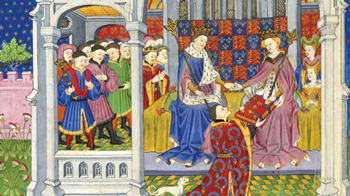 One of my favourites is the fabulous Shrewsbury Book (pictured), a unique collection of chivalric texts and romances created by the masters of English-held Rouen and presented by John Talbot, Earl of Shrewsbury to Margaret of Anjou on her marriage to Henry VI. There’s such a wealth of visual detail, from the white dog (or talbot, a punning reference to the donor’s name) at Talbot’s feet and the garters, representing his membership of the Order of the Garter, depicted on his cloak, to the great tapestry displaying the arms of England and France behind the king and queen. Medieval art was all about symbolism and propaganda. Every picture literally does tell a story. And another of my favourites is the Psalter presented to the infant Henry VI on his coronation as king of France: not because the art work is as spectacular as the Shrewsbury Book, but because this book was originally made for his uncle, the dauphin Louis de Guienne who died just after Agincourt, and the image of him kneeling before the Virgin and child was altered in 1430 to represent Henry VI by repainting the arms on his coat to represent those of both France and England. And we think recycling is a modern phenomenon! But think of all the history encapsulated in that single image. A proud Valois prince and heir to the French throne obliterated and replaced in art, as in life, by the son of an English conqueror. Rather more poignant and interesting than Rihanna and her wretchedly catchy ‘umberella’. I repeat, o tempora, o mores!”
One of my favourites is the fabulous Shrewsbury Book (pictured), a unique collection of chivalric texts and romances created by the masters of English-held Rouen and presented by John Talbot, Earl of Shrewsbury to Margaret of Anjou on her marriage to Henry VI. There’s such a wealth of visual detail, from the white dog (or talbot, a punning reference to the donor’s name) at Talbot’s feet and the garters, representing his membership of the Order of the Garter, depicted on his cloak, to the great tapestry displaying the arms of England and France behind the king and queen. Medieval art was all about symbolism and propaganda. Every picture literally does tell a story. And another of my favourites is the Psalter presented to the infant Henry VI on his coronation as king of France: not because the art work is as spectacular as the Shrewsbury Book, but because this book was originally made for his uncle, the dauphin Louis de Guienne who died just after Agincourt, and the image of him kneeling before the Virgin and child was altered in 1430 to represent Henry VI by repainting the arms on his coat to represent those of both France and England. And we think recycling is a modern phenomenon! But think of all the history encapsulated in that single image. A proud Valois prince and heir to the French throne obliterated and replaced in art, as in life, by the son of an English conqueror. Rather more poignant and interesting than Rihanna and her wretchedly catchy ‘umberella’. I repeat, o tempora, o mores!”
.............................................................................................................................................................................................
Saturday 29th October 2011:“The last couple of weeks have been very busy on all fronts, including an after-dinner speech at the charter dinner for Soroptimist International of Harrogate and District on Agincourt, and an event on the Brontës at the marvellously vibrant and hugely popular Morley Literature Festival which is going from strength to strength. The secret of Morley’s success, I was told by several members of my audience, is that it invites ‘proper’ authors, not celebrities who’ve put their names to books. Being a very proper author myself, I was immensely gratified to find that the organisers of my event had not only sold out of tickets but had even had to turn people away.
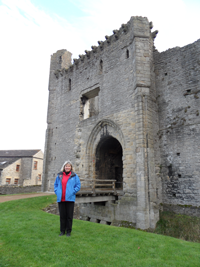 Then it was back to Agincourt again for an event at Middleham in the Yorkshire Dales. Middleham is a charming little town, with picture-postcard perfect cobbled squares and streets and an ancient church, one of only two (the other is also in North Yorkshire at Giggleswick) dedicated to St Alkelda, a Saxon lady who is said to have been martyred by Danish women who strangled her for her Christian faith. The town is famous for its gallops on the High Moor where local studs have exercised their horses since medieval times and where they now train the beautiful racehorses which you often see clattering down through the cobbled streets. Middleham is also synonymous with Richard III: its spectacular castle was the childhood home and favourite residence of Richard III – as well as a prison for both the unfortunate Henry VI and Edward IV. Wouldn’t you just know that it was, of course, Richard’s successors, the wretched Tudors, who let it fall into disrepair? The reason why I was invited to Middleham is because it is now twinned with Azincourt in France – though I noticed that the signs on entering the town pointedly Anglicise the name to Agincourt. We had a sparkling and lengthy question and answer session at the end of my talk which was great fun – the audience was highly knowledgeable and there were a few cuts and thrusts but I think I managed to parry most of them and emerged unscathed. And with a bottle of wine, which is always a good result.
Then it was back to Agincourt again for an event at Middleham in the Yorkshire Dales. Middleham is a charming little town, with picture-postcard perfect cobbled squares and streets and an ancient church, one of only two (the other is also in North Yorkshire at Giggleswick) dedicated to St Alkelda, a Saxon lady who is said to have been martyred by Danish women who strangled her for her Christian faith. The town is famous for its gallops on the High Moor where local studs have exercised their horses since medieval times and where they now train the beautiful racehorses which you often see clattering down through the cobbled streets. Middleham is also synonymous with Richard III: its spectacular castle was the childhood home and favourite residence of Richard III – as well as a prison for both the unfortunate Henry VI and Edward IV. Wouldn’t you just know that it was, of course, Richard’s successors, the wretched Tudors, who let it fall into disrepair? The reason why I was invited to Middleham is because it is now twinned with Azincourt in France – though I noticed that the signs on entering the town pointedly Anglicise the name to Agincourt. We had a sparkling and lengthy question and answer session at the end of my talk which was great fun – the audience was highly knowledgeable and there were a few cuts and thrusts but I think I managed to parry most of them and emerged unscathed. And with a bottle of wine, which is always a good result.
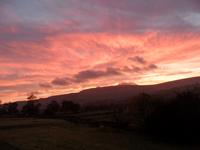 Yesterday we had a cold cloudless night in the Dales and the most incredible display of stars – I’d not seen one like it since working in Grasmere for my Wordsworth biography. Without the light pollution which masks so much of the English sky we could see not just the bright pin-points of a myriad of individual stars but the milky smudges of whole galaxies. Absolutely magical. This morning we were treated to an equally spectacular sunrise over Penhill – the hill which Mary Queen of Scots looked out upon daily as the view from her prison window at Bolton Castle. I managed to take a photograph of the sunrise from my bedroom window just before the cloud and drizzle moved in again to remind us how fleeting and precious such moments are.”
Yesterday we had a cold cloudless night in the Dales and the most incredible display of stars – I’d not seen one like it since working in Grasmere for my Wordsworth biography. Without the light pollution which masks so much of the English sky we could see not just the bright pin-points of a myriad of individual stars but the milky smudges of whole galaxies. Absolutely magical. This morning we were treated to an equally spectacular sunrise over Penhill – the hill which Mary Queen of Scots looked out upon daily as the view from her prison window at Bolton Castle. I managed to take a photograph of the sunrise from my bedroom window just before the cloud and drizzle moved in again to remind us how fleeting and precious such moments are.”
.............................................................................................................................................................................................
Friday 9th September 2011:“Brontëmania has been running at fever-pitch for the last couple of weeks, stirred up by a potent combination of three premieres – new films of Jane Eyre and Wuthering Heights and Blake Morrison’s play We Are Three Sisters. I haven’t seen the films – though I’ve seen enough of the clips from Jane Eyre to see that even now, more than 160 years after Charlotte wrote her ground-breaking novel, it is still unacceptable, if not impossible, for any visual version to have a truly plain actress in the title role. Mind you, the same thing goes for Mr Rochester too. Apparently the audience at the screening in Haworth burst out laughing when Jane told him he was ugly. Not quite the reaction Charlotte (or, one assumes, the director) intended!
As a result of this revived enthusiasm for all things Brontë I’ve been inundated with requests for interviews and this morning saw me up at 5.30am so that I could get to Manchester for a live recording of Woman’s Hour. Ridiculously early but I’ve learned through bitter experience that the only way to make sure you arrive in time for these things is to take an early train with two to spare in case the first doesn’t arrive or is held up. So of course everything went perfectly smoothly and at 8.45 I was sitting in reception at the BBC. Blake, who’d taken the precaution of staying in Manchester the night before, casually sauntered in an hour later and maintained an enviably cool demeanour throughout our interview with the formidable Jenni Murray. I, meanwhile, turned red as a hep (what is a hep? I’ve always wondered) and waved my arms around like an orchestral conductor on speed as I always do when I’m stressed. On the way back to the station Blake got an approving text from ‘Emily and Anne’ who’d listened to the interview in the car! (click here to listen)
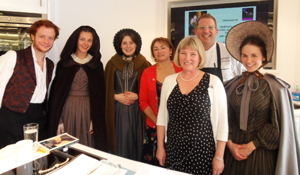 There was just time to return home, shower, change and gather my thoughts before I had to be at The Cooking School in Halifax to give a talk about the Brontës and their creative kitchen. Not a promising subject, you’d think, given that the Brontës’ appearance and health doesn’t exactly suggest that they enjoyed the pleasures of the table, but nevertheless a surprisingly fruitful subject to research and discuss. It’s not just that the kitchen was literally at the heart of their home but that it was also at the heart of their writing: it was sitting round the kitchen fire as children one dark winter evening without a candle to read by that they conjured up the imaginary worlds which became their apprenticeship in writing. We were extremely fortunate that Ann Dinsdale from the Brontë Parsonage Museum had brought along three items from that very kitchen to illustrate the talk, including the crimping iron which I think is amongst the most evocative objects in the collection. An added bonus for those attending – as you can see from the photo – was a visit from the cast of We Are Three Sisters who had just finished their final dress rehearsal in the neighbouring Viaduct theatre.
There was just time to return home, shower, change and gather my thoughts before I had to be at The Cooking School in Halifax to give a talk about the Brontës and their creative kitchen. Not a promising subject, you’d think, given that the Brontës’ appearance and health doesn’t exactly suggest that they enjoyed the pleasures of the table, but nevertheless a surprisingly fruitful subject to research and discuss. It’s not just that the kitchen was literally at the heart of their home but that it was also at the heart of their writing: it was sitting round the kitchen fire as children one dark winter evening without a candle to read by that they conjured up the imaginary worlds which became their apprenticeship in writing. We were extremely fortunate that Ann Dinsdale from the Brontë Parsonage Museum had brought along three items from that very kitchen to illustrate the talk, including the crimping iron which I think is amongst the most evocative objects in the collection. An added bonus for those attending – as you can see from the photo – was a visit from the cast of We Are Three Sisters who had just finished their final dress rehearsal in the neighbouring Viaduct theatre.
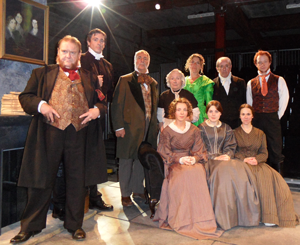 I’d been fortunate enough to see the dress rehearsal the afternoon before, so I was really looking forward to the butterfly emerging from the chrysalis that evening at the premiere which followed my talk. I’d had serious misgivings about the whole concept of superimposing the Brontës’ life story on to Chekhov’s play The Three Sisters but the final version is far more Brontë than Chekhov. The script cleverly but unobtrusively weaves the Brontës’ own words from their letters, diaries, poems and novels into the dialogue and the actors have triumphantly breathed life into the characters they inhabit. My biographical instincts might still be set on edge by Mrs Robinson staying at the Parsonage and the playing fast and loose with the chronology but, caught up in the moment as I watched the play, I simply forgot them. (Oh, the shame!) It was impossible not to be emotionally engaged. The rewritten ending even had me in tears. The play is a triumph and if you can’t buy a ticket, then beg, steal or borrow one!”
I’d been fortunate enough to see the dress rehearsal the afternoon before, so I was really looking forward to the butterfly emerging from the chrysalis that evening at the premiere which followed my talk. I’d had serious misgivings about the whole concept of superimposing the Brontës’ life story on to Chekhov’s play The Three Sisters but the final version is far more Brontë than Chekhov. The script cleverly but unobtrusively weaves the Brontës’ own words from their letters, diaries, poems and novels into the dialogue and the actors have triumphantly breathed life into the characters they inhabit. My biographical instincts might still be set on edge by Mrs Robinson staying at the Parsonage and the playing fast and loose with the chronology but, caught up in the moment as I watched the play, I simply forgot them. (Oh, the shame!) It was impossible not to be emotionally engaged. The rewritten ending even had me in tears. The play is a triumph and if you can’t buy a ticket, then beg, steal or borrow one!”
.............................................................................................................................................................................................
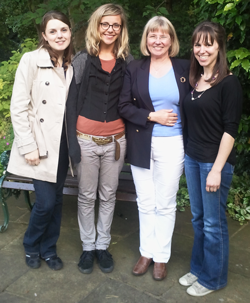 Tuesday 21st July 2011:"It’s not every day you get the chance to have your photo taken with the three Brontë sisters but here I am in the garden at the Brontë Parsonage Museum with Anne, Emily and, on the right, Charlotte. (It’s also not every day I’m actually almost the same height as everyone else!) We were in Haworth as part of a small audience for a read-through of Blake Morrison’s new adaptation of Chekhov’s Three Sisters which he has transposed to nineteenth century Yorkshire by turning the three heroines into the Brontë sisters. Some people apparently believe that when Chekhov was writing his original play he was influenced by reading Mrs Gaskell’s biography of Charlotte. Personally I doubt that very much but it’s an interesting concept and Morrison has cleverly drawn on Brontë autobiographical material to flesh out the characters of the three sisters and reshape the play (more or less) to reflect their lives. There’s a hefty dollop of artistic licence – my biographer’s instincts were particularly set on edge by the idea of Mrs Robinson actually staying with the Brontës at the Parsonage – but there’s no denying that it places her affair with Branwell centre stage in a way that would not otherwise be possible. Naturally, a combination of Chekhov and Brontë means a hefty double dose of doom and gloom but, given the period it’s set, this isn’t as anachronistic as it might be. And there’s plenty of laughter in the script to lighten the load. I’m a huge fan of Northern Broadsides and it was a privilege to be present at the read-through to see the germ of an idea taking shape and having life breathed into it. I was obviously not alone in thinking that Barrie Rutter’s going to have another hit on his hands when the play opens in September. It’s an indication of Blake Morrison’s clever use of the Brontë’s own words that it’s called ‘We are three sisters’, which is actually what Charlotte said on her first introduction to her London publisher George Smith. Book a ticket if you can."
Tuesday 21st July 2011:"It’s not every day you get the chance to have your photo taken with the three Brontë sisters but here I am in the garden at the Brontë Parsonage Museum with Anne, Emily and, on the right, Charlotte. (It’s also not every day I’m actually almost the same height as everyone else!) We were in Haworth as part of a small audience for a read-through of Blake Morrison’s new adaptation of Chekhov’s Three Sisters which he has transposed to nineteenth century Yorkshire by turning the three heroines into the Brontë sisters. Some people apparently believe that when Chekhov was writing his original play he was influenced by reading Mrs Gaskell’s biography of Charlotte. Personally I doubt that very much but it’s an interesting concept and Morrison has cleverly drawn on Brontë autobiographical material to flesh out the characters of the three sisters and reshape the play (more or less) to reflect their lives. There’s a hefty dollop of artistic licence – my biographer’s instincts were particularly set on edge by the idea of Mrs Robinson actually staying with the Brontës at the Parsonage – but there’s no denying that it places her affair with Branwell centre stage in a way that would not otherwise be possible. Naturally, a combination of Chekhov and Brontë means a hefty double dose of doom and gloom but, given the period it’s set, this isn’t as anachronistic as it might be. And there’s plenty of laughter in the script to lighten the load. I’m a huge fan of Northern Broadsides and it was a privilege to be present at the read-through to see the germ of an idea taking shape and having life breathed into it. I was obviously not alone in thinking that Barrie Rutter’s going to have another hit on his hands when the play opens in September. It’s an indication of Blake Morrison’s clever use of the Brontë’s own words that it’s called ‘We are three sisters’, which is actually what Charlotte said on her first introduction to her London publisher George Smith. Book a ticket if you can."
.............................................................................................................................................................................................
Saturday 6th July 2011: "Sometimes you wonder whether it’s worth it. Yesterday’s journey from a grey and grizzly Yorkshire to an equally damp Devon took over seven and a half hours. Solid traffic on all the main routes and even the motorways constantly grinding to a complete halt. No-one in their right mind would choose to travel to Devon on a Friday at the beginning of the school holidays. I certainly wouldn’t – but then I’d foolishly agreed to swap my slot at the Ways With Words festival at Dartington with Rachel Johnson, and landed the worst possible day for travelling down. We arrived just in time for dinner –and I mean ‘just’ – everyone was already gathered in the wonderful medieval solar which serves as the dining room of Dartington Hall and we were the last to take our places. A quick room check revealed a plethora of politicians – well, two, Michael Meacher and Shirley Williams, but that’s two too many for my liking – plus Margaret Drabble, Bethany Hughes and Lucy Worsley, which was more like it. Things could only get better!
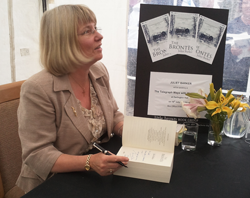 Which of course they did as Ways With Words at Dartington is one of the highlights of the literary year. My event was in the medieval Great Hall, one of my favourite venues on the entire circuit, and it was packed to the rafters – the balcony anyway. Talking about the Brontës always evokes a good response and this time was no different. A barrage of questions after the talk was followed by another during the signing session which went on so long that I almost missed lunch which would have been a catastrophe. (Strange how Ways With Words festivals revolve around meals – or is it just me?) Fortunately, the catering staff had plated up a spare meal for me, so I didn’t go without. And I had a highly successful shopping spree among the second-hand and antiquarian bookstalls, acquiring several works I’d been looking for for ages and, triumph of all triumphs, a page from a missal produced in Rouen in 1450, just as the English Kingdom of France was on the point of collapse! And to cap it all, back home in less than four hours. Roll on Ways With Words at Southwold is all I can say!"
Which of course they did as Ways With Words at Dartington is one of the highlights of the literary year. My event was in the medieval Great Hall, one of my favourite venues on the entire circuit, and it was packed to the rafters – the balcony anyway. Talking about the Brontës always evokes a good response and this time was no different. A barrage of questions after the talk was followed by another during the signing session which went on so long that I almost missed lunch which would have been a catastrophe. (Strange how Ways With Words festivals revolve around meals – or is it just me?) Fortunately, the catering staff had plated up a spare meal for me, so I didn’t go without. And I had a highly successful shopping spree among the second-hand and antiquarian bookstalls, acquiring several works I’d been looking for for ages and, triumph of all triumphs, a page from a missal produced in Rouen in 1450, just as the English Kingdom of France was on the point of collapse! And to cap it all, back home in less than four hours. Roll on Ways With Words at Southwold is all I can say!"
.............................................................................................................................................................................................
Tuesday 21st June 2011: "Another trip to the Great Wen. This time to record A Good Read for BBC Radio 4. I was particularly pleased to be asked again as I knew immediately which book I’d choose – Jude Morgan’s wonderful Brontë novel (with a dreadful title) The Taste of Sorrow. 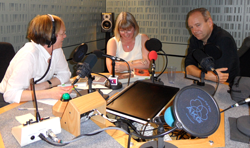 On the last occasion I’d picked T H White’s The Once and Future King, which is still one of my all-time favourite books – though I was somewhat embarrassed that, because it was too long, only the first part was chosen for the programme. I actually prefer the later, darker, much longer second section but the first part was originally written as a stand-alone book so I suppose it made sense to focus on it. Brilliant it is too, but it was written as a children’s book, which didn’t really sit well with Martha Kearney’s choice (Malcolm Lowry’s Under the Volcano) or Justin Cartwright’s selection (W G Sebald’s Austerlitz). I found them both heavy going, depressing and unsatisfying. However, the great joy of doing A Good Read is that at least it gives me an excuse to read outside my work and it introduces me to books I’d never normally choose to read. This time I loved all three books – though obviously the one I was championing most of all.
On the last occasion I’d picked T H White’s The Once and Future King, which is still one of my all-time favourite books – though I was somewhat embarrassed that, because it was too long, only the first part was chosen for the programme. I actually prefer the later, darker, much longer second section but the first part was originally written as a stand-alone book so I suppose it made sense to focus on it. Brilliant it is too, but it was written as a children’s book, which didn’t really sit well with Martha Kearney’s choice (Malcolm Lowry’s Under the Volcano) or Justin Cartwright’s selection (W G Sebald’s Austerlitz). I found them both heavy going, depressing and unsatisfying. However, the great joy of doing A Good Read is that at least it gives me an excuse to read outside my work and it introduces me to books I’d never normally choose to read. This time I loved all three books – though obviously the one I was championing most of all.
The other guest, the comedian and satirist John O’Farrell, chose The Report by Jessica Francis Kane, a novel about the 1943 Bethnal Green disaster, when 173 people were crushed or suffocated to death at the entrance of the tube station as they tried to take refuge when the air raid sirens went off. It sounds a totally depressing subject but Kane treats it with immense sympathy and sensitivity and includes a wealth of authentic detail which really brought the experience of being in the East End during the Blitz to life. Amazingly, given her understanding of place and period, she’s actually an American. The programme’s host, Harriet Gilbert, chose another book I’d never heard of – The Panther in the Basement by Amos Oz, a novel about a young boy growing up in Jerusalem in the summer of 1947, just before the partition of Palestine into the separate Jewish and Arab states. More properly a novelette, it had a much less compelling storyline, but was an interesting exploration of the idea of betrayal (the boy befriends a soldier from the British occupying force and teaches him Hebrew in exchange for lessons in English) and a wonderful use of language: I particularly loved Oz’s description of the English present continuous tense ‘in which every verb ends with a sound like the touch of glass on glass: ing.’
 Sitting in reception at the BBC in Portland Place is always an opportunity to play ‘spot the famous face’ and this time I was thrilled to see one of my favourite authors, Alan Bennett, who was waiting just a few feet away from me. Sitting in a nearby bistro after recording the programme with Harriet and the producer, Beth O’Dea, I had a less life-enhancing experience. I discovered that the reason why I felt peculiarly immobile was that I had sat on a piece of discarded chewing gum. BBC producers have many unenviable jobs to perform but scraping gum off the backside of one of your studio guests must have been an all-time low for poor Beth. Not sure which of us had the more undignified role. Why do these things always happen to me? I can’t imagine it happening to Alan Bennett.
Sitting in reception at the BBC in Portland Place is always an opportunity to play ‘spot the famous face’ and this time I was thrilled to see one of my favourite authors, Alan Bennett, who was waiting just a few feet away from me. Sitting in a nearby bistro after recording the programme with Harriet and the producer, Beth O’Dea, I had a less life-enhancing experience. I discovered that the reason why I felt peculiarly immobile was that I had sat on a piece of discarded chewing gum. BBC producers have many unenviable jobs to perform but scraping gum off the backside of one of your studio guests must have been an all-time low for poor Beth. Not sure which of us had the more undignified role. Why do these things always happen to me? I can’t imagine it happening to Alan Bennett.
You can hear the programme on BBC Radio 4 at 4.30pm on Tuesday 12th July and repeated at 11pm on Friday 15th July: it will be downloadable as a podcast and available on BBC i/player for a week after first broadcast."
.............................................................................................................................................................................................
Monday 9th May 2011: “Today my programme ‘Gone today, hair tomorrow’ was broadcast on BBC Radio 4. I ought to have listened to it, of course, but there’s something very odd about listening to yourself on the radio or watching yourself on television, and it always takes me some time to pluck up the courage to do so. For that reason I always record and usually (but not always) come back to it later. I was fascinated, however, to get a prompt e-mail response from Ashley Cooke at the World Museum in Liverpool praising the programme and telling me about the curious 3300-year-old clay balls containing hair in the museum’s Egyptian collection: they were excavated by British archaeologists working in the royal city of Tell el-Amarna in the 1930s. I wish I’d known about them when I was making the programme!
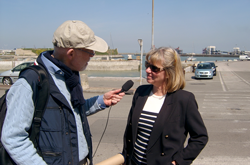 Last week I was also in foreign parts, recording another programme for Radio 4, this time about William Wordsworth and the trip he made to Calais in 1802. The programme was instigated by John Worthen, the D H Lawrence specialist and author of The Gang: Coleridge, the Wordsworths and the Hutchinsons in 1802 which I reviewed favourably (phew!) when it was published in 2001. The reason for the Calais trip has always been shrouded in mystery. Ostensibly it was for a first meeting between William and Dorothy and Caroline, his nine-year-old daughter by his French mistress Annette Vallon. (William and Annette had parted in 1792, only a few months after their first meeting and before Caroline’s birth; the outbreak of war between England and France in January 1793 had prevented William’s return until the fragile Peace of Amiens in 1802 created the first opportunity for him to do so.) I’d always thought the reason for the visit was because William wanted to make some sort of settlement with Annette before he married Mary Hutchinson. John was intrigued by the fact that Coleridge had expected William and Dorothy to stay in Calais for only ten days, whereas they eventually spent almost the whole month of August. We had great fun exploring possible reasons for the extended stay – the photo shows us deep in discussion – but you’ll have to wait for the broadcast to find out our conclusions!
Last week I was also in foreign parts, recording another programme for Radio 4, this time about William Wordsworth and the trip he made to Calais in 1802. The programme was instigated by John Worthen, the D H Lawrence specialist and author of The Gang: Coleridge, the Wordsworths and the Hutchinsons in 1802 which I reviewed favourably (phew!) when it was published in 2001. The reason for the Calais trip has always been shrouded in mystery. Ostensibly it was for a first meeting between William and Dorothy and Caroline, his nine-year-old daughter by his French mistress Annette Vallon. (William and Annette had parted in 1792, only a few months after their first meeting and before Caroline’s birth; the outbreak of war between England and France in January 1793 had prevented William’s return until the fragile Peace of Amiens in 1802 created the first opportunity for him to do so.) I’d always thought the reason for the visit was because William wanted to make some sort of settlement with Annette before he married Mary Hutchinson. John was intrigued by the fact that Coleridge had expected William and Dorothy to stay in Calais for only ten days, whereas they eventually spent almost the whole month of August. We had great fun exploring possible reasons for the extended stay – the photo shows us deep in discussion – but you’ll have to wait for the broadcast to find out our conclusions!
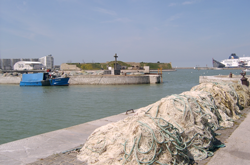 Calais itself was disappointing in terms of Wordsworthian links, most of it having been destroyed in the course of the two World Wars. We talked at length to the charming and extremely knowledgeable Philippe Cassez, a president of the local history society for many years, who showed us the former Rue de la Tête d’Or, where the Wordsworths lodged, which is now the modern and deeply undistinguished Rue Charles Ravisse; the site of the old town walls and their gates, which didn’t open till 8am, hence the Wordsworths being oblige to wait on their overnight boat till 7.30 in the morning before disembarking; and the Old Port (pictured) where their boat sailed to and from – a picturesque corner of Calais, with the old fort in the background, now dwarfed by the cross Channel ferry terminal immediately behind them. We had sailed in on the spanking new Spirit of Britain ferry, a journey of just 90 minutes; it took the Wordsworths 13 hours and there’s a heart-felt entry in Dorothy’s journal ‘I was sick all the way’. Some things do change for the better.”
Calais itself was disappointing in terms of Wordsworthian links, most of it having been destroyed in the course of the two World Wars. We talked at length to the charming and extremely knowledgeable Philippe Cassez, a president of the local history society for many years, who showed us the former Rue de la Tête d’Or, where the Wordsworths lodged, which is now the modern and deeply undistinguished Rue Charles Ravisse; the site of the old town walls and their gates, which didn’t open till 8am, hence the Wordsworths being oblige to wait on their overnight boat till 7.30 in the morning before disembarking; and the Old Port (pictured) where their boat sailed to and from – a picturesque corner of Calais, with the old fort in the background, now dwarfed by the cross Channel ferry terminal immediately behind them. We had sailed in on the spanking new Spirit of Britain ferry, a journey of just 90 minutes; it took the Wordsworths 13 hours and there’s a heart-felt entry in Dorothy’s journal ‘I was sick all the way’. Some things do change for the better.”
.............................................................................................................................................................................................
Wednesday 20th April 2011: “Just back from Stratford-upon-Avon where we’ve spent two days enjoying not just the glorious weather but also the glories of the newly revamped RSC theatre. 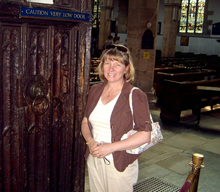 When I were a lass, said she reverting to the broad Yorkshire of her youth, the theatre was a vast, ugly mausoleum of a place. Sitting up in the gods at the back was rather like watching television as the stage was so far away. Nevertheless, we saw some unforgettable productions – Alan Howard in Henry V, Timothy Dalton and Estelle Kohler in Romeo and Juliet to name but two. The ‘new’ theatre retains its ghastly fascist exterior, with the addition of an ugly and unnecessary viewing tower which looks more like those you find in fire stations rather than the more appropriate medieval Italian style it could have been, but there is now a lovely terrace allowing you to walk along the riverside to the church where Shakespeare is buried. (The medieval sanctuary knocker on the church door was of particular interest to me as you can see from the photograph).
When I were a lass, said she reverting to the broad Yorkshire of her youth, the theatre was a vast, ugly mausoleum of a place. Sitting up in the gods at the back was rather like watching television as the stage was so far away. Nevertheless, we saw some unforgettable productions – Alan Howard in Henry V, Timothy Dalton and Estelle Kohler in Romeo and Juliet to name but two. The ‘new’ theatre retains its ghastly fascist exterior, with the addition of an ugly and unnecessary viewing tower which looks more like those you find in fire stations rather than the more appropriate medieval Italian style it could have been, but there is now a lovely terrace allowing you to walk along the riverside to the church where Shakespeare is buried. (The medieval sanctuary knocker on the church door was of particular interest to me as you can see from the photograph).
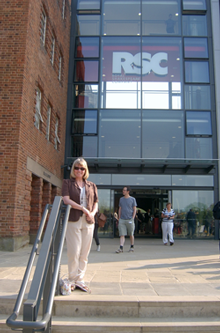 More importantly, the interior is transformed. Like the Courtyard Theatre which replaced it during its closure, and the smaller Swan Theatre in the same complex, it now has an apron stage with entries and exits leading off into the audience which virtually surrounds it. The advantage, apart from its greater authenticity as a Shakespearean theatre, is that the actors are so close you can literally feel the draught of their clothes as they sweep on and off the stage (and get showered with spit if you’re too close). The main disadvantage, as our party discovered, is that if you’re sat behind a couple of very large Americans or one of the gallery pillars, your view is considerably restricted.
More importantly, the interior is transformed. Like the Courtyard Theatre which replaced it during its closure, and the smaller Swan Theatre in the same complex, it now has an apron stage with entries and exits leading off into the audience which virtually surrounds it. The advantage, apart from its greater authenticity as a Shakespearean theatre, is that the actors are so close you can literally feel the draught of their clothes as they sweep on and off the stage (and get showered with spit if you’re too close). The main disadvantage, as our party discovered, is that if you’re sat behind a couple of very large Americans or one of the gallery pillars, your view is considerably restricted.
We saw two plays. A rather weird staging of Macbeth with a terrific Edward Slinger in the title role – cold, calculating and chillingly murderous – but a supporting cast that didn’t always match his presence or clarity of diction. I couldn’t shake off the irritating conviction that Banquo, though excellently played by Steve Toussaint, unfortunately looked like he’d strayed off the set of Pirates of the Caribbean, particularly after he returned as a ghost. And I couldn’t decide whether replacing the three witches with the ghosts of the murdered children of Macduff worked or not: it certainly made their murder more chilling, especially when the little girl was led off stage in silence, but until that point it wasn’t clear who they were meant to be. And, rather pathetically, I did miss the ‘Hubble, bubble, toil and trouble’ speech, which had been cut as it was irrelevant to ghosts rather than witches.
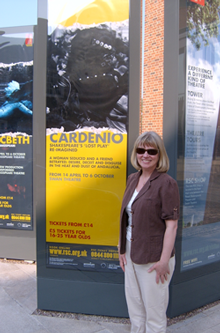 The following day we saw Cardenio to which, I confess, I was not looking forward with any enthusiasm. A supposed ‘lost’ play of Shakespeare’s resurrected and re-imagined didn’t have much appeal to me: it sounded more like cashing in on the Shakespeare name rather than a genuine attempt to stage a play worth doing so in its own right. How wrong I was! After seeing it and reading the programme cover to cover I was still none the wiser as to who had actually written the script but the play itself was mesmerising. Veering deftly between moments of high comedy and tragedy and beautifully staged and set in early seventeenth century Spain, it never failed to engage. The cast was faultless, from Alex Hassell, who gave a virtuoso performance as the villainous Don Fernando with a sly humour that meant he never completely lost the audience’s empathy, to the wronged Cardenio, played by Oliver Rix with a touching innocence which made his descent into madness all the more moving (in more ways that one as we almost jumped out of our seats when he flung himself across the stage with such gusto that he almost landed on our laps). Christopher Godwin even managed to turn Don Camillo, the conventional stuffed shirt and prig of a brother who sorts out the mess, into a believable and engaging character. Lucy Briggs-Owen and Pippa Nixon also succeeded in rising above the conventional role of the wronged women to give feisty and very different performances. It was an outstanding production in every way and, we all agreed, one of the best theatrical experiences we had ever experienced. Long live Shakespeare’s ‘lost’ plays – well, Cardenio, anyway!”
The following day we saw Cardenio to which, I confess, I was not looking forward with any enthusiasm. A supposed ‘lost’ play of Shakespeare’s resurrected and re-imagined didn’t have much appeal to me: it sounded more like cashing in on the Shakespeare name rather than a genuine attempt to stage a play worth doing so in its own right. How wrong I was! After seeing it and reading the programme cover to cover I was still none the wiser as to who had actually written the script but the play itself was mesmerising. Veering deftly between moments of high comedy and tragedy and beautifully staged and set in early seventeenth century Spain, it never failed to engage. The cast was faultless, from Alex Hassell, who gave a virtuoso performance as the villainous Don Fernando with a sly humour that meant he never completely lost the audience’s empathy, to the wronged Cardenio, played by Oliver Rix with a touching innocence which made his descent into madness all the more moving (in more ways that one as we almost jumped out of our seats when he flung himself across the stage with such gusto that he almost landed on our laps). Christopher Godwin even managed to turn Don Camillo, the conventional stuffed shirt and prig of a brother who sorts out the mess, into a believable and engaging character. Lucy Briggs-Owen and Pippa Nixon also succeeded in rising above the conventional role of the wronged women to give feisty and very different performances. It was an outstanding production in every way and, we all agreed, one of the best theatrical experiences we had ever experienced. Long live Shakespeare’s ‘lost’ plays – well, Cardenio, anyway!”
.............................................................................................................................................................................................
 Wednesday 15th March 2011: “I can’t believe it’s already a week ago today since I bade a fond farewell to Keswick. Ways by the Water is probably my favourite literary festival but the auguries were not promising this year. We set off from home in a snow storm, holding our breath as we crawled at snail’s pace over the ungritted moorland roads and wondering what on earth would greet us when we reached the Lakes – if we reached the Lakes. Fortunately, the Pennines had received the brunt of the weather and by the time we got to Keswick (cutting it a bit too fine for my liking) it was just bitterly cold, wet and windy. I raced into the theatre, changed in the Green Room, and before I’d had time to draw breath was on stage in the Theatre by the Lake. The Keswick audience is always kind but it was gratifying that my Brontë talk got such a rapturous reception – even though there were so many books to sign afterwards that I almost missed my lunch. Not something any self-respecting Yorkshirewoman should do, especially since it was free. I took my revenge on the host for my event, the affable Stephen Matthews, by demanding that he sign the copy of his book on King Arthur which he had very kindly given me.
Wednesday 15th March 2011: “I can’t believe it’s already a week ago today since I bade a fond farewell to Keswick. Ways by the Water is probably my favourite literary festival but the auguries were not promising this year. We set off from home in a snow storm, holding our breath as we crawled at snail’s pace over the ungritted moorland roads and wondering what on earth would greet us when we reached the Lakes – if we reached the Lakes. Fortunately, the Pennines had received the brunt of the weather and by the time we got to Keswick (cutting it a bit too fine for my liking) it was just bitterly cold, wet and windy. I raced into the theatre, changed in the Green Room, and before I’d had time to draw breath was on stage in the Theatre by the Lake. The Keswick audience is always kind but it was gratifying that my Brontë talk got such a rapturous reception – even though there were so many books to sign afterwards that I almost missed my lunch. Not something any self-respecting Yorkshirewoman should do, especially since it was free. I took my revenge on the host for my event, the affable Stephen Matthews, by demanding that he sign the copy of his book on King Arthur which he had very kindly given me.
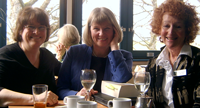 Having done my duty, I was free to relax and enjoy the bounties of Ways by the Water, catching up with old friends Ann Motteshead, who was at Oxford with me, and Vicki Robinson, the driving force behind the building of the magnificent Theatre by the Lake (see photo). In the evening we dined with an eclectic group which included Roy Hattersley, Emma Bridgewater and her husband Matthew Rice, and Luke Jennings. Where else could you meet round one table a politician, a potter, a painter and a ballet dancer turned dance critic? Oh, and I even found time to attend highly entertaining talks on equally disparate subjects by Simon Sebag Montefiore (Jerusalem), Justine Picardie (Coco Chanel) and Francis Spufford (Red Plenty).
Having done my duty, I was free to relax and enjoy the bounties of Ways by the Water, catching up with old friends Ann Motteshead, who was at Oxford with me, and Vicki Robinson, the driving force behind the building of the magnificent Theatre by the Lake (see photo). In the evening we dined with an eclectic group which included Roy Hattersley, Emma Bridgewater and her husband Matthew Rice, and Luke Jennings. Where else could you meet round one table a politician, a potter, a painter and a ballet dancer turned dance critic? Oh, and I even found time to attend highly entertaining talks on equally disparate subjects by Simon Sebag Montefiore (Jerusalem), Justine Picardie (Coco Chanel) and Francis Spufford (Red Plenty).
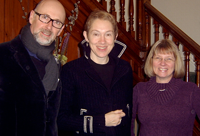 It was an especial pleasure to catch up with my dear friend Justine, who is always as elegantly dressed as her subject, even when about to dash off for her train. Compare and contrast with the not so elegant Mrs Barker (see photo with Justine and Luke Jennings). Memo to self: must stop having my photo taken with tall people: it makes me look even more like a hobbit.
Today, I’ve just returned from an even more self-indulgent afternoon having a selection of my favourite pieces of music played on One on One, a programme broadcast by BBC Radio Leeds. I had to sing for my supper (metaphorically speaking) since I also had to talk about my life (as briefly as I could decently do) and about my work, a subject I can talk about endlessly. My interview, Liz Green, was genuinely interested in the Brontës, so, for me at least, it turned into a pleasant chat between two Brontë fans. If you missed it, you can catch it again when it’s repeated on Sunday 20th March at 12 noon, or you can listen again on i-player for the next week. Unfortunately I forgot to take my camera, so there’s no photo for this one!
It was an especial pleasure to catch up with my dear friend Justine, who is always as elegantly dressed as her subject, even when about to dash off for her train. Compare and contrast with the not so elegant Mrs Barker (see photo with Justine and Luke Jennings). Memo to self: must stop having my photo taken with tall people: it makes me look even more like a hobbit.
Today, I’ve just returned from an even more self-indulgent afternoon having a selection of my favourite pieces of music played on One on One, a programme broadcast by BBC Radio Leeds. I had to sing for my supper (metaphorically speaking) since I also had to talk about my life (as briefly as I could decently do) and about my work, a subject I can talk about endlessly. My interview, Liz Green, was genuinely interested in the Brontës, so, for me at least, it turned into a pleasant chat between two Brontë fans. If you missed it, you can catch it again when it’s repeated on Sunday 20th March at 12 noon, or you can listen again on i-player for the next week. Unfortunately I forgot to take my camera, so there’s no photo for this one!
.............................................................................................................................................................................................
Wednesday 2nd March 2011: “Back to the BBC in Manchester again today to put the finishing touches to my radio programme ‘Gone Today, Hair Tomorrow’. 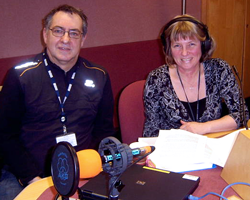 In fact, as I realised on the way there, this will probably also be my final visit to the BBC’s base in Oxford Road as the move to Salford is now so imminent. Already there’s an atmosphere of transience and end of era. There’s not half the bustle there used to be – the foyer’s virtually deserted and you can walk down the corridors without meeting a soul. The business today was recording the voice-overs which will link the various interviews. Luckily for me, all I had to do was read out my script and go home: Kevin Mousley, the producer, has all the hard work to do afterwards, putting the whole thing together as a coherent, seamless and – I hope – fascinating programme. Listen out for it on BBC Radio 4 on Monday May 9th at 11am.
In fact, as I realised on the way there, this will probably also be my final visit to the BBC’s base in Oxford Road as the move to Salford is now so imminent. Already there’s an atmosphere of transience and end of era. There’s not half the bustle there used to be – the foyer’s virtually deserted and you can walk down the corridors without meeting a soul. The business today was recording the voice-overs which will link the various interviews. Luckily for me, all I had to do was read out my script and go home: Kevin Mousley, the producer, has all the hard work to do afterwards, putting the whole thing together as a coherent, seamless and – I hope – fascinating programme. Listen out for it on BBC Radio 4 on Monday May 9th at 11am.
 As if my foray into the media wasn’t enough to turn my head, I’ve just had my portrait painted! Not that I knew anything about it, mind. And it’s been painted by someone who’s never even met me. Peter Collins, who lives in Chicago, contacted me via the website to enquire about the new edition of The Brontës and, after an exchange of e-mails, the next thing I know is that there’s a portrait of me in my inbox. It was certainly unexpected but it’s also extremely good, which is why I thought it worth sharing with my blog readers. He very kindly gave me his permission to reproduce it – so long as I admitted that Mybug was indeed correct in his belief that Branwell wrote all the Brontë novels. Much as I love Cold Comfort Farm, I couldn’t quite bring myself to do this, so, as instructed, I’ve used Peter’s signed version instead.”
As if my foray into the media wasn’t enough to turn my head, I’ve just had my portrait painted! Not that I knew anything about it, mind. And it’s been painted by someone who’s never even met me. Peter Collins, who lives in Chicago, contacted me via the website to enquire about the new edition of The Brontës and, after an exchange of e-mails, the next thing I know is that there’s a portrait of me in my inbox. It was certainly unexpected but it’s also extremely good, which is why I thought it worth sharing with my blog readers. He very kindly gave me his permission to reproduce it – so long as I admitted that Mybug was indeed correct in his belief that Branwell wrote all the Brontë novels. Much as I love Cold Comfort Farm, I couldn’t quite bring myself to do this, so, as instructed, I’ve used Peter’s signed version instead.”
.............................................................................................................................................................................................
Wednesday 16th February 2011: “Every now and then my work schedule is turned upside down by an unexpected offer of media work. I love radio (much more intimate than television and no need to worry about how I look!) and especially Radio 4, so it was a major thrill to get a commission to make a programme. 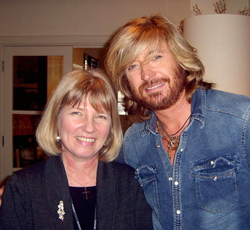 The idea was pitched so long ago that I’d almost forgotten about it, then suddenly, in typically BBC fashion, it’s all systems go and everything has to be done immediately. So the last two weeks and more have been spent thinking, researching, writing, even dreaming about – hair. Yes, hair. Which is pretty ironic since I needed a haircut myself before I began work on the programme and my need is now dire. And one of the people I interviewed was Nicky Clarke, the celebrity hairdresser, (see photo left) who was utterly charming and lives in the sort of impossibly glamorous house you only see in the pages of magazines – but is not necessarily the person you want to meet when you’re in need of a haircut.
The idea was pitched so long ago that I’d almost forgotten about it, then suddenly, in typically BBC fashion, it’s all systems go and everything has to be done immediately. So the last two weeks and more have been spent thinking, researching, writing, even dreaming about – hair. Yes, hair. Which is pretty ironic since I needed a haircut myself before I began work on the programme and my need is now dire. And one of the people I interviewed was Nicky Clarke, the celebrity hairdresser, (see photo left) who was utterly charming and lives in the sort of impossibly glamorous house you only see in the pages of magazines – but is not necessarily the person you want to meet when you’re in need of a haircut.
So why hair? Well, I’ve been fascinated by hair jewellery since I first encountered it when I worked at the Brontë Parsonage Museum: the collection there includes locks of the family’s hair but also brooches, bracelets and necklaces made out of the sisters’ hair. I knew that hair jewellery was popular in the days before photography – both as a love token and for mourning – but what Kevin Mousley (the producer) and I’ve discovered over the course of our rapid induction in the subject is quite extraordinary. We’ve talked to an American man who has collected 150 locks of famous hair, from Abe Lincoln to Neil Armstrong; an American lady who runs the world’s only hair museum with over 2000 items dating as far back as 1680; 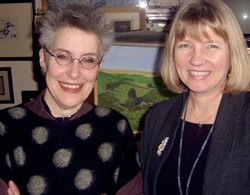 a young Swedish practitioner of the art who is still making the same hairwork jewellery as her forebears in the early nineteenth century. The skill required to make such things – and the beauty of some of the finished objects – was a revelation. And as is always the way with radio, we got to meet some fascinating people, including Andy Wilson, a forensic and archaeological scientist, who’s analysed hair samples from mummies and Inca human sacrifices, as well as modern day murder victims, and Ruth Richardson (pictured right), a medical historian who’s made a study of mourning customs and is currently battling to save the Cleveland Street workhouse which was close to Charles Dickens’s home and probably inspired the descriptions in Oliver Twist – you can see her article on the subject if you follow the link http://charlesdickenspage.com/ruth_richardson-cleveland_street_workhouse.html.
a young Swedish practitioner of the art who is still making the same hairwork jewellery as her forebears in the early nineteenth century. The skill required to make such things – and the beauty of some of the finished objects – was a revelation. And as is always the way with radio, we got to meet some fascinating people, including Andy Wilson, a forensic and archaeological scientist, who’s analysed hair samples from mummies and Inca human sacrifices, as well as modern day murder victims, and Ruth Richardson (pictured right), a medical historian who’s made a study of mourning customs and is currently battling to save the Cleveland Street workhouse which was close to Charles Dickens’s home and probably inspired the descriptions in Oliver Twist – you can see her article on the subject if you follow the link http://charlesdickenspage.com/ruth_richardson-cleveland_street_workhouse.html.
Nothing to do with hair, but a worthwhile cause nevertheless.
The programme’s going out on BBC Radio 4 at 11am on Monday 9th May. It’s called ‘Gone Today, Hair Tomorrow’, a title for which I am glad to say I am not responsible. Blame Kevin – I do.
.............................................................................................................................................................................................
Thursday 13th January 2011: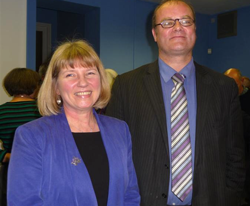 “After several months of immersion in the Brontës (of which more later) it was something of a mental effort to do an about-turn and retreat several hundred years into the fifteenth century. It was also, unexpectedly, something of a physical effort to get to Birkdale School at Sheffield, where I was to give a talk on Conquest to the local branch of the Historical Association. A journey of just over an hour turned into a marathon two hours, which did nothing for my stress levels, but the event itself went off very smoothly in a packed lecture theatre. An appreciative audience and the genial hosting of Mike Clarke, the Head of History at the school, (pictured with me on the left – lucky pupils to have such an enthusiast as their teacher!) made it a very enjoyable evening.
“After several months of immersion in the Brontës (of which more later) it was something of a mental effort to do an about-turn and retreat several hundred years into the fifteenth century. It was also, unexpectedly, something of a physical effort to get to Birkdale School at Sheffield, where I was to give a talk on Conquest to the local branch of the Historical Association. A journey of just over an hour turned into a marathon two hours, which did nothing for my stress levels, but the event itself went off very smoothly in a packed lecture theatre. An appreciative audience and the genial hosting of Mike Clarke, the Head of History at the school, (pictured with me on the left – lucky pupils to have such an enthusiast as their teacher!) made it a very enjoyable evening.
As my new edition of The Brontës was waiting in the wings to be published and the contract for my next book was being processed, I decided to accept a commission to write an afterword for Penguin’s latest American edition of Wuthering Heights. Re-reading Emily’s extraordinary novel I was reminded once again of just how shocking it must have appeared to contemporary readers – and why it seems unbelievable, even now, that it was written not just by a woman, but by a pathologically shy, outwardly unremarkable parson’s daughter who spent virtually all her brief and uneventful life in an obscure corner of Yorkshire where her talents were not even guessed at, let alone appreciated. What struck me even more, however, was the debt her imagination owed to Walter Scott. It is well-known that her sister Charlotte had been unwavering in her devotion to the duke of Wellington, the hero and inspiration for her childhood writings: it has not been appreciated that Emily was equally devoted to Scott and that his novels and poetry shaped her writings in exactly the same way. As a nine-year-old she demonstrated her independence from her siblings, who all chose English politicians and islands for their play of The Islanders, by opting for Scott and the Scottish Isle of Arran. Gondal and its wilful, beautiful and ill-fated queen found its model in Scott’s history of Scotland, Tales of a Grandfather, with its vivid depiction of the reign of Mary Queen of Scots. And if you’re seeking the ultimate progenitor of Wuthering Heights you need look no further than Scott’s novels, particularly Rob Roy.
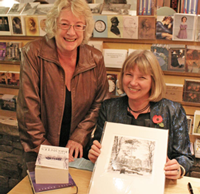 One of the things I forgot to mention about the launch of the new edition of The Brontës was that I was privileged to meet Helen Burrow, the lady who took the photograph which has been used on its front cover. She very kindly presented me with a print of her photograph which now enjoys pride of place in my study. Her husband George took this photo of us together at the Parsonage.”
One of the things I forgot to mention about the launch of the new edition of The Brontës was that I was privileged to meet Helen Burrow, the lady who took the photograph which has been used on its front cover. She very kindly presented me with a print of her photograph which now enjoys pride of place in my study. Her husband George took this photo of us together at the Parsonage.”
.............................................................................................................................................................................................
Friday 12th November 2010: “From one literary shrine to another – on Tuesday I was at Rydal Mount, this evening I was at the Brontë Parsonage to celebrate the launch of my new edition of The Brontës. It’s been a long time coming – sixteen years since it was first published and twenty-one since I first began my research – but it has finally come of age. 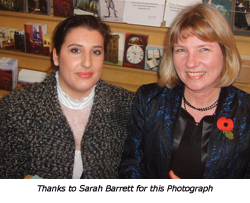 The Brontë Society kindly hosted the evening and we had a packed house in the schoolroom on Church Lane for my lecture. I thought I was going to get away without any questions (and get to the champagne quicker) but I should have known better – I was well and truly grilled by a highly knowledgeable audience. I’ve always enjoyed this part of an event better than actually speaking, but for once there was also a party to attend! The museum was open for the evening but I didn’t get a chance to go round as I spent the next hour and more fielding further questions and signing copies continuously. It was great fun – but also quite humbling to discover how far some people had travelled to attend the launch. There were quite a few from the Home Counties but the prize had to go to the lady who’d come all the way from the States! Her daughter, who now lives in London had visited the museum a few weeks earlier, seen the event advertised and decided that they had to be there! It was a hugely successful evening and I’m grateful to everyone at the Parsonage who worked so hard to make it happen.”
The Brontë Society kindly hosted the evening and we had a packed house in the schoolroom on Church Lane for my lecture. I thought I was going to get away without any questions (and get to the champagne quicker) but I should have known better – I was well and truly grilled by a highly knowledgeable audience. I’ve always enjoyed this part of an event better than actually speaking, but for once there was also a party to attend! The museum was open for the evening but I didn’t get a chance to go round as I spent the next hour and more fielding further questions and signing copies continuously. It was great fun – but also quite humbling to discover how far some people had travelled to attend the launch. There were quite a few from the Home Counties but the prize had to go to the lady who’d come all the way from the States! Her daughter, who now lives in London had visited the museum a few weeks earlier, seen the event advertised and decided that they had to be there! It was a hugely successful evening and I’m grateful to everyone at the Parsonage who worked so hard to make it happen.”
.............................................................................................................................................................................................
Tuesday 9th November 2010: “I’ve always loved visiting writers’ homes. Places like the Brontë Parsonage or Bateman’s tell you so much about the authors who lived there – not just in the literal sense because you can see their manuscripts and personal possessions but also because you get a feeling for what actually made them tick as people. There are few places more evocative than William Wordsworth’s home at Rydal Mount on the outskirts of Ambleside. Grasmere may be the Mecca for tourists – and it has a wonderful museum and unrivalled Romantics collection – but I’ve always found Dove Cottage soulless. To really understand Wordsworth you have to visit Rydal Mount, his much-loved home for thirty-seven years, which really does give you a sense of what anchored and inspired the poet. (Not the least being the gardens and terraces which he personally hand-hewed out of the hillside to take advantage of the views over Rydal Water).
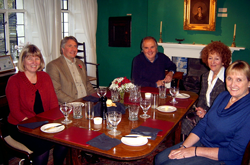 Today we were fortunate enough not only to revisit what has to be one of the most beautiful literary shrines in England but also to have lunch there. Not in the little café, splendid though that is, but sitting in Wordsworth’s dining room, on his chairs, at his table, with his pictures on the wall! Our hosts were Peter and Marian Elkington, who look after the house on behalf of the Wordsworth family and were particularly kind and helpful to me when I was writing my biography of the poet; our fellow-guests were Vicky and Michael Robinson, whom we’ve known for many years through our mutual friend Stanley Ellis and through Vicky’s tireless work at Keswick’s Theatre-by-the-Lake. It’s always fun to meet up with friends and share a lovely meal – but what a privilege to do so in such in such an evocative place! Even the weather behaved perfectly for us: we left Yorkshire in the dank and gloom of a typical November day and arrived in the Lakes to clear blue skies and snow-topped mountain peaks. An unforgettable day.”
Today we were fortunate enough not only to revisit what has to be one of the most beautiful literary shrines in England but also to have lunch there. Not in the little café, splendid though that is, but sitting in Wordsworth’s dining room, on his chairs, at his table, with his pictures on the wall! Our hosts were Peter and Marian Elkington, who look after the house on behalf of the Wordsworth family and were particularly kind and helpful to me when I was writing my biography of the poet; our fellow-guests were Vicky and Michael Robinson, whom we’ve known for many years through our mutual friend Stanley Ellis and through Vicky’s tireless work at Keswick’s Theatre-by-the-Lake. It’s always fun to meet up with friends and share a lovely meal – but what a privilege to do so in such in such an evocative place! Even the weather behaved perfectly for us: we left Yorkshire in the dank and gloom of a typical November day and arrived in the Lakes to clear blue skies and snow-topped mountain peaks. An unforgettable day.”
.............................................................................................................................................................................................
Thursday 14th October 2010: “Unusually I’ve had two army events in the course of two days. Studying Henry V’s victory at Agincourt almost seems to be part of the syllabus for trainee officers and soldiers – the longbow is no longer relevant to modern warfare but the lessons in logistical and leadership skills which enabled Henry to triumph against the odds are timeless. Last night I was at the  Army Foundation College, a huge and impressive site on the outskirts of Harrogate where school-leavers who’ve enlisted as junior soldiers continue their education whilst training for their eventual role in the army. My talk was not for them, but for their instructors, and believe me, there are few things scarier than walking into a lecture theatre full of uniformed officers, sergeants and warrant officers. I felt about three feet tall. And looking at the photo taken in the very dark joint mess bar afterwards only confirms that impression. Once I’d got over my nerves I had a lovely time. The college CO, Lieutenant-Colonel Ocock, was the best sort of army officer: utterly charming and highly intelligent (he grilled me on Agincourt before letting me loose on his staff!) and I was treated (if that’s the right word for someone who hates curry) to an army supper after my talk. I’d have liked to linger over coffee in the mess but, knowing I had another talk to give the following evening, I thought I’d best beat a hasty retreat.
Army Foundation College, a huge and impressive site on the outskirts of Harrogate where school-leavers who’ve enlisted as junior soldiers continue their education whilst training for their eventual role in the army. My talk was not for them, but for their instructors, and believe me, there are few things scarier than walking into a lecture theatre full of uniformed officers, sergeants and warrant officers. I felt about three feet tall. And looking at the photo taken in the very dark joint mess bar afterwards only confirms that impression. Once I’d got over my nerves I had a lovely time. The college CO, Lieutenant-Colonel Ocock, was the best sort of army officer: utterly charming and highly intelligent (he grilled me on Agincourt before letting me loose on his staff!) and I was treated (if that’s the right word for someone who hates curry) to an army supper after my talk. I’d have liked to linger over coffee in the mess but, knowing I had another talk to give the following evening, I thought I’d best beat a hasty retreat.
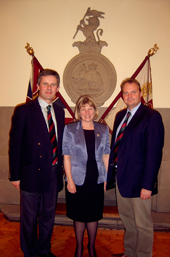 This evening found me at the Huddersfield Drill Hall talking to a select band of the 4th Battalion The Yorkshire Regiment (or the TA to you and me). They’re off on a battlefield tour of Agincourt in a few days time so it was my brief to give them some background information about the campaign and battle. The assiduous note-making would have been highly gratifying if I hadn’t known that each of them had to prepare a short talk on a particular aspect of the campaign to deliver in situ! No wonder the questions afterwards went on almost as long as my talk – and bore a striking resemblance to the subject matter of the delegated talks. Displaying a skill worthy of Henry V himself, I managed to avoid another army curry afterwards and wangle a glass of wine or two into the bargain, since I didn’t have to drive this time. More importantly, thanks to the generosity of those who purchased copies of Agincourt and Conquest, we raised £190 for Help for Heroes, which has to be a good result as we head towards Remembrance Sunday.”
This evening found me at the Huddersfield Drill Hall talking to a select band of the 4th Battalion The Yorkshire Regiment (or the TA to you and me). They’re off on a battlefield tour of Agincourt in a few days time so it was my brief to give them some background information about the campaign and battle. The assiduous note-making would have been highly gratifying if I hadn’t known that each of them had to prepare a short talk on a particular aspect of the campaign to deliver in situ! No wonder the questions afterwards went on almost as long as my talk – and bore a striking resemblance to the subject matter of the delegated talks. Displaying a skill worthy of Henry V himself, I managed to avoid another army curry afterwards and wangle a glass of wine or two into the bargain, since I didn’t have to drive this time. More importantly, thanks to the generosity of those who purchased copies of Agincourt and Conquest, we raised £190 for Help for Heroes, which has to be a good result as we head towards Remembrance Sunday.”
.............................................................................................................................................................................................
Sunday 3rd Octber 2010: “Yesterday saw my first event promoting the new edition of The Brontës. Since I’d only got my own pre-publication copy that morning, I was surprised to find copies were available for sale in the venue: the very smart (but overly warm) new hall for St Margaret’s Parish Church in Ilkley. The Ilkley Literature Festival is always well supported but it was gratifying to find that the event had sold out some time ago. Unusually, this was an ‘in conversation with’, rather than a simple talk. I’m always rather nervous about these as they depend so much on the calibre of the interviewer and you never quite know how it’s going to go when you’re not in complete control yourself. So it was a great relief that Gweno Williams, a professor at York St John University, not only was articulate but also had actually read the book: believe me, I know from bitter experience that neither of these are prerequisites for interviewers. Gweno, however, asked intelligent, and sometimes demanding, questions, but was also prepared to chip in with her own responses, making it a proper conversation. It was a hugely enjoyable event – at least for me! I was delighted to see two young school girls in the audience – and especially pleased that the youngest came to buy an autographed copy at the end and had the courage to ask her own thoughtful question. Well done Helen – you’ll go far!
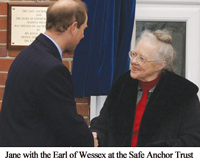 Today we had to make our way through torrential rains and floods to a memorial service for a dear friend, Jane Gummer, a stalwart of the British Legion, chair of the Governors of Batley Grammar School, chair of the Trustees of the Safe Anchor Trust (a charity offering narrow boat rides for disabled and disadvantaged children and young adults), a Deputy Lieutenant for West Yorkshire and an MBE for her services to charity. She worked tirelessly and selflessly for so many good causes, ably assisted by her devoted husband who acted as her chauffeur, PA and secretary, and never had a cross or unkind word to say about anyone. She will be greatly missed.”
Today we had to make our way through torrential rains and floods to a memorial service for a dear friend, Jane Gummer, a stalwart of the British Legion, chair of the Governors of Batley Grammar School, chair of the Trustees of the Safe Anchor Trust (a charity offering narrow boat rides for disabled and disadvantaged children and young adults), a Deputy Lieutenant for West Yorkshire and an MBE for her services to charity. She worked tirelessly and selflessly for so many good causes, ably assisted by her devoted husband who acted as her chauffeur, PA and secretary, and never had a cross or unkind word to say about anyone. She will be greatly missed.”
..............................................................................................................................................................................................
Thursday 9th September 2010: “Another visit to the Great Wen today – this time for work. I was up at the crack of a chilly dawn and standing on my local railway station platform by 7.30am. As usual they were already announcing delays and cancellations, so I caught the first available train and was fortunate to arrive at Leeds in time to make my connection with the London train.
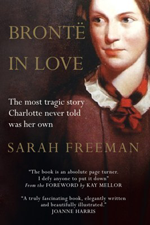 All the Yorkshire papers are full of Brontë in Love by Sarah Freeman – quite possibly because the author’s the Features Editor of the Yorkshire Post. I’d been sent a copy to review so I occupied my time on the journey (all four hours of it) reading what I can now say is one of the worst books I’ve ever read on the Brontës. The idea was a good one: a biography of Charlotte contrasting her expectations of love as expressed in her fiction with her experience of it in life. The author says she’s ‘delighted to have been able to set the record straight and dispel the myths that have surrounded [Charlotte’s] character for over 150 years’ – a claim I recognise as that’s my line from the first publication of my own biography in 1994! More surprisingly, the book’s got glowing front-cover endorsements from Kay Mellor (‘an absolute page turner. I defy anyone to put it down’) and Joanne Harris (‘A truly fascinating book, elegantly written and beautifully illustrated’.) Now, at the risk of never, ever, receiving any publicity for my books in the Yorkshire Post again, I have to tell you that these claims are absolute rubbish: Brontë in Love reads like it has been thrown together by someone who knows very little about the Brontës and cares even less. How else to explain so many basic errors of fact? – I noted at least 50 and the book is only 190 pages long! How can Joanne Harris possibly call a book ‘elegantly written’ when it calls invitations ‘invites’ (repeatedly) and includes sentences such as ‘It was with a heavy heart with which she left behind her brother, her sisters and she tried desperately to muster some enthusiasm.’? Good grief. My favourite line – which caused me some embarrassment by making me hoot out loud with laughter as I read it on the train – is the delicious caption to a photo of a snow-covered Haworth moor: ‘The winter was often harsh in Haworth, but when Arthur Nicholls proposed to Charlotte the atmosphere inside the parsonage was equally frosty.’ It’s just like a line out of Devotion, the hilarious 1946 Hollywood film version of the Brontës’ lives, starring those notoriously plain actresses Ida Lupino, Olivia de Havilland and Nancy Coleman. Someone’s judgement is sadly awry on this book – and I don’t think it’s mine.
All the Yorkshire papers are full of Brontë in Love by Sarah Freeman – quite possibly because the author’s the Features Editor of the Yorkshire Post. I’d been sent a copy to review so I occupied my time on the journey (all four hours of it) reading what I can now say is one of the worst books I’ve ever read on the Brontës. The idea was a good one: a biography of Charlotte contrasting her expectations of love as expressed in her fiction with her experience of it in life. The author says she’s ‘delighted to have been able to set the record straight and dispel the myths that have surrounded [Charlotte’s] character for over 150 years’ – a claim I recognise as that’s my line from the first publication of my own biography in 1994! More surprisingly, the book’s got glowing front-cover endorsements from Kay Mellor (‘an absolute page turner. I defy anyone to put it down’) and Joanne Harris (‘A truly fascinating book, elegantly written and beautifully illustrated’.) Now, at the risk of never, ever, receiving any publicity for my books in the Yorkshire Post again, I have to tell you that these claims are absolute rubbish: Brontë in Love reads like it has been thrown together by someone who knows very little about the Brontës and cares even less. How else to explain so many basic errors of fact? – I noted at least 50 and the book is only 190 pages long! How can Joanne Harris possibly call a book ‘elegantly written’ when it calls invitations ‘invites’ (repeatedly) and includes sentences such as ‘It was with a heavy heart with which she left behind her brother, her sisters and she tried desperately to muster some enthusiasm.’? Good grief. My favourite line – which caused me some embarrassment by making me hoot out loud with laughter as I read it on the train – is the delicious caption to a photo of a snow-covered Haworth moor: ‘The winter was often harsh in Haworth, but when Arthur Nicholls proposed to Charlotte the atmosphere inside the parsonage was equally frosty.’ It’s just like a line out of Devotion, the hilarious 1946 Hollywood film version of the Brontës’ lives, starring those notoriously plain actresses Ida Lupino, Olivia de Havilland and Nancy Coleman. Someone’s judgement is sadly awry on this book – and I don’t think it’s mine.
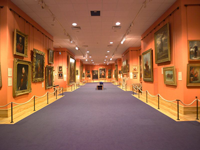 Having spent four hours getting to London and another four hours making my way back home again, it was a relief to find that I spent only three hours in the city itself. Just the right proportion, I felt. The reason for my visit was to give a talk on Conquest at the National Army Museum. What an experience! A fantastic room lined with vast portraits of generals in full dress uniform and over a hundred enthusiastic and interested members of the audience (95% of them men, I noticed) listening intently and catching my every allusion without my having to explain it. I was actually sorry to have to cut short the question and answer session at the end as I had to catch my return train – which I almost missed because I didn’t believe the departure board could be right when it listed my train at Platform 0. Whoever heard of Platform 0? Sounds more like Harry Potter than National Rail but there really is now a Platform 0 at King’s Cross Station. I know. I caught my train home there.”
Having spent four hours getting to London and another four hours making my way back home again, it was a relief to find that I spent only three hours in the city itself. Just the right proportion, I felt. The reason for my visit was to give a talk on Conquest at the National Army Museum. What an experience! A fantastic room lined with vast portraits of generals in full dress uniform and over a hundred enthusiastic and interested members of the audience (95% of them men, I noticed) listening intently and catching my every allusion without my having to explain it. I was actually sorry to have to cut short the question and answer session at the end as I had to catch my return train – which I almost missed because I didn’t believe the departure board could be right when it listed my train at Platform 0. Whoever heard of Platform 0? Sounds more like Harry Potter than National Rail but there really is now a Platform 0 at King’s Cross Station. I know. I caught my train home there.”
..............................................................................................................................................................................................
Friday 27th August 2010:" Last night we ended our trip away in perfect fashion with my first visit ever to the Proms. It was also my first visit to the Royal Albert Hall where we had seats four rows back in the stalls, just to the right of the stage and so close we could see the conductor’s face not just his hands.
 The concert was superb. Well, almost all of it was. The first piece was not: it was a pretentious, derivative and boring modern piece by Mark-Anthony Turnage, called Hammered Out – a very appropriate title. It got a fairly low-key response until the composer walked on stage at the end and then, for reasons best known to itself, the audience gave him a rapturous reception. We clapped politely but without enthusiasm. Our genial but ruthlessly honest French host refused to clap at all. ‘Why are you doing that?’ he said to us. ‘What are you encouraging him for? He should find another job!’ We laughed but he was quite right.
The concert was superb. Well, almost all of it was. The first piece was not: it was a pretentious, derivative and boring modern piece by Mark-Anthony Turnage, called Hammered Out – a very appropriate title. It got a fairly low-key response until the composer walked on stage at the end and then, for reasons best known to itself, the audience gave him a rapturous reception. We clapped politely but without enthusiasm. Our genial but ruthlessly honest French host refused to clap at all. ‘Why are you doing that?’ he said to us. ‘What are you encouraging him for? He should find another job!’ We laughed but he was quite right.
The rest of the concert was superb. I love Samuel Barber’s Violin Concerto which is the most beautiful, romantic, exquisitely wistful music. The soloist, an Israeli called Gil Shaham, was superb: when he was playing the quiet notes you had to lean forward to catch it but the whole hall was absolutely silent and enthralled: even the Promenaders who had to stand for the whole two hours stood stock still. It was thrilling and he rightly got a series of ovations, so many in fact that he ended up playing a short encore. The last piece was another old favourite, the Sibelius 2nd Symphony in D Major – the one with the wonderful recurring theme played by the horns which builds up and up until the magnificent finale. What a way to end the concert!"
...........................................................................................................................................
Tuesday 24th August 2010: " The gardens at Sissinghurst were lovely but they were as nothing compared to those of Great Dixter which we visited this morning. Frustratingly, we couldn’t go round the house – it’s only open from 2-4 on certain days – so we could only peek longingly in the windows. It was built in the 1450s, half-timbered with a ramshackle wooden porch and an immense great hall but in 1910, a new owner Nathanial Lloyd brought in Edward Lutyens (England’s greatest domestic architect I think).  He knocked down all the later additions, leaving only the original 1450s house, then, because it left them without enough accommodation, he added at the back a derelict 16th century timber-framed house which he bought in a neighbouring village, transported stone by stone (and timber by timber), rebuilt and restored. It’s just the most fabulous house but the gardens round it, which were part Lutyens design but mainly created by Lloyd’s famous gardening son, Christopher, are a fairyland. Unlike Bateman’s and Sissinghurst, both National Trust and showing it, Great Dixter is still a private house and every single inch of soil was packed with flowers. (Both NT properties had lots of areas where the flowers had died back and there were just empty patches of soil: it made them look unloved: and the attendants in each room always make me feel uncomfortable.)
He knocked down all the later additions, leaving only the original 1450s house, then, because it left them without enough accommodation, he added at the back a derelict 16th century timber-framed house which he bought in a neighbouring village, transported stone by stone (and timber by timber), rebuilt and restored. It’s just the most fabulous house but the gardens round it, which were part Lutyens design but mainly created by Lloyd’s famous gardening son, Christopher, are a fairyland. Unlike Bateman’s and Sissinghurst, both National Trust and showing it, Great Dixter is still a private house and every single inch of soil was packed with flowers. (Both NT properties had lots of areas where the flowers had died back and there were just empty patches of soil: it made them look unloved: and the attendants in each room always make me feel uncomfortable.)

Great Dixter has a wonderful sunken garden with a small hexagonal pond at its centre and flagged paths round it; a tiny walled garden with pear and fig trees growing against the walls, wild-flower meadows, lots of tiny maze-like gardens enclosed within yew hedges and, my favourite of all, the beautiful long border along the terrace at the back of the house. Plants which in our garden are about two foot high were here double or even treble the size, and there were so many varieties and colours, it was just exquisite.
 Our final visit of the day was to Smallhythe Place, another lovely sixteenth century half-timbered house with floors at such crazy angles that in some rooms if you stood on one side you gradually slid down to the wall! It was really interesting, though, because it was the home of the actress Ellen Terry from 1899 to 1928, and it was full of theatrical memorabilia, including not only Ellen’s pictures, jewellery, costumes etc but things belonging to Sarah Siddons, Sarah Bernhardt, Oscar Wilde, Henry Irving and goodness knows who else (even Rachel Félix, the French actress whose performances in London mesmerised and alarmed Charlotte Brontë). The little place was absolutely jam-packed with Stuff. But it was very entertaining."
Our final visit of the day was to Smallhythe Place, another lovely sixteenth century half-timbered house with floors at such crazy angles that in some rooms if you stood on one side you gradually slid down to the wall! It was really interesting, though, because it was the home of the actress Ellen Terry from 1899 to 1928, and it was full of theatrical memorabilia, including not only Ellen’s pictures, jewellery, costumes etc but things belonging to Sarah Siddons, Sarah Bernhardt, Oscar Wilde, Henry Irving and goodness knows who else (even Rachel Félix, the French actress whose performances in London mesmerised and alarmed Charlotte Brontë). The little place was absolutely jam-packed with Stuff. But it was very entertaining."
...........................................................................................................................................
Monday 23rd August 2010:" Today we’re beginning a brief holiday in Kent – the destination being decided by the need to use our Christmas present gift-vouchers for an English vineyard visit and wine-tasting before they elapsed. I don’t know Kent well and I’d forgotten how very beautiful some of it is: I’d also forgotten how hilly it is so: every so often you climb slowly up a long, long hillside at such a gentle incline that you don’t realise that you are climbing until you reach the top and there you are on the peak of a great escarpment with all the undulating landscape laid out before you. It’s all so very English, ancient, green and heavily wooded, full of trees, hedges and orchards, and dotted with the most beautiful houses, from Georgian mansions to gravity-defying fifteenth century half-timbered farmhouses and cottages that make you wonder by what extraordinary hidden contrivance (rubber bands perhaps) they are actually standing upright. What a pity so many of them are utterly spoilt by being right on the roadside with the constant noise and fumes from traffic thundering past every minute of the day.
 Fortunately, the houses and gardens we had chosen to visit were all tucked away in the quieter parts of the countryside. Our first port of call was Bateman’s, Rudyard Kipling’s house, hidden away in a lovely wooded valley near Burwash, just over the border in East Sussex. To get there you have to go down a long very narrow road – so narrow that the trees on each side meet in the middle and you travel under a green canopy (Kipling described it as like going down ‘an enlarged rabbit hole’). The house is exquisitely beautiful: built in 1634 by the local iron-monger though it looks more like a Jacobean manor house in lovely mellow sandstone with mullioned windows and a two-storey porch over the front door. It’s surrounded by its own gardens: a huge walled garden filled with fruit trees (apple and pears mainly) that were almost bowed to the ground with the weight of fruit on one side, then grass lawns round two sides of the house with an avenue of pleached limes and a long rectangular lily pond, at the head of which (nearest the house) Kipling created a curved arbour of yews with a similarly curved bench in the middle so that you could look down the length of the pond to the formal rose gardens at the other end. (He spent his Nobel prize money creating this section of the garden to his own design.)
Fortunately, the houses and gardens we had chosen to visit were all tucked away in the quieter parts of the countryside. Our first port of call was Bateman’s, Rudyard Kipling’s house, hidden away in a lovely wooded valley near Burwash, just over the border in East Sussex. To get there you have to go down a long very narrow road – so narrow that the trees on each side meet in the middle and you travel under a green canopy (Kipling described it as like going down ‘an enlarged rabbit hole’). The house is exquisitely beautiful: built in 1634 by the local iron-monger though it looks more like a Jacobean manor house in lovely mellow sandstone with mullioned windows and a two-storey porch over the front door. It’s surrounded by its own gardens: a huge walled garden filled with fruit trees (apple and pears mainly) that were almost bowed to the ground with the weight of fruit on one side, then grass lawns round two sides of the house with an avenue of pleached limes and a long rectangular lily pond, at the head of which (nearest the house) Kipling created a curved arbour of yews with a similarly curved bench in the middle so that you could look down the length of the pond to the formal rose gardens at the other end. (He spent his Nobel prize money creating this section of the garden to his own design.)
Inside, however, the house was disappointing. It’s very dark – not helped by masses of dark wood panelling and period furniture, most of it Kipling’s own. It just seemed very strange to walk out of those lovely open light-filled gardens into the darkness and gloom of a veritable rabbit warren (continuing Kipling’s metaphor). The best room was his study, with its beamed ceiling, ancient bookshelves lining the walls, a huge solid oak table for him to work on and a sofa bed to lie on till inspiration struck – a thought I shall bear in mind for my next study!
 From Bateman’s we went on to Sissinghurst Castle in Kent. There was once a superb stone medieval castle here, complete with moat, but in the sixteenth century the owner pulled it down (bloody Tudors!) and built a huge red brick Elizabethan palace round a vast courtyard right in front of it. By the beginning of the 20th century all that was left of the ‘new’ building was a single run of the old Elizabethan service block and a fantastically romantic narrow gatehouse tower, three storeys high with turrets on each side. All the rest, including the old castle had gone. Harold Nicolson and his wife, Vita Sackville-West then transformed the place, poured money into saving what remained of the buildings and restoring them beautifully, and then, in the ruins of what couldn’t be saved, creating a whole series of the most wonderful gardens. Harold was a classicist and loved symmetry and straight lines: Vita was a romantic and liked a profusion of flowers: the combination of his designs for laying out the gardens and her planting of them is fantastic. I loved Vita’s novel All Passion Spent so it was interesting for me to see her study – just where I’d have put it – in the tower overlooking the gardens. And to learn that, like Kipling, she’d also spent her literary prize money on creating her gardens – a pattern is emerging – now why can’t I win one?"
From Bateman’s we went on to Sissinghurst Castle in Kent. There was once a superb stone medieval castle here, complete with moat, but in the sixteenth century the owner pulled it down (bloody Tudors!) and built a huge red brick Elizabethan palace round a vast courtyard right in front of it. By the beginning of the 20th century all that was left of the ‘new’ building was a single run of the old Elizabethan service block and a fantastically romantic narrow gatehouse tower, three storeys high with turrets on each side. All the rest, including the old castle had gone. Harold Nicolson and his wife, Vita Sackville-West then transformed the place, poured money into saving what remained of the buildings and restoring them beautifully, and then, in the ruins of what couldn’t be saved, creating a whole series of the most wonderful gardens. Harold was a classicist and loved symmetry and straight lines: Vita was a romantic and liked a profusion of flowers: the combination of his designs for laying out the gardens and her planting of them is fantastic. I loved Vita’s novel All Passion Spent so it was interesting for me to see her study – just where I’d have put it – in the tower overlooking the gardens. And to learn that, like Kipling, she’d also spent her literary prize money on creating her gardens – a pattern is emerging – now why can’t I win one?"
...........................................................................................................................................
Sunday 18th July 2010: "We’d really been looking forward to going to the Ways With Words festival at Dartington this year: so much so that we had planned to go for a long weekend so that we could attend lots of events. The best laid plans … Family circumstances meant we had to cancel at the last minute but, as I couldn’t let the WWW team down (I’ve seen the problems that causes all too often and I couldn’t inflict that on them), I had to make other arrangements. So I got up at 4am, had a driver pick me up at 5am and we then drove all the way from Yorkshire to Dartington. We’d expected masses of traffic, it being the start of the school holidays, but the roads were empty and we were sitting eating breakfast in the solar at Dartington Hall at 9.15am! Having left grey skies and pouring rain, the blazing sunshine added to the sense of dislocation, but the event went well and I sold lots of books afterwards, which is always gratifying. And I had the great pleasure of meeting the very erudite Ian Mortimer, who chaired my event (and kindly didn’t publicly pick me up when I said something stupid in answer to a question). We chatted all things medieval over a quick lunch, then it was back into the car for a much slower journey home along packed motorways. Returning to grey skies and rain, it felt like I’d never been away, let alone travelled 584 miles in the course of the day!"
...........................................................................................................................................
Saturday 26th June 2010: "Today was a day of mixed emotions. To celebrate Armed Forces Day we were in Halifax to watch a Freedom Parade through the town by the Yorkshire Regiment which has just returned, with losses, from a tour of duty in Afghanistan. 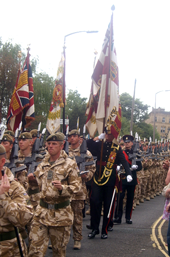 The boys – and so many of them were boys – received a tremendous welcome from the crowds lining the streets and then made their way to the Piece Hall to be inspected by the Vice Lord-Lieutenant of West Yorkshire and the Mayor. Afterwards, we all made our way to Halifax Parish Church (now newly christened a Minster) for a moving ceremony to lay up the colours of the Duke of Wellington’s Regiment, which has now been merged into the Yorkshire Regiment. Truly the end of a distinguished era: Halifax has always been an important recruiting ground for the regiment – in the 19th century they were still holding Waterloo dinners to celebrate the victory and the town’s connection with the Iron Duke. I’m the proud possessor of a beautiful regimental brooch, bearing the elephant symbol, which was given to me by Duke’s when I took their veterans on a battlefield tour of Agincourt a few years ago.
The boys – and so many of them were boys – received a tremendous welcome from the crowds lining the streets and then made their way to the Piece Hall to be inspected by the Vice Lord-Lieutenant of West Yorkshire and the Mayor. Afterwards, we all made our way to Halifax Parish Church (now newly christened a Minster) for a moving ceremony to lay up the colours of the Duke of Wellington’s Regiment, which has now been merged into the Yorkshire Regiment. Truly the end of a distinguished era: Halifax has always been an important recruiting ground for the regiment – in the 19th century they were still holding Waterloo dinners to celebrate the victory and the town’s connection with the Iron Duke. I’m the proud possessor of a beautiful regimental brooch, bearing the elephant symbol, which was given to me by Duke’s when I took their veterans on a battlefield tour of Agincourt a few years ago.
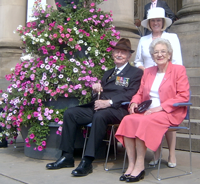 Next day, Sunday, we were at it again, this time attending the Armed Forces day in Leeds, where a detachment of the Rifles marched through the streets and there was a splendid concert in the Town Hall followed by a beating of the retreat outside the City Art Gallery. We even had a fly-past by a Douglas Dakota! The photo shows me with my dear friends Lieutenant-Colonel Gerry Jarrett (retd) and his wife Mary, stalwarts of the Leeds Rifles, on the steps of the Town Hall, watching the Lord Lieutenant, High Sheriff and Lord Mayor inspecting the troops."
Next day, Sunday, we were at it again, this time attending the Armed Forces day in Leeds, where a detachment of the Rifles marched through the streets and there was a splendid concert in the Town Hall followed by a beating of the retreat outside the City Art Gallery. We even had a fly-past by a Douglas Dakota! The photo shows me with my dear friends Lieutenant-Colonel Gerry Jarrett (retd) and his wife Mary, stalwarts of the Leeds Rifles, on the steps of the Town Hall, watching the Lord Lieutenant, High Sheriff and Lord Mayor inspecting the troops."
...........................................................................................................................................
Saturday 12th June 2010: " Yesterday we came down to Warminster for a family get-together and a much-needed relaxing weekend. Not that there was much relaxing about a five hour journey on busy motorways, even if, as I pointed out to the uninterested members of my family as we drove through Bath, our route took us past the house where William Wordsworth and his family stayed when they came to the city for his daughter Dora’s wedding to Edward Quillinan in 1843.
Our hotel, Bishopstrow House, is lovely: a Georgian country house on the outskirts of the town which feels as though it is in the depths of the countryside.  There are deer in the field beyond the garden and classical-style follies in the old gardens beside the river, the latter reached by a tunnel built under the road in 1815 which has unusually ornate carvings in the stonework at its entrances, much like that on the archways leading into Victorian woollen mill-yards in Bradford.
Having left leaden skies and cold winds in Yorkshire, it was something of a shock to the system to find Wiltshire basking in sunshine, so today we took advantage of the weather to climb nearby Battlesbury Hill, which has far-reaching views over the surrounding hills and into Salisbury Plain (another Wordsworthian connection!).
There are deer in the field beyond the garden and classical-style follies in the old gardens beside the river, the latter reached by a tunnel built under the road in 1815 which has unusually ornate carvings in the stonework at its entrances, much like that on the archways leading into Victorian woollen mill-yards in Bradford.
Having left leaden skies and cold winds in Yorkshire, it was something of a shock to the system to find Wiltshire basking in sunshine, so today we took advantage of the weather to climb nearby Battlesbury Hill, which has far-reaching views over the surrounding hills and into Salisbury Plain (another Wordsworthian connection!).
 A winding pathway took us through fields which reminded me of the Yorkshire Dales in my childhood – full of wild-flowers – and then wound gradually up the hillside to the top. It was only then that we could fully appreciate not only the panorama of undulating countryside but also the achievement of those who had created this amazing place. Battlesbury Hill is not just a natural feature but is the site of a huge iron age fortress whose double ramparts, sixty feet high, encircle its peak. What makes it even more extraordinary is that at the top of the hill, just within the ramparts, there is an even earlier bronze age barrow. Walking back down along a pathway overgrown with dog roses, with orchids hiding in the undergrowth and blue butterflies fluttering through the sunlit patches, it felt like we were in another world and time."
A winding pathway took us through fields which reminded me of the Yorkshire Dales in my childhood – full of wild-flowers – and then wound gradually up the hillside to the top. It was only then that we could fully appreciate not only the panorama of undulating countryside but also the achievement of those who had created this amazing place. Battlesbury Hill is not just a natural feature but is the site of a huge iron age fortress whose double ramparts, sixty feet high, encircle its peak. What makes it even more extraordinary is that at the top of the hill, just within the ramparts, there is an even earlier bronze age barrow. Walking back down along a pathway overgrown with dog roses, with orchids hiding in the undergrowth and blue butterflies fluttering through the sunlit patches, it felt like we were in another world and time."
...........................................................................................................................................
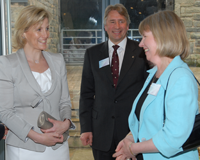 Thursday 29th April 2010: For the second time in three weeks my day working as a volunteer waitress in the Granary Cafe at Caring For Life has coincided with a VIP visit. This time it is the charity’s patron, HRH The Countess of Wessex, a lovely lady who is by no means just a figure head: she takes an active interest in the welfare of the charity and the people it looks after, visiting regularly and offering advice and support. Today’s visit was to mark the official opening of a new meat room, enabling the farm to offer a greater range of meat products, including home-produced fresh sausages and burgers. The wonderful Dunbia, a family-owned company based in Northern Ireland which specialises in producing premium quality meat products, has not only trained CFL’s staff and the people they look after so they can produce the goods but also financed and built the new processing room. After opening and touring the new building and visiting the various projects on the farm, the Countess came to the café where my husband and I were helping to host a reception for civic dignitaries, including the Lord Mayor of Leeds. As usual the Countess made a point of speaking to everyone there – most especially to the young volunteers who have given a year of their lives to work for CFL – before what has become a traditional CFL send-off by all those we look after who are genuinely thrilled by her interest.
Thursday 29th April 2010: For the second time in three weeks my day working as a volunteer waitress in the Granary Cafe at Caring For Life has coincided with a VIP visit. This time it is the charity’s patron, HRH The Countess of Wessex, a lovely lady who is by no means just a figure head: she takes an active interest in the welfare of the charity and the people it looks after, visiting regularly and offering advice and support. Today’s visit was to mark the official opening of a new meat room, enabling the farm to offer a greater range of meat products, including home-produced fresh sausages and burgers. The wonderful Dunbia, a family-owned company based in Northern Ireland which specialises in producing premium quality meat products, has not only trained CFL’s staff and the people they look after so they can produce the goods but also financed and built the new processing room. After opening and touring the new building and visiting the various projects on the farm, the Countess came to the café where my husband and I were helping to host a reception for civic dignitaries, including the Lord Mayor of Leeds. As usual the Countess made a point of speaking to everyone there – most especially to the young volunteers who have given a year of their lives to work for CFL – before what has become a traditional CFL send-off by all those we look after who are genuinely thrilled by her interest.
 Just a few days earlier we had also been mixing with civic dignitaries when we attended the annual Saint George’s Day parade and celebrations in Morley. This is a marvellous event – the procession is led by ‘Saint George’ himself in full armour riding on horseback and the ‘dragon’, followed by all the local war veterans, cadets, scouts, cubs, brownies and various re-enactors, vintage cars etc. We follow on foot up to the local rugby ground where all the charity fund-raising stalls are set out and the Lord Lieutenant reviews the military element of the parade as a prelude to displays by police dogs, local archery groups and re-enactors. The event always raises huge sums for charities and I was especially pleased to discover that by the time I got to the Help For Heroes stall they had almost completely sold out! Having forgotten to take my camera (again) I’m indebted to Terry Grayshon for the photo of me in a superb vintage Humber, together with Judith Elliott, Lord Mayor of Leeds, and Shirley Varley, Mayor of Morley.
Just a few days earlier we had also been mixing with civic dignitaries when we attended the annual Saint George’s Day parade and celebrations in Morley. This is a marvellous event – the procession is led by ‘Saint George’ himself in full armour riding on horseback and the ‘dragon’, followed by all the local war veterans, cadets, scouts, cubs, brownies and various re-enactors, vintage cars etc. We follow on foot up to the local rugby ground where all the charity fund-raising stalls are set out and the Lord Lieutenant reviews the military element of the parade as a prelude to displays by police dogs, local archery groups and re-enactors. The event always raises huge sums for charities and I was especially pleased to discover that by the time I got to the Help For Heroes stall they had almost completely sold out! Having forgotten to take my camera (again) I’m indebted to Terry Grayshon for the photo of me in a superb vintage Humber, together with Judith Elliott, Lord Mayor of Leeds, and Shirley Varley, Mayor of Morley.
A dislocated thumb has made writing difficult recently so I’ve only written a couple of reviews for the Mail on Sunday: a rather dull biography of Constance Spry which raised more questions than it answered and, this week, Second Nature by Jonathan Balcombe. I was amused to see that the book jacket described him as ‘an independent animal behavior research scientist and a consultant for the Physicians Committee for Responsible Medicine’: on his website, more appropriately (as it reflects his priorities more accurately), he describes himself as ‘Author, Activist, Scientist’. A fascinating book in many ways because it reveals so much about animal behaviour, for me it was spoilt by Balcombe’s polemical approach and his lack of scientific rigour. I laughed out loud when I read that European scientists ‘discovered’ in 2008 that cattle and deer across the globe always graze and rest with their bodies aligned north-south: every single one of the cattle grazing outside my window was aligned west-east! Rather more to do with the lie of the land, I would suggest, than mysterious magnetic orientation. A pity, because Balcombe’s central thesis, that we should treat the rest of creation with respect seems entirely valid to me on purely moral grounds.
..............................................................................................................................................
Wednesday 14th April 2010:
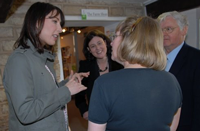 When I arrived at Caring For Life last Thursday ready to do my usual shift working in the Granary Cafe I found the whole place in high excitement. The car park was full, people I didn’t know were rushing around the farm and the cafe itself was also packed – even though it doesn’t open till 10am. The reason, I soon discovered, was that we were expecting a VIP guest – Samantha Cameron, wife of the Tory party leader. (The people in the cafe were all journalists from television, radio and newspapers and it was their cars that had taken over the car park so our regular visitors couldn’t get in.) I have to confess to feeling ambivalent – to put it mildly – about CFL being used as a photo opportunity for the general election campaign. Two things won me over – the obviously genuine interest and empathy Mrs Cameron showed in the charity and its work and the fact that the people we look after liked her, which means that they too thought she was sincere. I gave her a copy of The Deafening Sound of Silent Tears, my book about CFL, together with an ear-bashing about successive governments’ disgraceful treatment of vulnerable people with long-term needs and Christian charities dedicated to their welfare.
When I arrived at Caring For Life last Thursday ready to do my usual shift working in the Granary Cafe I found the whole place in high excitement. The car park was full, people I didn’t know were rushing around the farm and the cafe itself was also packed – even though it doesn’t open till 10am. The reason, I soon discovered, was that we were expecting a VIP guest – Samantha Cameron, wife of the Tory party leader. (The people in the cafe were all journalists from television, radio and newspapers and it was their cars that had taken over the car park so our regular visitors couldn’t get in.) I have to confess to feeling ambivalent – to put it mildly – about CFL being used as a photo opportunity for the general election campaign. Two things won me over – the obviously genuine interest and empathy Mrs Cameron showed in the charity and its work and the fact that the people we look after liked her, which means that they too thought she was sincere. I gave her a copy of The Deafening Sound of Silent Tears, my book about CFL, together with an ear-bashing about successive governments’ disgraceful treatment of vulnerable people with long-term needs and Christian charities dedicated to their welfare.
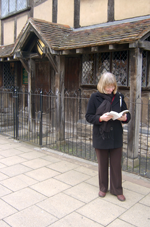 Monday found us in Stratford-upon-Avon which, I am ashamed to say, I hadn’t visited for more than fifteen years. I couldn’t believe the extent of the new urban sprawl, particularly all the ugly tin-shed shopping centres which seem to have engulfed the town. Whether it’s their proliferation or the closure of the main RSC theatre for a renovation which has taken literally years and is still not complete, it was both shocking and depressing to see how many shops, cafes and restaurants in the centre had either closed down completely or were advertising staff vacancies. (There are still some wonderful restaurants and bistros though.) We saw a performance of Antony and Cleopatra – a play I studied for A level – at the Courtyard Theatre. Despite the valiant efforts of Darrell D’Silva, who’d had an accident on Friday, an operation on Saturday and insisted on playing Antony on Monday, even though he had his arm in a sling, I felt the entire production never really came to life. The staging was too static and the set and costumes dismal and boring – there wasn’t even a visual contrast between the sensual opulence of Egypt and the military discipline of Rome. The role of Cleopatra, which is so critical to the success of the play, is an extraordinarily difficult one to carry off successfully: she has all the weight of expectation conjured up by Enobarbus’s speech but her ‘infinite variety’ can all too easily seem simply wilful, petulant and childish rather than beguiling. The fault is largely Shakespeare’s but I was not convinced by this Cleopatra.
Monday found us in Stratford-upon-Avon which, I am ashamed to say, I hadn’t visited for more than fifteen years. I couldn’t believe the extent of the new urban sprawl, particularly all the ugly tin-shed shopping centres which seem to have engulfed the town. Whether it’s their proliferation or the closure of the main RSC theatre for a renovation which has taken literally years and is still not complete, it was both shocking and depressing to see how many shops, cafes and restaurants in the centre had either closed down completely or were advertising staff vacancies. (There are still some wonderful restaurants and bistros though.) We saw a performance of Antony and Cleopatra – a play I studied for A level – at the Courtyard Theatre. Despite the valiant efforts of Darrell D’Silva, who’d had an accident on Friday, an operation on Saturday and insisted on playing Antony on Monday, even though he had his arm in a sling, I felt the entire production never really came to life. The staging was too static and the set and costumes dismal and boring – there wasn’t even a visual contrast between the sensual opulence of Egypt and the military discipline of Rome. The role of Cleopatra, which is so critical to the success of the play, is an extraordinarily difficult one to carry off successfully: she has all the weight of expectation conjured up by Enobarbus’s speech but her ‘infinite variety’ can all too easily seem simply wilful, petulant and childish rather than beguiling. The fault is largely Shakespeare’s but I was not convinced by this Cleopatra.
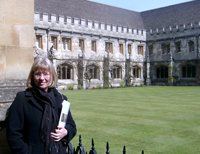 If Stratford had its disappointments, Oxford retained all its old allure, despite endless road-works in the High and the usual plethora of tourists. A lovely warm spring day helped as well! We were too early for the wisteria but the magnolias were just coming into bloom in all the college quads. The riverside walks at Magdalen in particular were a perfect carpet of spring flowers and the water meadows were speckled with snake’s head fritillaries. (A favourite flower of mine, not least because it grows prolifically in my garden without any assistance from me). I didn’t remember there being two white deer in the herd in Magdalen’s deer park but was glad to see that the most beautiful cloistered quadrangle in Oxford remained unchanged.
If Stratford had its disappointments, Oxford retained all its old allure, despite endless road-works in the High and the usual plethora of tourists. A lovely warm spring day helped as well! We were too early for the wisteria but the magnolias were just coming into bloom in all the college quads. The riverside walks at Magdalen in particular were a perfect carpet of spring flowers and the water meadows were speckled with snake’s head fritillaries. (A favourite flower of mine, not least because it grows prolifically in my garden without any assistance from me). I didn’t remember there being two white deer in the herd in Magdalen’s deer park but was glad to see that the most beautiful cloistered quadrangle in Oxford remained unchanged.
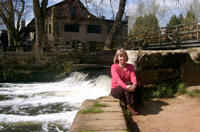 On the way home via Warwick we had lunch at The Saxon Mill which I’d visited for the first time a few weeks earlier after my event at the Warwick Literature Festival. (Fantastic food – we were surprised but pleased to discover it had the same menu as The Encore in Stratford where we’d eaten the night before – it turned out that they are sister pubs.) The mill, which is mentioned in Domesday book, still has a working water wheel, mill-race and a huge mill-pond: across the still waters of the pond you can just see the romantic ruins of Guy’s Cliffe rising through the trees. It was there that Guy of Warwick, the legendary hero of medieval romance, was said to have ended his days living anonymously as a hermit in a cave by the banks of the Avon. What an evocative place!
On the way home via Warwick we had lunch at The Saxon Mill which I’d visited for the first time a few weeks earlier after my event at the Warwick Literature Festival. (Fantastic food – we were surprised but pleased to discover it had the same menu as The Encore in Stratford where we’d eaten the night before – it turned out that they are sister pubs.) The mill, which is mentioned in Domesday book, still has a working water wheel, mill-race and a huge mill-pond: across the still waters of the pond you can just see the romantic ruins of Guy’s Cliffe rising through the trees. It was there that Guy of Warwick, the legendary hero of medieval romance, was said to have ended his days living anonymously as a hermit in a cave by the banks of the Avon. What an evocative place!
..............................................................................................................................................
Wednesday 31st March 2010:
“After so many weeks when I seem to have done nothing at all except sit chained to my desk writing, revising and editing, the last month has been a complete contrast. I’ve been on the road doing events up and down the country: it sounds glamorous but believe me it isn’t. I’ve spent hours and hours trailing along the M62, M1 and M6, stuck in endless ‘roadworks’ where literally miles of motorway is reduced to two lanes and a fifty mile an hour speed limit but no ‘work’ on the road or otherwise is visible. And it’s strange how no two events are near each other or, if they are, they’re days apart! Since my events in Hull and Keswick in the first week of March I’ve been to Cardiff, Harrogate, Kenilworth and Oxford.
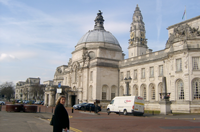 It was my first visit to Cardiff (other than passing through on the train) but I was only there because of the Travel Media Association of Canada, which was holding its annual conference in the city. I was thrilled to be invited – naively thinking that I would be travelling to Canada, a country I love – so it was just my luck that for the first time ever they held their conference abroad. In Cardiff. Which is an attractive city, if you like cities, but it isn’t Canada. Fortunately the Canadians themselves were as friendly and hospitable as they always are and my shared seminar event on ‘The World in Words’ was fun – not least because I couldn’t resist the wicked impulse to begin my speech by announcing that I was very embarrassed because I felt obliged to confess that I was actually the author of all the pieces by an unnamed female travel writer which the previous speaker had shown on screen as examples of bad travel writing! There was a horrified silence before I admitted it was just a joke – but the point was that it could well have been true. You never know who might be in your audience.
It was my first visit to Cardiff (other than passing through on the train) but I was only there because of the Travel Media Association of Canada, which was holding its annual conference in the city. I was thrilled to be invited – naively thinking that I would be travelling to Canada, a country I love – so it was just my luck that for the first time ever they held their conference abroad. In Cardiff. Which is an attractive city, if you like cities, but it isn’t Canada. Fortunately the Canadians themselves were as friendly and hospitable as they always are and my shared seminar event on ‘The World in Words’ was fun – not least because I couldn’t resist the wicked impulse to begin my speech by announcing that I was very embarrassed because I felt obliged to confess that I was actually the author of all the pieces by an unnamed female travel writer which the previous speaker had shown on screen as examples of bad travel writing! There was a horrified silence before I admitted it was just a joke – but the point was that it could well have been true. You never know who might be in your audience.
On 18th March I returned to the Great Yorkshire Showground at Harrogate. It was a strange position to be held up as Exhibit A – but at least it was for the Yorkshire Post Literary Luncheon not for the Agricultural Show. In fact the guests of honour were the Mayor of Harrogate and her consort. I’d met them a couple of times before but they didn’t remember me because on those occasions I was just ‘the wife’. (Another life lesson: ignore the wife at your peril!) A couple of hundred doughty Yorkshire ladies and gentlemen who lunch turned up for the event which was chaired by the veteran YP journalist and political commentator Bernard Dineen. If there’s anything worse than standing up and addressing an audience it’s having to eat a meal first. Which was a shame in this instance as the food was excellent. I was lucky in that I had one of the other speakers, Jack Sheffield, sitting next to me: a former head-teacher he had a wealth of funny anecdotes about the children who’d passed through his Yorkshire village school. Thankfully, he was on last as following him would have been impossible. Naturally his stories brought the house down – but the subsequent Yorkshire Post article bizarrely omitted all mention of him. I suspect an editor chopped the end off the piece – just like they chopped off half my face in the photo! You can see the article and the photo by following this link: http://www.yorkshirepost.co.uk/news/Yorkshire-Post-Literary-Lunch-Author39s.6166038.
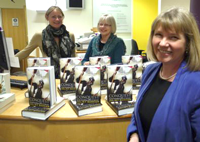 Saturday 20th March saw me in Kenilworth for the Warwick Literary Festival. No, I wasn’t in the wrong place – the festival is run by Keith and Frances who own Warwick Books and Kenilworth Books. Independent booksellers are a national treasure and they ought to be cherished for their enterprise, knowledge and staying power. We had a small but interested audience which took the opportunity to grill me at length and then bought a remarkable number of books. Such interaction is rarely possible but it is so rewarding. This festival deserves far greater support: at such a central location it should be easy to attract people from all over Warwickshire and from Coventry too. Surely it must be more fun to meet an author face to face than to sit inside watching telly! Why not take a look at their website www.warwickbooks.net and just see what you’re missing!
Saturday 20th March saw me in Kenilworth for the Warwick Literary Festival. No, I wasn’t in the wrong place – the festival is run by Keith and Frances who own Warwick Books and Kenilworth Books. Independent booksellers are a national treasure and they ought to be cherished for their enterprise, knowledge and staying power. We had a small but interested audience which took the opportunity to grill me at length and then bought a remarkable number of books. Such interaction is rarely possible but it is so rewarding. This festival deserves far greater support: at such a central location it should be easy to attract people from all over Warwickshire and from Coventry too. Surely it must be more fun to meet an author face to face than to sit inside watching telly! Why not take a look at their website www.warwickbooks.net and just see what you’re missing!
The following Saturday saw me retracing my steps, this time to Jesus College, Oxford, where I had agreed to talk to The Readers’ Voice Convention, a forum for representatives of reading groups throughout the country. I attended several sessions myself and was particularly impressed by the speakers who talked about their experiences setting up reading groups in prisons, among those with learning difficulties and mental health problems and in care-homes for the elderly. What came out so clearly was the value of a shared experience – even if it is just discussing a book – it prompts isolated individuals to come together, to talk and to explore their own feelings vicariously through those of the characters in their books. It was hugely impressive to learn the difference reading groups could make in bringing such people together. My own talk on the Brontës seemed pretty insignificant stuff compared to this.”
..............................................................................................................................................
Friday 12th March 2010:
“O dear. What a long time since I last wrote a blog! The reason being, once again, that there was nothing to report. I’ve been slogging away at the new edition of The Brontës, which proved to be a far bigger task than I’d anticipated. I’ve been working all hours God sends – and many he does not – so much so that I’ve forgotten how to sleep. However the new all-singing, all-dancing revised edition was delivered to my publisher at 11.30pm on 28th February: exactly half an hour before my deadline expired!
 So it was with a wonderful sense of release that I finally got out of the house for a talk to some 300 members of the Hull Literary and Philosophical Society on 2nd March, followed by one of my favourite literary festivals, Ways With Words at Keswick on 9th March. We travelled up through the Dales to the Lakes on a blissfully balmy spring morning: the sky a perfect unblemished arch of blue,
So it was with a wonderful sense of release that I finally got out of the house for a talk to some 300 members of the Hull Literary and Philosophical Society on 2nd March, followed by one of my favourite literary festivals, Ways With Words at Keswick on 9th March. We travelled up through the Dales to the Lakes on a blissfully balmy spring morning: the sky a perfect unblemished arch of blue, 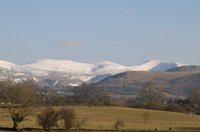 the mountains crowned with snow circling the horizon and tiny lambs skipping in the fields below. After weeks of being snowed in when every attempt to get out was a major struggle it was good to see the snow where it belongs – on the hill-tops. Walking down the quiet country lanes round Keswick everything looked as though it had been spring-cleaned: the holly a burnished dark green, undulating drifts of pristine white snowdrops, even the moss covering the walls and stones seemed a more brilliant shade of emerald.
the mountains crowned with snow circling the horizon and tiny lambs skipping in the fields below. After weeks of being snowed in when every attempt to get out was a major struggle it was good to see the snow where it belongs – on the hill-tops. Walking down the quiet country lanes round Keswick everything looked as though it had been spring-cleaned: the holly a burnished dark green, undulating drifts of pristine white snowdrops, even the moss covering the walls and stones seemed a more brilliant shade of emerald.
 We stayed, as usual, at my favourite hotel: it’s family run and has friendly staff, superb food and fantastic views – all enhanced by the opportunity to meet and have dinner together with the other authors. (It’s funny how whenever a group of writers get together they always end up talking about money.) No surprise, then, to find that Ways With Words has not only a loyal following among its audiences but also among its authors. Kay and Steve, (pictured with me after my talk at the Theatre by the Lake) are always so welcoming and hospitable that everyone wants another invitation. Where else could you meet such a diverse group of people – Gervase Phinn, Michael Buerk and Eric Lonergan – all of whom share a passion for words and ideas? The Theatre by the Lake is a superb venue too: literally yards from the shore of Derwentwater but sympathetically built in traditional grey Lakeland stone and slate and screened by trees so you’d hardly know it was there. It’s not one of these dreadful in-your-face modern buildings that are an affront to the eye but it makes just as powerful a statement, only through the facilities it offers rather than its appearance. Lakeland is lucky to have such a venue and even luckier to have its annual Ways With Words literary festival. Kay and Steve – please will you invite me again?"
We stayed, as usual, at my favourite hotel: it’s family run and has friendly staff, superb food and fantastic views – all enhanced by the opportunity to meet and have dinner together with the other authors. (It’s funny how whenever a group of writers get together they always end up talking about money.) No surprise, then, to find that Ways With Words has not only a loyal following among its audiences but also among its authors. Kay and Steve, (pictured with me after my talk at the Theatre by the Lake) are always so welcoming and hospitable that everyone wants another invitation. Where else could you meet such a diverse group of people – Gervase Phinn, Michael Buerk and Eric Lonergan – all of whom share a passion for words and ideas? The Theatre by the Lake is a superb venue too: literally yards from the shore of Derwentwater but sympathetically built in traditional grey Lakeland stone and slate and screened by trees so you’d hardly know it was there. It’s not one of these dreadful in-your-face modern buildings that are an affront to the eye but it makes just as powerful a statement, only through the facilities it offers rather than its appearance. Lakeland is lucky to have such a venue and even luckier to have its annual Ways With Words literary festival. Kay and Steve – please will you invite me again?"
..............................................................................................................................................
Saturday 23rd January 2010:
“A somewhat belated first blog for the New Year – mainly because there has been nothing to say. I’ve been working steadily on my revision of The Brontës and, until last Monday, I was completely housebound: the huge snowfalls we’ve had on a regular basis since before Christmas have just kept on coming. Christmas Day with snow-covered hills and trees was wonderful: New Year, when no one could get to us because the roads were impassable, was not so wonderful: and after two weeks of being literally frozen in (ice on the insides of the windows as well as outside) we were all heartily sick and tired of the snow. The thaw began last weekend and, though there are snow-filled hollows on the moors and it’s still ‘ligging under t’walls’ as they say here in Yorkshire, (which means there’s more to come to take it away), last Monday I was finally able to get out of the village. Which was fortunate as I had to be in London on Wednesday night and in Norwich on Friday morning.
I loathe London – I can’t bear the noise, the crush of people, the traffic – but this was an occasion I would have bitterly regretted missing: dinner in the House of Lords with General The Lord Guthrie of Craigiebank, who was Chief of the Defence Staff 1997-2001, and his wife. It was a fascinating evening which, I’m ashamed to say, also included my first visit to Westminster Hall (it smelt just like Duke Humphrey’s Library in the Bodleian). What a privilege to dine in such company and surroundings – and raise money for a good charitable cause in the process.
I didn’t feel very privileged on Friday when I had to give a talk in Norwich. I’m always consumed by nerves beforehand – I’m terrified of letting people down by not living up to expectations – and as the last speaker of five I had plenty of time to worry, especially as the other talks were so interesting that they were going to be a hard act to follow. The symposium was in the beautiful medieval church of St Peter Hungate, which was largely rebuilt in 1460 by Sir John Paston, of Paston letters fame. As you can probably tell from the photographs, however, it was also bitterly cold. I don’t often lecture wearing my coat and scarf but this was one occasion when it was absolutely necessary! The symposium had been arranged by Richard and Nina Kendrick for the thirteen-year-old pupils of Town Close House School who were an absolute pleasure to address: bright, interested and – despite the cold – full of enthusiasm for their subject. And some of their questions were more intelligent than those I get from adult audiences. The very first one floored me: ‘Did the English win Agincourt or did the French lose it?’ That’s one young man who will go far!
I left Norwich with two regrets: that we’d run out of time to answer all the questions the children wanted to ask and that I had to dash off to catch my train so missed a guided tour of the medieval Great Hospital. Which means I’ll just have to go back again!

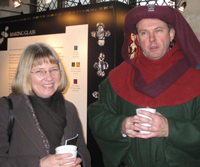 The pictures, taken by Paul King, show me with some of the other speakers: Dale Copley, manager of St Peter Hungate Medieval Art Centre, Carole Rawcliffe, Professor of Medieval History at the University of East Anglia, and Ian Pycroft, a medievalist and re-enactor, whose authentic medieval garb, as I pointed out to the children, meant that he was the only one who didn’t feel the appropriately sepulchral cold of the church.”
The pictures, taken by Paul King, show me with some of the other speakers: Dale Copley, manager of St Peter Hungate Medieval Art Centre, Carole Rawcliffe, Professor of Medieval History at the University of East Anglia, and Ian Pycroft, a medievalist and re-enactor, whose authentic medieval garb, as I pointed out to the children, meant that he was the only one who didn’t feel the appropriately sepulchral cold of the church.”
..............................................................................................................................................
Thursday 31st December 2009:
“It appears to be obligatory for most newspapers at the end of the year to look back and pick out the outstanding books published in the previous twelve months. I can’t imagine who bothers to plough through all the recommendations – other than authors desperately hoping that their own books have been selected (thank you Daily Telegraph and Sunday Times!) – but I thought I’d add my own two penn ‘orth in my final blog for 2009.
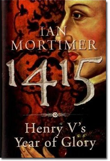 My favourite history book of the year was Ian Mortimer’s 1415: Henry V’s Year of Glory (Bodley Head), a clever reworking of the period sources presented in a roughly day-by-day fashion to create a diary or calendar of the year. Like the best diaries it is full of real insights: the sort of minutiae I love drawn from royal financial accounts but also an acute awareness of the impact on daily life of the social and especially religious rites of the church festivals. The format doesn’t always work and I disagree profoundly with Mortimer’s assessment of Henry’s character but it’s a fascinating and illuminating study of an extremely important year in European history.
My favourite history book of the year was Ian Mortimer’s 1415: Henry V’s Year of Glory (Bodley Head), a clever reworking of the period sources presented in a roughly day-by-day fashion to create a diary or calendar of the year. Like the best diaries it is full of real insights: the sort of minutiae I love drawn from royal financial accounts but also an acute awareness of the impact on daily life of the social and especially religious rites of the church festivals. The format doesn’t always work and I disagree profoundly with Mortimer’s assessment of Henry’s character but it’s a fascinating and illuminating study of an extremely important year in European history.
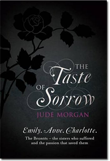 For me, however, the truly outstanding book of the year was a novel. This is surprising in itself, given that, although I enjoy fiction, I rarely get time to read it. What is even more surprising is that it is a novel about the Brontës. As a biographer I am usually hugely irritated by attempts to tell the Brontë story infictionalised form: I’m annoyed by the author’s lack of knowledge or understanding of the people and period and infuriated by the lurid sexing-up the Brontës’ lives in a misguided attempt to explain the power and passion of their fiction. (Whatever happened to imagination!!)
For me, however, the truly outstanding book of the year was a novel. This is surprising in itself, given that, although I enjoy fiction, I rarely get time to read it. What is even more surprising is that it is a novel about the Brontës. As a biographer I am usually hugely irritated by attempts to tell the Brontë story infictionalised form: I’m annoyed by the author’s lack of knowledge or understanding of the people and period and infuriated by the lurid sexing-up the Brontës’ lives in a misguided attempt to explain the power and passion of their fiction. (Whatever happened to imagination!!)
I confess when I first saw Jude Morgan’s The Taste of Sorrow (Headline) my heart sank: the title itself suggested yet another Mills and Boon treatment and after reading the first page (sex on the first page must be a record even for a novel about the Brontës!) I gave up in disgust. But then I was stuck on a train with nothing else to read and so I picked it up again and was forced to change my view completely. This is quite simply the most wonderful fictional evocation of the family, especially Charlotte, I have ever read. Morgan avoids both the pitfall of using sub-Hollywood dialogue of the ‘Good morning Miss Brontë! Good morning Mr Dickens!’ variety and the straitjacket imposed by relying too heavily on the Brontës’ own autobiographical writings. Indeed, he has no need to, for he has a wonderfully poetic command of language himself – and the ability to empathise so closely with his subjects that he brings them convincingly and vividly to life. The Taste of Sorrow is a brilliant book and one that should have been chosen by every single reviewer as one of the highlights of the publishing year. Make it your New Year’s Resolution to buy, beg or borrow a copy.”
..............................................................................................................................................
Saturday 12th December 2009:
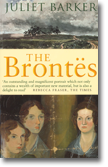 “For the last couple of weeks I have been immersed in preparing a new edition of The Brontës and it has been a rather strange experience. It’s not just that it’s now fifteen years since the book was first published and that for more than half that time I have been researching and writing about the medieval period: it’s that it has meant returning to work in the Brontë Parsonage Museum library – something I last did in 1989 when I left my post there after six years as curator and librarian. Much as I enjoyed my job, however, it is infinitely preferable to be on the other side! And exciting though it was to see the latest acquisitions, especially Charlotte’s exquisitely detailed miniature pencil drawing of the Wellington monument (a mere 74mm by 54mm in size) and a page which was not much larger from the manuscript of her little book Anecdotes of the Duke of Wellington, it was also gratifying to discover how little new material has emerged since my biography was published.
“For the last couple of weeks I have been immersed in preparing a new edition of The Brontës and it has been a rather strange experience. It’s not just that it’s now fifteen years since the book was first published and that for more than half that time I have been researching and writing about the medieval period: it’s that it has meant returning to work in the Brontë Parsonage Museum library – something I last did in 1989 when I left my post there after six years as curator and librarian. Much as I enjoyed my job, however, it is infinitely preferable to be on the other side! And exciting though it was to see the latest acquisitions, especially Charlotte’s exquisitely detailed miniature pencil drawing of the Wellington monument (a mere 74mm by 54mm in size) and a page which was not much larger from the manuscript of her little book Anecdotes of the Duke of Wellington, it was also gratifying to discover how little new material has emerged since my biography was published.
One new discovery which has recently received much media attention is a Bible which was featured on the BBC’s Antiques Roadshow on 27 September. The owners believe that it once belonged to the Brontë family and that Charlotte was responsible for numerous hand-written annotations on its pages. The show’s experts apparently agreed with them and, as a consequence, valued it as being worth £10,000 or more. I didn’t see the programme but many of you who did have contacted me to ask if it really is a genuine item. What I have seen is copies of the annotated pages and I can categorically state that the hand-writing is definitely not Charlotte’s, nor indeed any other member of the Brontë family’s: other Brontë scholars such as Margaret Smith and Christine Alexander, who were also consulted, are of the same opinion. Even if it were a genuine item, the valuation is way too high.
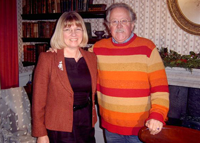 Today I was back in Haworth again, this time to film an interview. I arrived to find the Parsonage shrouded in bitterly cold, dank fog. A typical Brontë day, some might think, though the subject we were discussing was not. How did the Brontës celebrate Christmas? The simple answer is we do not know: apart from a poem by Anne celebrating music on Christmas morning and Mrs Gaskell’s passing reference to the recently married Charlotte and her husband taking a spice-cake as a gift to an elderly parishioner on Christmas Day, the biographical record is remarkably blank. Attending church would have been obligatory for the parson’s children but their novels suggest that the usual festivities were not neglected. There is goose with apple sauce for Christmas dinner at Wuthering Heights, not to mention dancing and carol-singing when the Gimmerton band arrives. And Jane Eyre’s preparations for her cousins’ return to Moor-House suggest first-hand experience: the ‘cleaning down’ of the house from top to bottom, laying fires in every room and the ‘solemnizing of … culinary rites’ including making Christmas cakes and mince-pies. It’s surely significant, though, as I pointed out to Mike Harding (pictured above) who interviewed me (in the Parsonage Dining Room of course!), that as children both Heathcliff and Jane Eyre are excluded from the family Christmas celebrations in their respective households. The interview, which is for a dvd on Christmas in Yorkshire, will be available next year.”
Today I was back in Haworth again, this time to film an interview. I arrived to find the Parsonage shrouded in bitterly cold, dank fog. A typical Brontë day, some might think, though the subject we were discussing was not. How did the Brontës celebrate Christmas? The simple answer is we do not know: apart from a poem by Anne celebrating music on Christmas morning and Mrs Gaskell’s passing reference to the recently married Charlotte and her husband taking a spice-cake as a gift to an elderly parishioner on Christmas Day, the biographical record is remarkably blank. Attending church would have been obligatory for the parson’s children but their novels suggest that the usual festivities were not neglected. There is goose with apple sauce for Christmas dinner at Wuthering Heights, not to mention dancing and carol-singing when the Gimmerton band arrives. And Jane Eyre’s preparations for her cousins’ return to Moor-House suggest first-hand experience: the ‘cleaning down’ of the house from top to bottom, laying fires in every room and the ‘solemnizing of … culinary rites’ including making Christmas cakes and mince-pies. It’s surely significant, though, as I pointed out to Mike Harding (pictured above) who interviewed me (in the Parsonage Dining Room of course!), that as children both Heathcliff and Jane Eyre are excluded from the family Christmas celebrations in their respective households. The interview, which is for a dvd on Christmas in Yorkshire, will be available next year.”
..............................................................................................................................................
Saturday 28th November 2009: 8am.
“It was bitterly cold this morning when I got up at first light to let out and feed the hens: my hands were so cold I could barely unlatch their pen. Now, as I sit at my desk looking out of the window, it is just starting to snow. Not the huge feathery white flakes which signal the sort of snowfall which, at least once a year, cuts off our Pennine village by blocking its steep and narrow roads, but a grey sludgy sleet. At least it makes a change from the rain which has poured relentlessly for the last couple of weeks, saturating the ground and causing new springs and waterfalls to burst out from the hillsides in unexpected places.
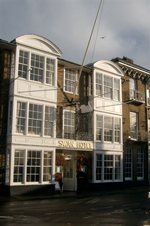 It was also raining two weeks ago when I was in Southwold for the Ways With Words Literary Festival. So much so that I had to run between the Swan Hotel and St Edmund Hall dodging the puddles and with my coat over my head as it was far too windy for an umbrella. Expecting to find that most people had taken the sensible option and stayed at home I was therefore amazed to find a packed hall and a hugely appreciative audience whose questions I might still be answering even now had we not been forced to bring the event to an end so that Michael Buerk could take to the stage. And what a performance he gave! He had the audience in stitches with his ‘grumpy old man’s rant’ - but it was also a depressingly accurate summation of the state of society today. And, as my husband and I discovered in conversation with him in the bar afterwards, despite his remarkable career he remains an utterly charming and unpretentious man.
It was also raining two weeks ago when I was in Southwold for the Ways With Words Literary Festival. So much so that I had to run between the Swan Hotel and St Edmund Hall dodging the puddles and with my coat over my head as it was far too windy for an umbrella. Expecting to find that most people had taken the sensible option and stayed at home I was therefore amazed to find a packed hall and a hugely appreciative audience whose questions I might still be answering even now had we not been forced to bring the event to an end so that Michael Buerk could take to the stage. And what a performance he gave! He had the audience in stitches with his ‘grumpy old man’s rant’ - but it was also a depressingly accurate summation of the state of society today. And, as my husband and I discovered in conversation with him in the bar afterwards, despite his remarkable career he remains an utterly charming and unpretentious man.
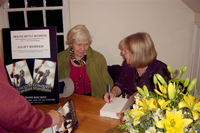 One of the great pleasures of attending a Ways With Words festival is that you get to meet both other authors and the literary aficionados whose stamina in attending event after event never fails to astonish me (You have to be prepared for an inquisition at breakfast from those who have attended your talk!) It was a particular thrill for me to meet Jane Gardam, (pictured right) the novelist who was one of the first reviewers of The Brontes: I knew that her son is the principal of my old college at Oxford, but we discovered a further mutual connection in Kirkby Stephen, the Westmorland town where she had a holiday home for many years and where my mother’s family came from. We continued chatting together as I signed books after my session. And as I did so one of the audience, Mark Fairweather, told me something I didn’t know (how typical of Southwold!) I’d told the story of a Norman gentleman who was saved from execution by a young girl offering to marry him: Mark told me that this French tradition was still in practice in eighteenth century Quebec and referred me to a Margaret Atwood poem called ‘Marrying the Hangman’.
One of the great pleasures of attending a Ways With Words festival is that you get to meet both other authors and the literary aficionados whose stamina in attending event after event never fails to astonish me (You have to be prepared for an inquisition at breakfast from those who have attended your talk!) It was a particular thrill for me to meet Jane Gardam, (pictured right) the novelist who was one of the first reviewers of The Brontes: I knew that her son is the principal of my old college at Oxford, but we discovered a further mutual connection in Kirkby Stephen, the Westmorland town where she had a holiday home for many years and where my mother’s family came from. We continued chatting together as I signed books after my session. And as I did so one of the audience, Mark Fairweather, told me something I didn’t know (how typical of Southwold!) I’d told the story of a Norman gentleman who was saved from execution by a young girl offering to marry him: Mark told me that this French tradition was still in practice in eighteenth century Quebec and referred me to a Margaret Atwood poem called ‘Marrying the Hangman’.
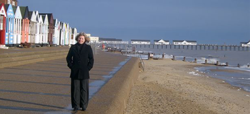 Next morning there was just time between the gathering rain clouds to grab a brisk walk along the promenade before we had to set off home: actually, as you can see from the photo, it was more of a battle with the elements. We keep promising ourselves that one day, other responsibilities permitting, we’ll join the audience and spend a whole week at the Southwold Literary Festival – though I confess that I’ll probably have to sneak away to explore all those exquisite Suffolk churches glimpsed as we passed through villages which exert an equally powerful siren call."
Next morning there was just time between the gathering rain clouds to grab a brisk walk along the promenade before we had to set off home: actually, as you can see from the photo, it was more of a battle with the elements. We keep promising ourselves that one day, other responsibilities permitting, we’ll join the audience and spend a whole week at the Southwold Literary Festival – though I confess that I’ll probably have to sneak away to explore all those exquisite Suffolk churches glimpsed as we passed through villages which exert an equally powerful siren call."
..............................................................................................................................................
Thursday 12th November 2009:
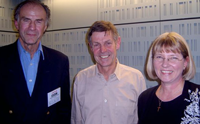 “I have to confess that most of my heroes since childhood have been historical ones. On Tuesday, however, I met a man who has a better claim than most to be a living hero: the soldier, explorer and adventurer Sir Ranulph Fiennes (pictured far left), whose many achievements include being the first man to have crossed both poles by land and climb the world’s highest mountain Everest: in the process he has raised over £14 million for charity. Sir Ranulph can trace his family back forty-one generations and has discovered that he had ancestors on both sides of the Hundred Years War. He was the guest on BBC Radio 4’s new series of Great Lives and he had chosen one of them, Henry V, as his inspirational hero: I was invited on the programme as an expert on the king. We talked about why Henry was – and still is - regarded as one of the greatest kings ever to have ruled England and in the impassioned discussion that followed it emerged that for Sir Ranulph it is Henry’s military leadership that makes him a hero, whereas I probably value at least as highly his administrative abilities and determination to do justice to all. Sir Ranulph spoke movingly about how the men who had served under his father, who was killed in action before he was born, revered his memory because, like Henry V, he had led from the front and endured the same privations as them. You can hear the programme on Radio 4 on 8 December at 4.30pm: it’s repeated on 11 December at 11pm and will be available to listen to again on the BBC website. The photo shows Sir Ranulph and I standing either side of the programme’s presenter, Matthew Parris, in the recording studio at Broadcasting House in London
“I have to confess that most of my heroes since childhood have been historical ones. On Tuesday, however, I met a man who has a better claim than most to be a living hero: the soldier, explorer and adventurer Sir Ranulph Fiennes (pictured far left), whose many achievements include being the first man to have crossed both poles by land and climb the world’s highest mountain Everest: in the process he has raised over £14 million for charity. Sir Ranulph can trace his family back forty-one generations and has discovered that he had ancestors on both sides of the Hundred Years War. He was the guest on BBC Radio 4’s new series of Great Lives and he had chosen one of them, Henry V, as his inspirational hero: I was invited on the programme as an expert on the king. We talked about why Henry was – and still is - regarded as one of the greatest kings ever to have ruled England and in the impassioned discussion that followed it emerged that for Sir Ranulph it is Henry’s military leadership that makes him a hero, whereas I probably value at least as highly his administrative abilities and determination to do justice to all. Sir Ranulph spoke movingly about how the men who had served under his father, who was killed in action before he was born, revered his memory because, like Henry V, he had led from the front and endured the same privations as them. You can hear the programme on Radio 4 on 8 December at 4.30pm: it’s repeated on 11 December at 11pm and will be available to listen to again on the BBC website. The photo shows Sir Ranulph and I standing either side of the programme’s presenter, Matthew Parris, in the recording studio at Broadcasting House in London
The BBC – and indeed Radio 4 – also played a pivotal role in my life in the late 1980s when I was one of a very closely knit team of people who recorded two series of a programme called ‘Take a Place Like …’.  We would visit towns throughout the UK to discover what made each one special and different: I was the historian, John Grundy the architectural historian and Stanley Ellis (pictured left) the dialect expert. Together with the producer, Geoff Sargieson, and sound recordist, Graeme Aldous, we had an absolute ball visiting places as diverse as Beccles and Goole, Peel and Leith. It was fascinating to discover all the eccentricities of each place and to learn so much about not just the past but also the present. It was also the most enormous fun, not least because as a team we shared the same sense of humour: I don’t think I have ever laughed so much in all my life as during the two years we recorded the programme. We’ve all remained friends and stayed in touch but today we marked the breaking of the circle. Our dear old friend (we always called him ‘the old man’) Stanley Ellis died, aged 83, on 31st October and we met again at his funeral in Harrogate. Stanley had a genius for friendship with old and young but he was also the leading authority on dialect who, as a young man, had toured England recording elderly people talking about their way of life for what has now become the internationally renowned archive The Survey of English Dialect at the University of Leeds. In the process he acquired an encyclopaedic knowledge of not just dialect but the derivation of names and development of language: he could place an accent to within a few streets of a town – as he did most successfully in the case of the hoax Yorkshire Ripper tapes – and was an expert forensic witness in many trials. He was often asked ‘where do I come from?’ by people wanting to test his skill as if it were a party trick: to which, with his usual dry wit, he would reply, ‘Why, don’t you know?’ We teased him mercilessly: setting him up after a well lubricated dinner to record ‘The Leith police dismisseth us’ outside the Leith police station and we were wonderfully rewarded on one glorious occasion when he asked a waiter ‘What part of Germany are you from?’ only to be told ‘Portugal’. We all loved him dearly and he will be sadly missed.”
We would visit towns throughout the UK to discover what made each one special and different: I was the historian, John Grundy the architectural historian and Stanley Ellis (pictured left) the dialect expert. Together with the producer, Geoff Sargieson, and sound recordist, Graeme Aldous, we had an absolute ball visiting places as diverse as Beccles and Goole, Peel and Leith. It was fascinating to discover all the eccentricities of each place and to learn so much about not just the past but also the present. It was also the most enormous fun, not least because as a team we shared the same sense of humour: I don’t think I have ever laughed so much in all my life as during the two years we recorded the programme. We’ve all remained friends and stayed in touch but today we marked the breaking of the circle. Our dear old friend (we always called him ‘the old man’) Stanley Ellis died, aged 83, on 31st October and we met again at his funeral in Harrogate. Stanley had a genius for friendship with old and young but he was also the leading authority on dialect who, as a young man, had toured England recording elderly people talking about their way of life for what has now become the internationally renowned archive The Survey of English Dialect at the University of Leeds. In the process he acquired an encyclopaedic knowledge of not just dialect but the derivation of names and development of language: he could place an accent to within a few streets of a town – as he did most successfully in the case of the hoax Yorkshire Ripper tapes – and was an expert forensic witness in many trials. He was often asked ‘where do I come from?’ by people wanting to test his skill as if it were a party trick: to which, with his usual dry wit, he would reply, ‘Why, don’t you know?’ We teased him mercilessly: setting him up after a well lubricated dinner to record ‘The Leith police dismisseth us’ outside the Leith police station and we were wonderfully rewarded on one glorious occasion when he asked a waiter ‘What part of Germany are you from?’ only to be told ‘Portugal’. We all loved him dearly and he will be sadly missed.”
..............................................................................................................................................................................................
Friday 23rd October 2009:
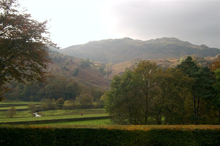 “10.30 am. William Wordsworth certainly knew how to choose the perfect site for a house. This morning I’m sitting for the last time in the bow-window of the old library at Lancrigg, the charming farmhouse in Easedale that his friend, Elizabeth Fletcher, bought and refurbished on Wordsworth’s advice. Framed by autumnal trees the view across the valley could almost be a picture-postcard: in the middle distance a stone bridge straddles the beck which runs through the green fields where sheep as grey as the rocks are grazing; beyond them, rising from a sea of rusty-brown bracken, soar the craggy stone outcrops which give the Lakeland fells their distinctive horizons.
“10.30 am. William Wordsworth certainly knew how to choose the perfect site for a house. This morning I’m sitting for the last time in the bow-window of the old library at Lancrigg, the charming farmhouse in Easedale that his friend, Elizabeth Fletcher, bought and refurbished on Wordsworth’s advice. Framed by autumnal trees the view across the valley could almost be a picture-postcard: in the middle distance a stone bridge straddles the beck which runs through the green fields where sheep as grey as the rocks are grazing; beyond them, rising from a sea of rusty-brown bracken, soar the craggy stone outcrops which give the Lakeland fells their distinctive horizons.
My husband and I have been staying here for a few days while both our children are away: it’s an opportunity to go walking and revisit the places we grew to love when I was writing my biography of Wordsworth. For the final year of my research I spent two days every week in the archives of the Wordsworth Trust at Grasmere. I’d drive up from the South Pennines early on Monday morning so that I could be on the doorstep when the library opened at 9.30am, work through till it shut in the evening, stay overnight at How Foot, get up early the next morning to go walking before breakfast, then spend all Tuesday working in the library again, driving home again when it shut. For five weeks during the summer, (when it rained virtually every day as my children never cease to remind me), the family stayed with me in the Lakes while I worked every hour the library was open. Exhausting – but worth it for the vast amount of unpublished material I was able to incorporate into my biography and for the opportunity to get to know intimately Wordsworth’s beloved Lakes which shaped and informed his poetry.
Charlotte Brontë said that her sisters’ poetry always came line by line into her head whenever she walked the moors round Haworth: the same is true for me of Wordsworth and the Lakes. The day we arrived we took one of Dorothy’s favourite walks up Easedale, her ‘dark quarter’, past the heart-shaped sheep-fold at the foot of the wonderfully and perfectly named waterfalls of Sour Milk Ghyll to the tarn in the hollow of the hills at the head of the dale. Naturally it rained most of the way. It’s a curious thing about Lake District rain: in my part of Yorkshire the wind drives the rain so hard and at such an angle that it is like being on the receiving end of a volley of arrows at Agincourt. Here it has an insidious quality: it appears to be soft and mist-like (mizzling we call it in Yorkshire), but almost without you knowing it, it permeates everything you’re wearing till you are soaked to the skin and chilled to the bone.
Fortunately, the next two days were dry. On Wednesday, after buying and posting emergency rations of Sarah Nelson’s inimitable Grasmere gingerbread to our children (and keeping some for ourselves!), we walked the circuit of Grasmere Lake and Rydal Water, with a small detour to John’s Wood where William and Dorothy’s brother, captain of an East Indiaman, used to pace up and down, the wind in the trees reminding him of being at sea. Taking the so-called ‘coffin route’ from Grasmere, we climbed over White Moss Common, where I always like to imagine Wordsworth’s Leech-gatherer at work, to *Rydal Mount, the Wordsworth family home for 46 years, which lives and breathes the poet, who created the house and gardens there, in a way that makes his better-known and much briefer home at Dove Cottage seem sterile. After a quick coffee in the excellent new garden tearoom and a visit, at the insistence of my friends Peter and Marian, the custodians there, to see the newly acquired paperknife which, uniquely, incorporates in the handle locks of hair belonging to William, his wife Mary and their daughter Dora, we followed in the footsteps of one of the Wordsworths’ favourite walks round Rydal Water, where there are still swans as there were in their day, and over Loughrigg Terraces back to Grasmere and Easedale.
*Link to Rydal Mount http://www.rydalmount.co.uk
Yesterday, our last full day in the Lakes, we dedicated to perhaps the most evocative of all the walks associated with Wordsworth: Grisedale Tarn. It was at this remote spot on the flanks of Helvellyn, some 1800 feet above sea-level, at the foot of the still black waters cupped in the bowl where Fairfield, Dollywagon Pike and Seat Sandal meet, that William and Dorothy parted with their brother John, who was returning to sea to win them all the fortune that would enable him to retire to Grasmere and relieve his brother of the financial worries that threatened his future as a poet. John would never return, going down with his ship when it sank in storms off the Isle of Portland on 5 February 1805. On the rock where they parted are carved some of Wordsworth’s wonderful lines from ‘Elegiac Verses in Memory of my Brother’, composed several months later at this very spot. The lettering has been virtually obliterated by wind and rain and the rock itself defaced by a crude metal sign stuck on a post rammed into the top with all the subtlety of a cocktail sausage on a stick. Even so, knowing the poem and standing where they once stood, looking out over the dolls-house scenery of Patterdale far below, with the dull gleam of Ullswater in the distance, I find it impossible not to feel the emotion that haunts the place. I love the Lakes for their exquisite beauty in all seasons but Wordsworth’s poetry adds a dimension which touches the very soul.

..............................................................................................................................................................................................
Monday 12th October 2009:
“There are times when my life seems utterly bizarre and this last week has been one of them. Last Monday I found myself being waited on hand and foot at a small dinner party in an exquisite medieval castle which had once belonged to a veteran of Agincourt; what made this wonderful experience utterly surreal was that a fellow guest was the Princess Royal. 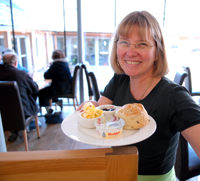 Three days later there I was doing what has become my usual shift working as a volunteer waitress at the Granary Café, run by Caring For Life (www.caringforlife.co.uk ), a charity which cares for vulnerable and homeless people. Lots of people – some of them from many miles away – were bringing their harvest offerings to the farm, helping to provide literally thousands of meals for those whom the charity supports on a daily basis. Since many of the harvest-bringers chose to have breakfast, lunch or afternoon tea in the café before they returned home we were run off our feet all day. I couldn’t help wondering what some of those I had served would have felt if they had known what I had been doing just a few days earlier! Or if they had known that just a few days later I’d be dining with Oleg Gordievsky, the former KGB chief who became a double agent and made a dramatic escape to the West in 1985. Anonymity is a wonderful and precious thing!
Three days later there I was doing what has become my usual shift working as a volunteer waitress at the Granary Café, run by Caring For Life (www.caringforlife.co.uk ), a charity which cares for vulnerable and homeless people. Lots of people – some of them from many miles away – were bringing their harvest offerings to the farm, helping to provide literally thousands of meals for those whom the charity supports on a daily basis. Since many of the harvest-bringers chose to have breakfast, lunch or afternoon tea in the café before they returned home we were run off our feet all day. I couldn’t help wondering what some of those I had served would have felt if they had known what I had been doing just a few days earlier! Or if they had known that just a few days later I’d be dining with Oleg Gordievsky, the former KGB chief who became a double agent and made a dramatic escape to the West in 1985. Anonymity is a wonderful and precious thing!
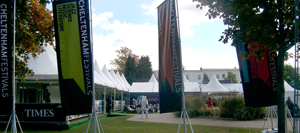 Gordievsky was, like me, appearing at the Cheltenham Literature Festival which grows bigger and better every time I visit. Unfortunately, our events on the Sunday evening clashed so, while he was regaling a large audience with his exploits in the main hall, I was sitting on a stage in a tent with Erica Wagner, the literary editor of The Times, and William Dalrymple, the flamboyant author of White Mughals and The Last Moghal. A small but select group had gathered to hear us discuss The NovelList, the 60 favourite novels of Times readers published since 1949. Both of my fellow panellists were far more erudite than me and familiar with most of the books on the list. I’m ashamed to say I had read just 7 out of the top 20 – but then as it was favourite novels, rather than best novels, it was rather an eclectic list. Top of the poll was To Kill a Mocking Bird, which was fair enough I suppose, but second was Ken Follett’s The Pillars of the Earth. Surely not a book you’d really choose over Catch-22, Lord of the Rings or The French Lieutenant’s Woman? And why was there no Daphne du Maurier or Laurie Lee (if they could include Frank McCourt’s Angela’s Ashes why not A Moment of War my favourite work by Laurie Lee?) I was even more disappointed that my own choice, T H White’s The Once and Future King, which I’d championed in The Times
http://entertainment.timesonline.co.uk/tol/arts_and_entertainment/books/article6825116.ece didn’t even make it on to the long list. You can see what you think about the choice of books by looking on the same link at article6866488.
Gordievsky was, like me, appearing at the Cheltenham Literature Festival which grows bigger and better every time I visit. Unfortunately, our events on the Sunday evening clashed so, while he was regaling a large audience with his exploits in the main hall, I was sitting on a stage in a tent with Erica Wagner, the literary editor of The Times, and William Dalrymple, the flamboyant author of White Mughals and The Last Moghal. A small but select group had gathered to hear us discuss The NovelList, the 60 favourite novels of Times readers published since 1949. Both of my fellow panellists were far more erudite than me and familiar with most of the books on the list. I’m ashamed to say I had read just 7 out of the top 20 – but then as it was favourite novels, rather than best novels, it was rather an eclectic list. Top of the poll was To Kill a Mocking Bird, which was fair enough I suppose, but second was Ken Follett’s The Pillars of the Earth. Surely not a book you’d really choose over Catch-22, Lord of the Rings or The French Lieutenant’s Woman? And why was there no Daphne du Maurier or Laurie Lee (if they could include Frank McCourt’s Angela’s Ashes why not A Moment of War my favourite work by Laurie Lee?) I was even more disappointed that my own choice, T H White’s The Once and Future King, which I’d championed in The Times
http://entertainment.timesonline.co.uk/tol/arts_and_entertainment/books/article6825116.ece didn’t even make it on to the long list. You can see what you think about the choice of books by looking on the same link at article6866488.
Thanks to the Summerfield Trust, a sponsor of the Festival which is celebrating its 20th anniversary of grant-giving in Gloucestershire, I didn’t have to spend my evening in my hotel room staring at the wallpaper and dining on room-service. Instead, I had a most enjoyable evening in the convivial company of, amongst others, Lavinia Sidgwick, the lovely lady who was to chair my event the next day, Martin Davis, one of the first trustees, and Henry Porter, the novelist and political commentator. I didn’t dare speak to Oleg Gordievsky, the guest of honour, any more than I had summoned up the courage to talk to the Princess Royal. But at least I was there!
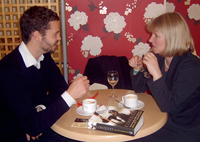 Next morning was The Big Event: my first talk about Conquest. I was up at 6 am revising my speech, having just learned via a text message that the cd-rom with the illustrations had not arrived. By 9 am I was sat in the Writers’ Room, trying to keep my nerves at bay by writing my notes out yet again. (I couldn’t help noticing as I sat there that the first thing every writer does on arrival is scan the room for someone famous – I’m guilty of it myself – but it’s usually disappointing. The only person I recognised was Sandy Toksvig, whom I passed in the corridor.) By 9.30am it had become plain something was wrong as no one had turned up to meet me. Than I discovered that I was in the wrong writers’ room: I should have been at the Everyman Theatre where an increasingly worried Lavinia was wondering what had happened to me. A quick scuttle across town to the Everyman left me with time barely to catch my breath before it was on stage and launching into my talk.
Next morning was The Big Event: my first talk about Conquest. I was up at 6 am revising my speech, having just learned via a text message that the cd-rom with the illustrations had not arrived. By 9 am I was sat in the Writers’ Room, trying to keep my nerves at bay by writing my notes out yet again. (I couldn’t help noticing as I sat there that the first thing every writer does on arrival is scan the room for someone famous – I’m guilty of it myself – but it’s usually disappointing. The only person I recognised was Sandy Toksvig, whom I passed in the corridor.) By 9.30am it had become plain something was wrong as no one had turned up to meet me. Than I discovered that I was in the wrong writers’ room: I should have been at the Everyman Theatre where an increasingly worried Lavinia was wondering what had happened to me. A quick scuttle across town to the Everyman left me with time barely to catch my breath before it was on stage and launching into my talk.
Fortunately it all went incredibly well. The Cheltenham audiences are always appreciative and quick to respond. They also ask lots of interesting questions – though I was floored by one lady who asked (apropos of the similarities I had pointed out between the conduct of the war in France and the current war in Afghanistan) why we never learn from our mistakes. It was especially gratifying to talk to so many people who bought books afterwards – most of all the two stagehands who had listened from the wings and were so taken by the subject that they decided to buy the book!
The question I was asked most often by those buying the book was ‘what are you going to write next?’ The new edition of The Brontës is my next project but then what? I’m not sure, though I had a fruitful discussion back in the Writers’ Room with my editor, Tim Whiting, of Little, Brown, who’d travelled up from London to come to my event. Certainly something medieval. Possibly the Wars of the Roses? Or possibly a more general book on knighthood? We shall see.”
..............................................................................................................................................................................................
Sunday 27th September 2009:
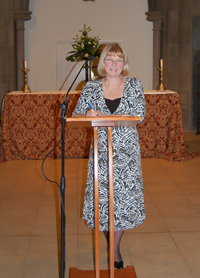 “A very busy week, top and tailed by my first literary events in the build-up to the publication of mynew book Conquest. Last Sunday it was the Independent Booksellers’ Forum Annual Dinner at Warwick University.It’s always a terrifying prospect speaking to a vast room full of people you don’t know – and special thanks are due to Helen from Bewdley Books who very kindly took pity on me as I stood forlornly wondering where to start as the crowds gathered before the dinner. Commiserations are also due to the poor man who had to sit next to me at dinner as my moment in the spotlight approached and was stricken with nerves.There were seven authors speaking, two between drinks and starters, three (of which I had been allocated the middle slot) between starters and mains, and two between main course and dessert. We had all been told in no uncertain terms that we had 3 minutes to speak – so after the first speaker spoke for 20 minutes and the next for almost as long I started to panic. Three minutes was what I had prepared and 3 minutes was what they were going to get! But as everyone else before me went well over the time-limit, my 3 minutes began to look like short-change. And having wound myself up for my slot, I couldn’t believe it when the speaker after me was introduced first and I had to sit there for another grim 10 minutes or so, thinking I might have been left out altogether, before it was finally my turn. I hope my contribution was interesting and entertaining – it was certainly the shortest by a long margin!The highlight of the evening for me was the after-dinner speaker, Gyles Brandreth,
“A very busy week, top and tailed by my first literary events in the build-up to the publication of mynew book Conquest. Last Sunday it was the Independent Booksellers’ Forum Annual Dinner at Warwick University.It’s always a terrifying prospect speaking to a vast room full of people you don’t know – and special thanks are due to Helen from Bewdley Books who very kindly took pity on me as I stood forlornly wondering where to start as the crowds gathered before the dinner. Commiserations are also due to the poor man who had to sit next to me at dinner as my moment in the spotlight approached and was stricken with nerves.There were seven authors speaking, two between drinks and starters, three (of which I had been allocated the middle slot) between starters and mains, and two between main course and dessert. We had all been told in no uncertain terms that we had 3 minutes to speak – so after the first speaker spoke for 20 minutes and the next for almost as long I started to panic. Three minutes was what I had prepared and 3 minutes was what they were going to get! But as everyone else before me went well over the time-limit, my 3 minutes began to look like short-change. And having wound myself up for my slot, I couldn’t believe it when the speaker after me was introduced first and I had to sit there for another grim 10 minutes or so, thinking I might have been left out altogether, before it was finally my turn. I hope my contribution was interesting and entertaining – it was certainly the shortest by a long margin!The highlight of the evening for me was the after-dinner speaker, Gyles Brandreth, a natural performer if ever there was one, with a host of very funny quick-fire one-liners at his finger-tips: the jokes came so fast and furious that it was almost impossible to catch them all.
Last night I swapped my medieval hat for my Brontë one and went to Dewsbury to celebrate the bi-centennial of the arrival in Yorkshire of the Reverend Patrick Brontë. There was a special resonance to the occasion in that the event was held in Dewsbury Minster, the very church where Patrick himself had served for 16 months as curate to the Reverend John Buckworth – the rest, as they say, is history.
I always think Patrick is one of the most unjustly maligned people in the history of English literature so it was a pleasure to have the opportunity to sing the praises of this remarkable man before a packed audience. The best part of such events for me is always the question and answer session at the end – at least I know I’m telling the audience what they really want to know! – and this was no exception. We had lots of interesting questions from a clearly knowledgeable audience and I hope a good time was had by all. Afterwards I had an all too brief tour of the splendid exhibition on the life and times of Patrick Brontë in Dewsbury which is on display in the Minster until 17 October. I hope it finds a permanent home in the town: it deserves one." (Photos by Joanne Catlow)
a natural performer if ever there was one, with a host of very funny quick-fire one-liners at his finger-tips: the jokes came so fast and furious that it was almost impossible to catch them all.
Last night I swapped my medieval hat for my Brontë one and went to Dewsbury to celebrate the bi-centennial of the arrival in Yorkshire of the Reverend Patrick Brontë. There was a special resonance to the occasion in that the event was held in Dewsbury Minster, the very church where Patrick himself had served for 16 months as curate to the Reverend John Buckworth – the rest, as they say, is history.
I always think Patrick is one of the most unjustly maligned people in the history of English literature so it was a pleasure to have the opportunity to sing the praises of this remarkable man before a packed audience. The best part of such events for me is always the question and answer session at the end – at least I know I’m telling the audience what they really want to know! – and this was no exception. We had lots of interesting questions from a clearly knowledgeable audience and I hope a good time was had by all. Afterwards I had an all too brief tour of the splendid exhibition on the life and times of Patrick Brontë in Dewsbury which is on display in the Minster until 17 October. I hope it finds a permanent home in the town: it deserves one." (Photos by Joanne Catlow)
..............................................................................................................................................................................................
Saturday 12th September 2009:
Today was an extraordinary day. Not just because for the fourth day in a row we woke up to cloudless blue skies and glorious sunshine – a brief taste of the summer we’ve never had this year – but because it was a highlight in the calendar for one of my favourite causes: Harvest Thanksgiving and Supporters’ Day at Caring For Life.
I became involved in this wonderful charity over five years ago and was so impressed that I wrote a book about them (The Deafening Sound of Silent Tears). Once you’ve actually been there and seen the work they do with people who have been rejected by everyone else in society – including government agencies supposedly there to help – it’s impossible not to be drawn in. The people who are cared for come from all sorts of backgrounds: many have been severely abused, have learning difficulties and/or mental or physical health problems. As a result many have fallen into crime or homelessness. CFL – uniquely – promises to look after them for life and its network of dedicated staff, volunteers and supporters provide the family that most of them have never had. Despite their tragic backgrounds, visiting CFL is always an uplifting experience: it feels wonderful to me to belong to such a tightly knit and caring community. How much more so for those poor souls who are cared for, I cannot begin to imagine.
 It was my privilege to hand out the certificates of achievement to the ‘young’ people. (They’re still affectionately called ‘young’ from force of habit though most are now well into middle age.) To see the pleasure that these awards give to the recipients is overwhelming: some of the achievements might seem minor but each individual who has taken a small step on the literacy or arts programmes, or taken responsibility for looking after some of the animals on the farm, has made an enormous stride on the path towards self-respect and becoming integrated into a community that really cares.
It was my privilege to hand out the certificates of achievement to the ‘young’ people. (They’re still affectionately called ‘young’ from force of habit though most are now well into middle age.) To see the pleasure that these awards give to the recipients is overwhelming: some of the achievements might seem minor but each individual who has taken a small step on the literacy or arts programmes, or taken responsibility for looking after some of the animals on the farm, has made an enormous stride on the path towards self-respect and becoming integrated into a community that really cares.
What I really love about doing this is when some of the young people are so thrilled by the award and the applause from supporters that they grin from ear to ear, proudly display their certificates to the crowd and (if I’m lucky) give me a great big hug. I’m always careful with new people I don’t yet know just to shake their hand, in case they have Asperger’s or autism and dislike physical contact, so the real highlight for me was when one young man, at least six foot tall, seized me in a bear hug, enthusiastically clapping his hands behind my back, and wouldn’t let me go! It’s moments like these that are both humbling and precious: such a little thing can mean so much.
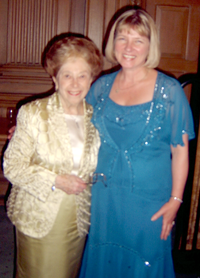 In the evening we celebrated achievement of a very different kind. I’ve long been a fan of the redoubtable Dame Fanny Waterman, the founder and mainstay of the Leeds International Piano Competition. Apart from the fact that she is one of the very few people who actually makes me feel tall, I admire her enthusiasm, her indefatigable energy (at 89 she has far more than I do) and her perfectionism. My husband had been to many of the early rounds of the competition over the last three weeks: I only got to a few sessions but it was good to see some of the people I’d seen going through to become one of the six finalists, each of whom played a concerto in Leeds Town Hall with the Hallé Orchestra conducted by Sir Mark Elder.
In the evening we celebrated achievement of a very different kind. I’ve long been a fan of the redoubtable Dame Fanny Waterman, the founder and mainstay of the Leeds International Piano Competition. Apart from the fact that she is one of the very few people who actually makes me feel tall, I admire her enthusiasm, her indefatigable energy (at 89 she has far more than I do) and her perfectionism. My husband had been to many of the early rounds of the competition over the last three weeks: I only got to a few sessions but it was good to see some of the people I’d seen going through to become one of the six finalists, each of whom played a concerto in Leeds Town Hall with the Hallé Orchestra conducted by Sir Mark Elder.
Tonight was the last evening of the competition when the results would be announced. How the judges decide I do not know. I always find it especially difficult to distinguish between my appreciation for the pianist’s talent and my preference for the actual music they play: if it’s a piece I love then I’m instinctively drawn to the player. There always seem to be two or three who deserve to win – but how to rank them when their ages can range from 14 to 29 and they are all playing different pieces? At least this time three of the six had chosen to play the Beethoven Emperor concerto – it never having featured in a final before! Even I could tell which were the better performances when comparing like with like, but the audience jury was certainly out over who would be the eventual winner. It was a close-run thing but in the end the first prize went to the 29-year-old Russian Sofya Gulyak– the first female winner in the twenty-year history of the competition – vindicating the comments made to me earlier by one of judges that technical brilliance (which even the youngest competitors have in abundance) is not enough: the music has to be felt from the soul. You have to know and understand what the composer himself was feeling when he wrote it – and that is a quality which only age and experience can bring. Or a good biography, as I was tempted to correct him!
..............................................................................................................................................................................................
Tuesday 1st September 2009:
9pm - "We’ve been home for a week, it’s poured with rain every day and I haven’t been able to get warm at all. Arrived to find Urgeon the Sturgeon had died and Buffy had lost her tail feathers. There was a mountain of post and e-mails, including the proofs for my article on the medieval laws of war for the October issue of the BBC History Magazine and a request for 300 words on my favourite novel of the last 60 years for The Times (see articles). The choice for the latter is easy – it’s always T. H. White’s brilliant The Once and Future King but the deadline was 36 hours away, there was no food in the house and, crucially, daughter’s exam results due on d-day itself. Fortunately they extended the deadline and I delivered the article by e-mail this morning (how different from the days when I had to slog two miles to the nearest post-box!), so it should be published on 7th September."
..............................................................................................................................................................................................
Tuesday 25th August 2009:
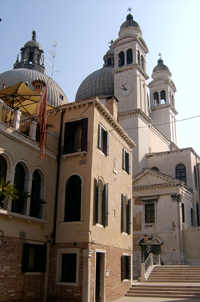
"Today the Venice idyll ends as we reluctantly
return home to reality. People
often ask us why we keep coming back here – and I can’t count the number
of times I’ve met visitors sitting by the pool because, they say, they’ve been
to Venice before and they’ve ‘seen everything’ so there’s nothing else to do. ‘A
couple of days is enough’. I never
tire of the place and I can always find something to do. I love to go walking
in the cool of the early morning, before the sun gets too hot and the crowds of
day-trippers start pouring in. (It’s a surreal sight to watch the cruise ships
sailing up the Guidecca Canal: they are so vast that Venice seems Lilliputian
by comparison and the biggest ones obliterate all but the campanile in San Marco
as they pass.)
Even
when San Marco is heaving with tourists, however, it only takes a few minutes
to leave the hordes behind and you can wander through the narrow streets and
along the picturesque canals for hours without encountering more than a handful
of people, most of them the diminishing number of Venetians who still actually
live in these quieter regions. The architecture might not be as grand as the
civic buildings of the San Marco district but you still come across Gothic
palaces in deserted piazzas, charming walled gardens beside quiet canals,
wall-panels carved out of stone or marble advertising the business of a
long-forgotten medieval proprietor and red-brick churches spared the vulgar
baroque facades and interiors of more fashionable areas.
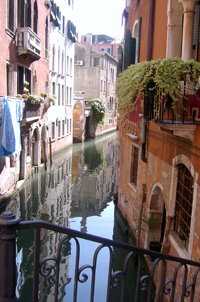 Each
of the six sestieri or districts of Venice has its own character – and
its own house-numbering system which applies to the whole district rather than
each street – and we particularly like to explore the Cannaregio, the
Castello and the Dorsoduro. Every time we do we find something we haven’t seen
before. (Last year my husband stumbled across the BBC filming Little Dorrit.) This year, in addition to the Arsenal, it was the delightful
piazza next to the unspoilt medieval church of San Giacomo del Orio in Santa
Croce and a row of classical-style busts of Africans, their heads carved out of
black marble, perched on top of a high wall behind the Dogana.
Each
of the six sestieri or districts of Venice has its own character – and
its own house-numbering system which applies to the whole district rather than
each street – and we particularly like to explore the Cannaregio, the
Castello and the Dorsoduro. Every time we do we find something we haven’t seen
before. (Last year my husband stumbled across the BBC filming Little Dorrit.) This year, in addition to the Arsenal, it was the delightful
piazza next to the unspoilt medieval church of San Giacomo del Orio in Santa
Croce and a row of classical-style busts of Africans, their heads carved out of
black marble, perched on top of a high wall behind the Dogana.
Every year, too, one of the great treasures of Venice re-emerges triumphantly from behind hoardings and scaffolding while another is shrouded up in preparation for restoration. We always used to admire the way the hoardings depicted the building behind them; it seemed a civilised way of allowing the work to go ahead as unobtrusively as possible. Not any more. The new mayor has decreed that they should be sold off for advertising so last summer, just as we were leaving, we saw the incongruous sight of vast adverts for cars (of all things! in a city of canals!) being plastered round the Bridge of Sighs. We had hoped this was a temporary desecration but this year they’ve given way to adverts for Coin supermarkets and Swatch watches, and the pernicious trend looks as though it is spreading to other sites too. The only appropriate response to such desecration is to boycott the advertisers and shame them into removing them. My campaign starts here!"
..............................................................................................................................................................................................
Sunday 16th August 2009:
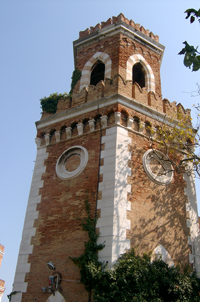
11.30pm - "A
perfect day. We all got up early
and took the boat to the Piazetta. From there we walked through the deserted
backstreets of San Marco and Castello, where a kindly Venetian, seeing us map
in hand, assumed we must be lost if we were wandering through Castello and
insisted on directing us to the Arsenal. As it happens, that was our
destination, but not, as he thought, because we wanted to see the Biennale
exhibitions of modern art, but because we wanted to see the Arsenal itself. In
all our years of coming to Venice we’ve never got beyond the twin brick towers
guarding its entrance as it is a restricted military zone. The Arsenal was the
powerhouse of the Venetian republic: it was where the great ships carrying
merchandise to and from every corner of the world were built and repaired. Its
size and technology were the wonder of medieval times. So, charming though it
was to see the towers and walls from the outside, just as Canaletto had painted
them, it was very frustrating never to get beyond them.
Today was our
opportunity – and how exciting it was, not least because it felt as
though we were doing something illicit just being there. Ignoring the exhibits
(difficult to tell sometimes whether they were meant to be art or just the
detritus left behind by workmen – though there was one clever piece
depicting sunbeams made out of long thin cages of golden filigree) we marvelled
at the sheer length of the old rope factory, with its balconied walkways up
above, the marble arches of the ancient docks which looked more like elegant
porticos than a working site and the huge waterways enclosed within the Arsenal
walls. It is astonishing that such an evocative place is left deserted and
semi-derelict: industrial architecture it might be (and I was proud to see an
innovative 19th century crane built by the Armstrongs of Newcastle
at the waterside) but it is still fascinating and has charms of its own. Unlike
the modern art displayed within its precincts.
After several hours of
exploration we were so exhausted that we had to return to the hotel for showers
and a rest, then back into Venice for an early dinner at one of our favourite
restaurants, Ai Barbacani, on the appropriately named Calle del Paradiso in the
Castello district. Tucked away in a backstreet, with a single balcony opening
on to a side-canal, it’s been family-run for over thirty years, serves
traditional Venetian food and wine and is (unusually for Venice) always
friendly and welcoming. And even more unusually for Venice, it’s also good
value, which is always a plus for a Yorkshire woman like me.
By 8.30pm we were sitting
in the Palazzo Barbarigo-Minotto on the Grand Canal, one of our discoveries a
couple of years ago. This is a private palazzo but it hosts several nights of
opera a week. Tonight we’ve chosen La
Traviata (again): just the three principals, Violetta, Alfredo and Germont,
with an orchestra of five, but each of the three scenes played out in a
different candle-lit room: a grand hallway, a salon and a bedroom. La
Traviata was premiered in Venice in 1853 and there’s something absolutely
magical about sitting in the intimate surroundings of the decaying splendour of
a palazzo listening to glorious music beautifully sung by professional opera
singers. (The intimacy can be a disadvantage when they hit the high notes at
full pelt when they are literally just a couple of feet away from you!)
To end a perfect day we
wander out into the warm night air and head for San Marco for a night-cap at
one of the cafés. What could be better than sitting in the piazza, with your
back to the Napoleonic intrusions, looking up at a flood-lit basilica and
Doge’s Palace, drinking a glass of Bianco di Custoza, listening to the
orchestras and imagining the crusaders in exactly this same spot in 1204?"
...............................................................................................................................................................................................
Wednesday
12th August 2009:

7am -"Just a few days later and here I am again, sat on
a terrace in the warm sunshine enjoying the peace and quiet before the bustle
of the day begins. This time, however, I’m over a thousand miles away, on the small
terrazzo of our hotel: on one side of me is the white marbled facade of the
church which once served the community on this little island; on the other is
the wooden jetty, bobbing up and down between its distinctive red and gold
striped mooring-posts. From here I have a perfect view of the panorama of
Venice unfurled like a painted backdrop from some fairytale theatrical
production across the calm green waters of the lagoon. There is always a sense
of unreality in Venice and never more so than seeing it like this – through
a trick of perspective it seems so close as to be almost within arm’s reach and
all the most famous buildings are lined up in a neat row as if there were no
canals between them. Looking from left to right I can see the massive red bulk
of the Redentore church with its white-capped dome and towers on the Guidecca,
the upper storeys of the square facade and the red roof of the Ca Grande on the
Grand Canal, the leaning tower of Santo Stefano, the high green pyramid that is
the roof of the newly rebuilt Fenice theatre; then, in solitary splendour with
a ruff of trees hiding its lower reaches, the perfectly aligned and symmetrical
Palladian domes and towers of the Salute church; the campanile in San Marco,
surmounted by its golden angel, soars above the centre, dwarfing the domes of the basilica which, even at
this distance, strike an exotically eastern and foreign note in this extraordinary
cityscape; finally, rising as if out of the trees that fill the abandoned
island of La Grazia, I can see the dome and campanile of San Georgio and the
pinnacle of the campanile of San Francesco della Vigne.
At
this hour the water-taxis and Venetian boy-racers are not yet tearing across
the lagoon, sending plumes of water and the booming reverberations of engines
in their wake. The only sounds – for the moment – are the bells
calling people to mass, the piping of oyster-catchers and the occasional smack
of a leaping fish returning to the water. It is, I now realise, low tide and an
elderly fisherman who has been toiling continuously out in the middle of the
lagoon has rowed over to within just a few feet of where I am sitting. Like all
Venetians, he rows his wooden boat standing upright, with his hands crossed and
pushing the oars forwards, a method which seems bizarre to English eyes but is
efficiently fast and has the advantage of allowing him to see where he is
going. He is so intent on his task that he completely ignores my presence,
putting down his oars to drift with the tide and pulling out his net, which he carries
carefully folded into a bucket, he drops it length by length into the water.
When he reaches the end, some twenty or thirty yards away, he rows back to the
beginning and then, to my surprise, allows the boat to drift back again while
he uses the flat of his oar to strike the water, splashing noisily to drive the
fish into his net. He’s successful too. Though I don’t like to stare (and am
assiduously doing my counted-cross-stitch as a cover for my snooping) I can see
that he has pulled in at least eight decent sized fish just in the short
stretch of water in front of me. As I watch him take up his oars once more and
row off into another part of the lagoon to begin his task again – never
once having acknowledged my presence any more than I have his – I feel as
though I have witnessed a ritual which has likewise refused to acknowledge the
advances of modern technology. My fisherman is a timeless figure. Had it not
been for his clothes, his plastic bucket and nylon net, I might easily have
mistaken him for a figure from a Canaletto or a Carpaccio. It is this blurring
of past and present which makes Venice such an evocative place for me. I first
came here as a student on a gap year over twenty years ago. I fell under its
spell then and I remain in its thrall today."
................................................................................................................................................................................................
Saturday 8th August 2009:
"
I have always been an early riser but for
the last few months I’ve been getting up between 4 and 5am to work a fifteen to
twenty hour day in order to hit the deadline for delivering the manuscript of
the American edition of my latest book Conquest.
I succeeded with a week or so to spare but since then I’ve been busy with the
copy edit and proofs of the UK edition, so I’ve been finding it hard to break
the habit of getting up early. Seven am therefore found me sitting on the
terrace in front of our house being reminded why this is usually my favourite
part of the day. I’ve already done all the household tasks – let out and
fed the four chickens (named by my daughter Artemis Fowl, Buffy the Worm
Slayer, Princess Leia and Peccadillo), made bread, put a wash on and all the
other boring but necessary chores – and now I’m enjoying the luxury of
drinking coffee and eating incomparable English plums in the pleasant warmth of
a perfect summer day. Above the trees I can see the heather just beginning to
turn purple on the hills and a great arc of cloudless blue sky. I can hear the
beck running in the valley bottom, the clock on the church tower striking the
hour and the bees humming among the flowers in the borders. Already I can catch
the scent of roses: by mid morning, when the sun will be too strong for me and
I will have retreated into the shadows, the air will be heavy with their
perfume. For the first time in over a year I have no pressing deadline to meet
and no books I have to read for my work so I intend to enjoy the rare treat of
reading a novel."


